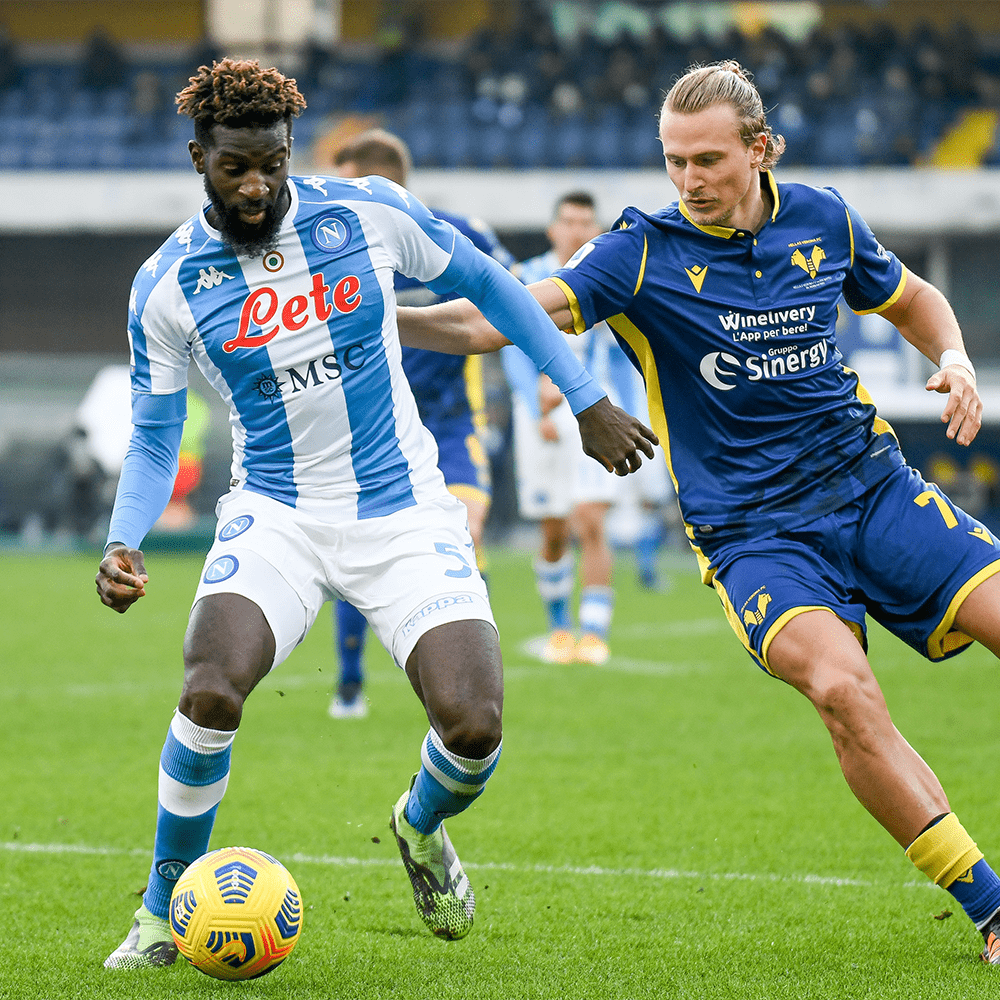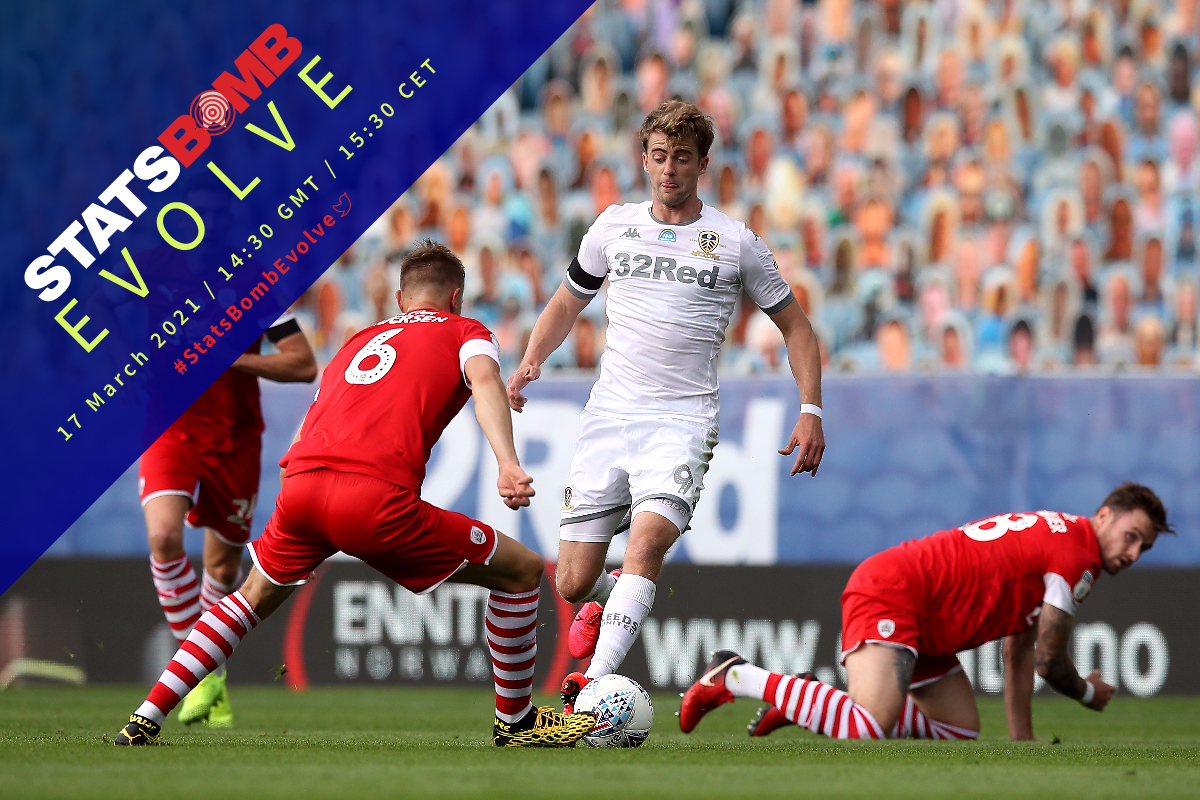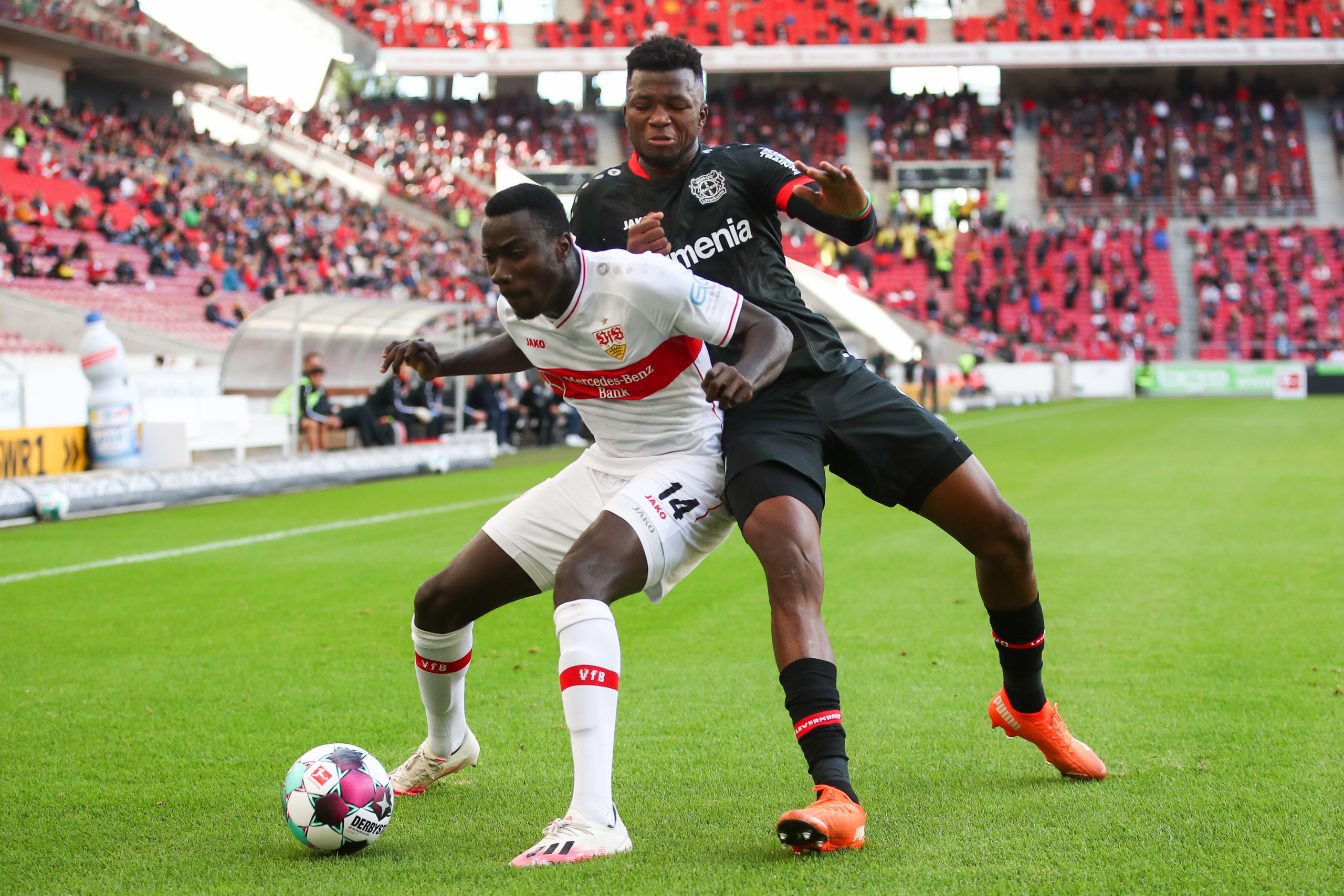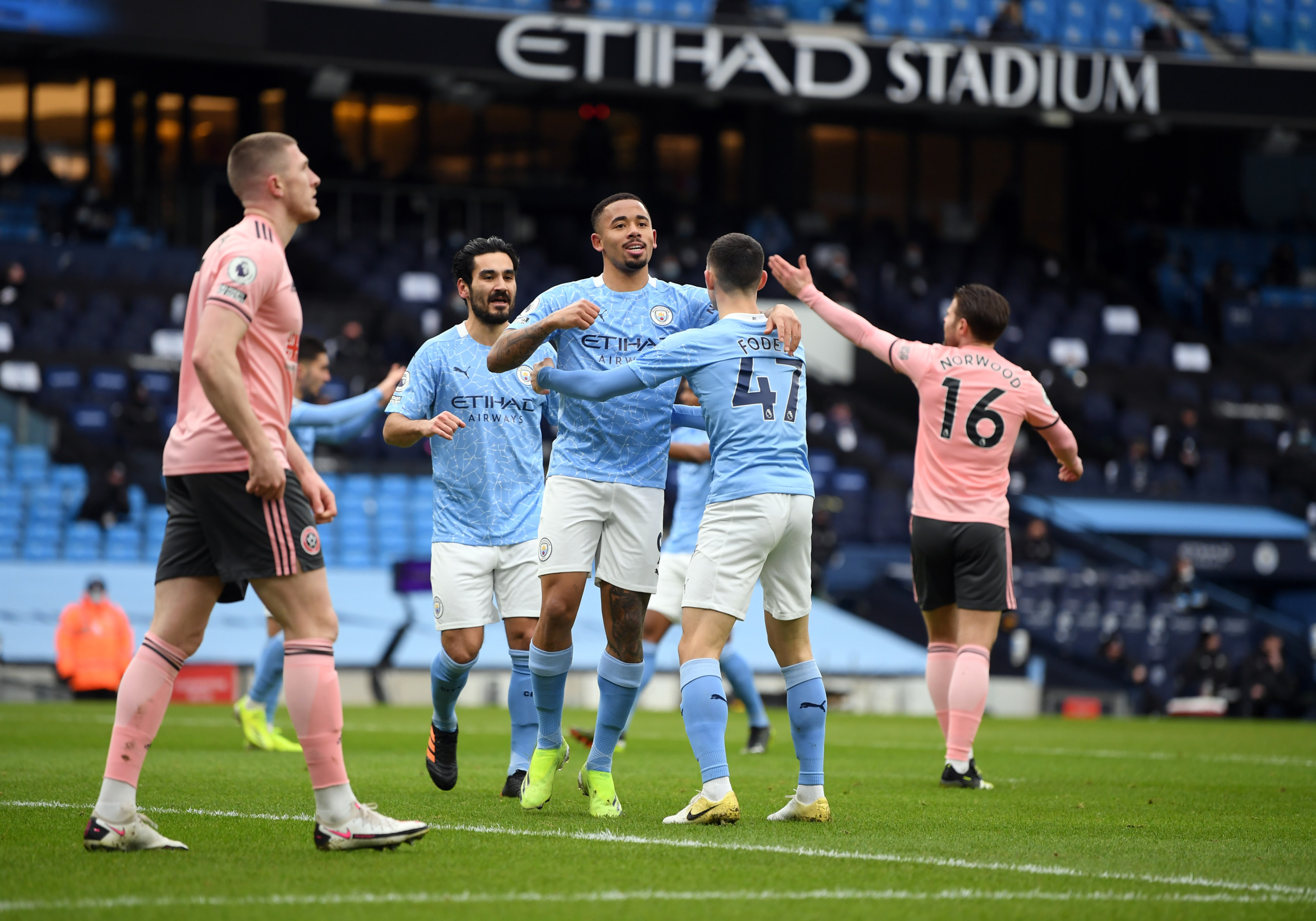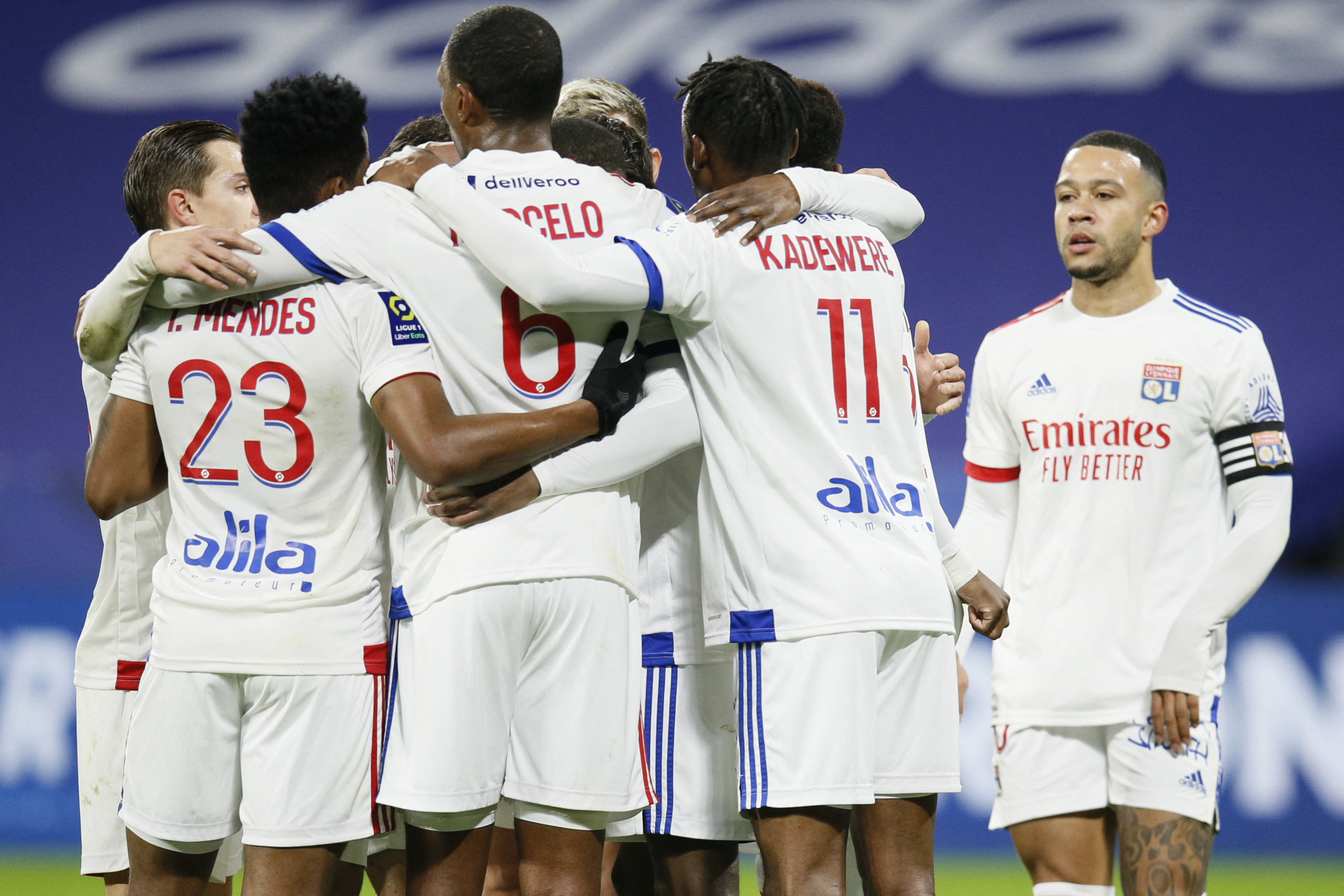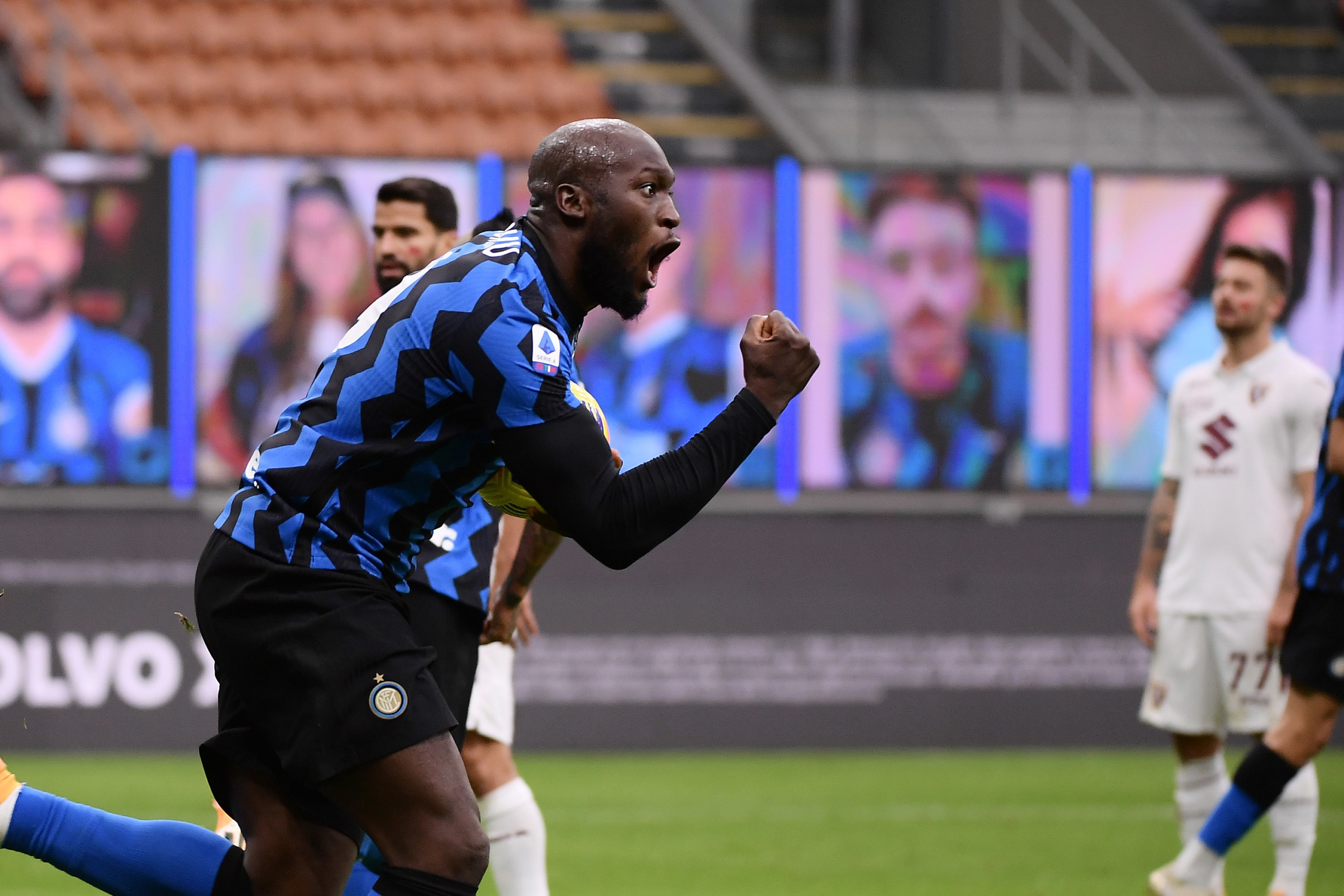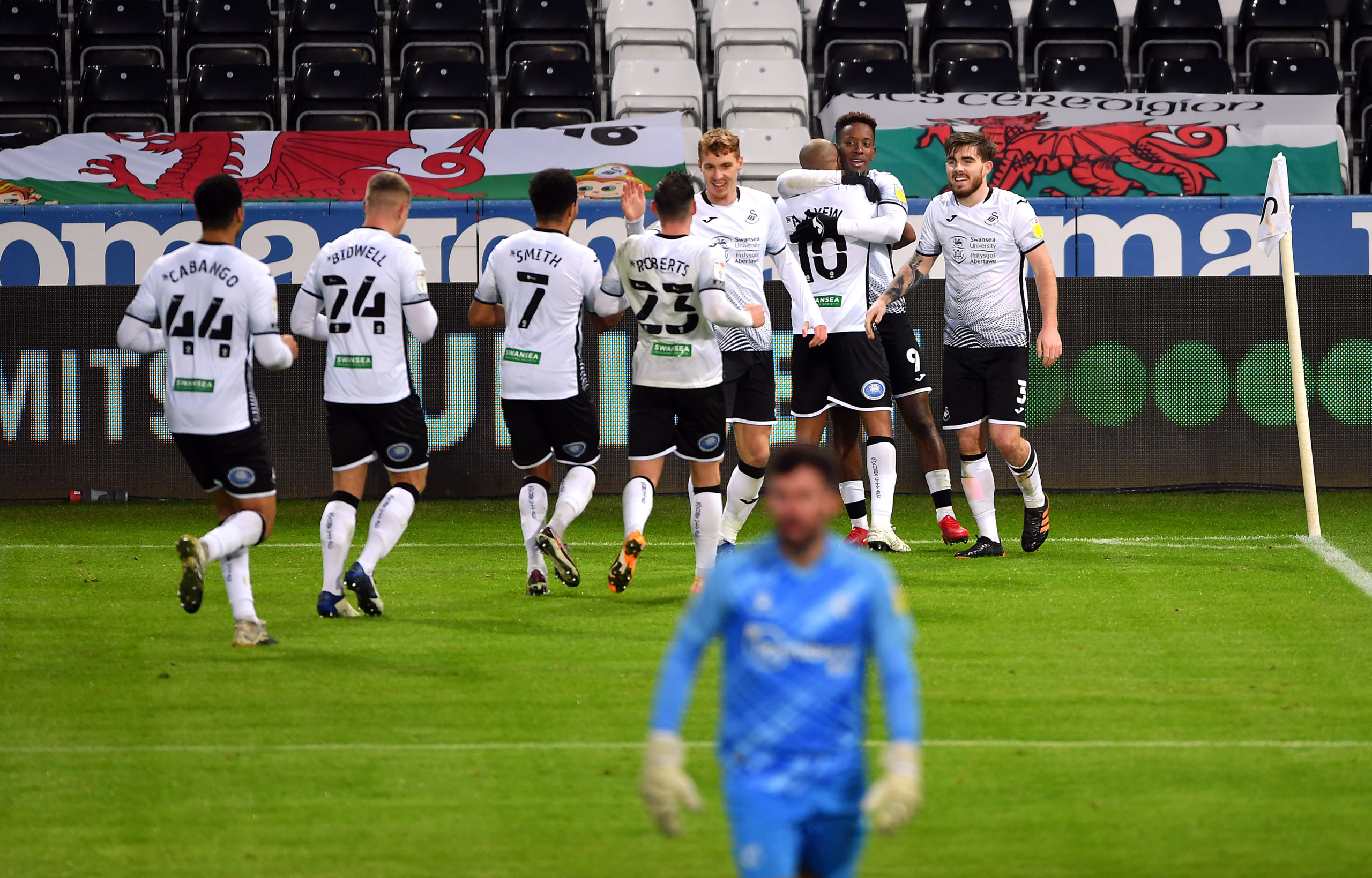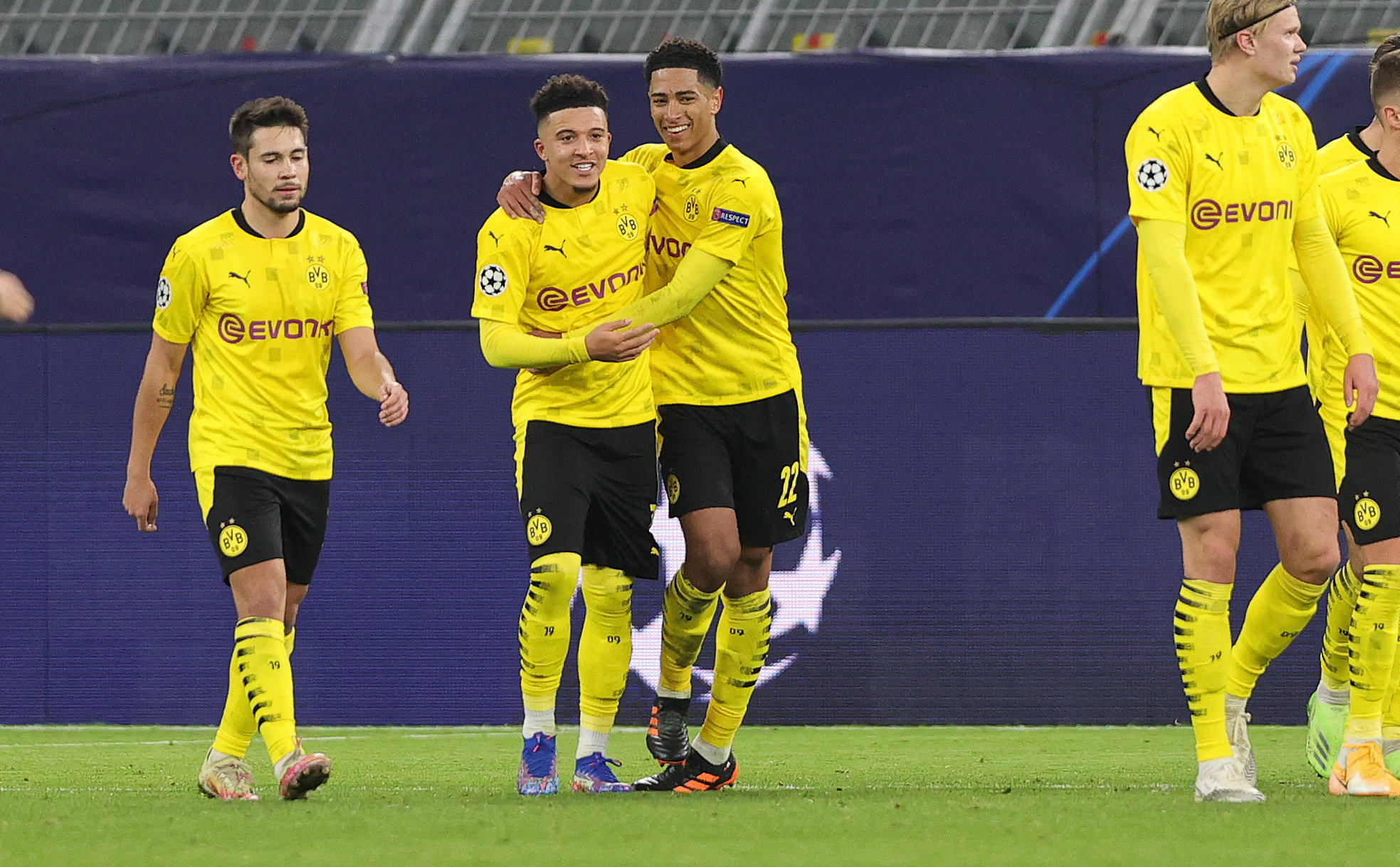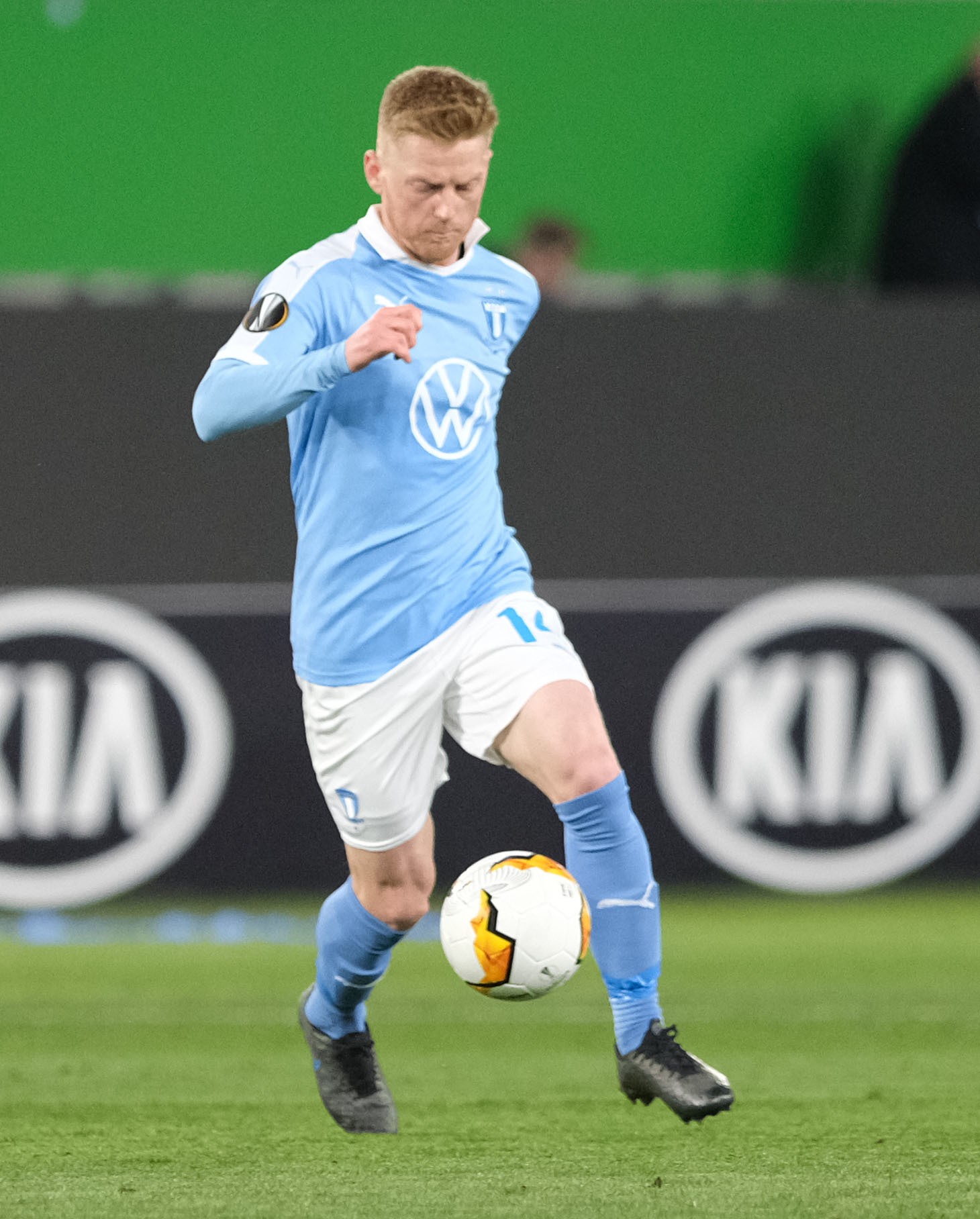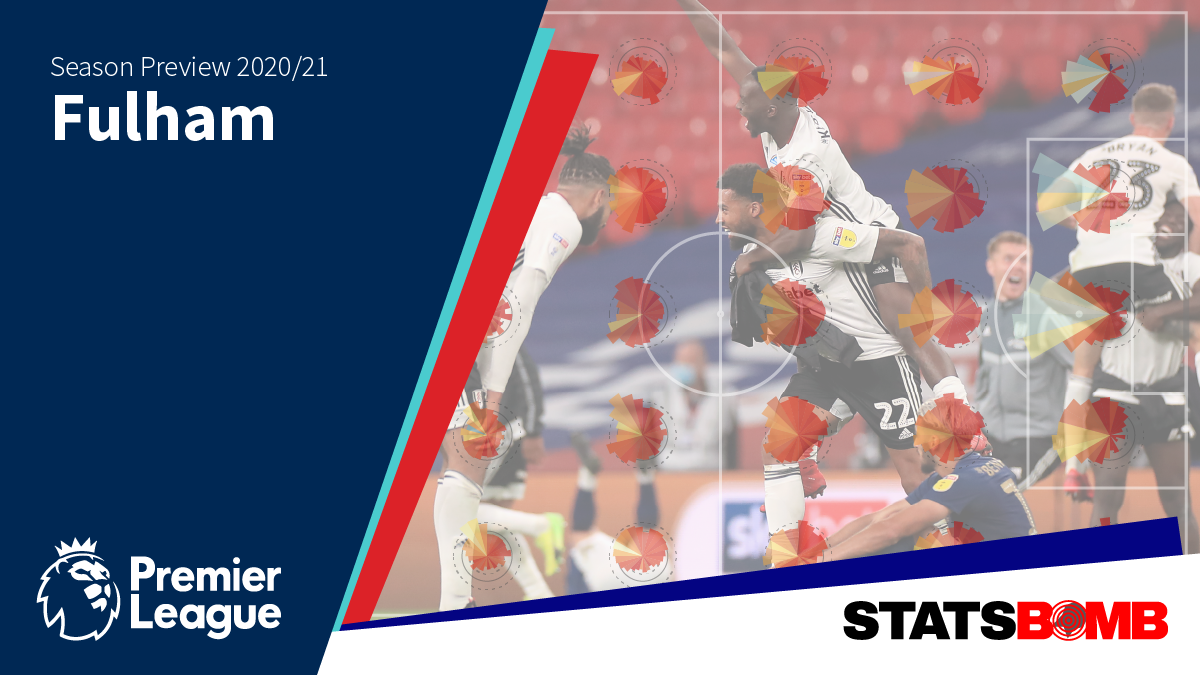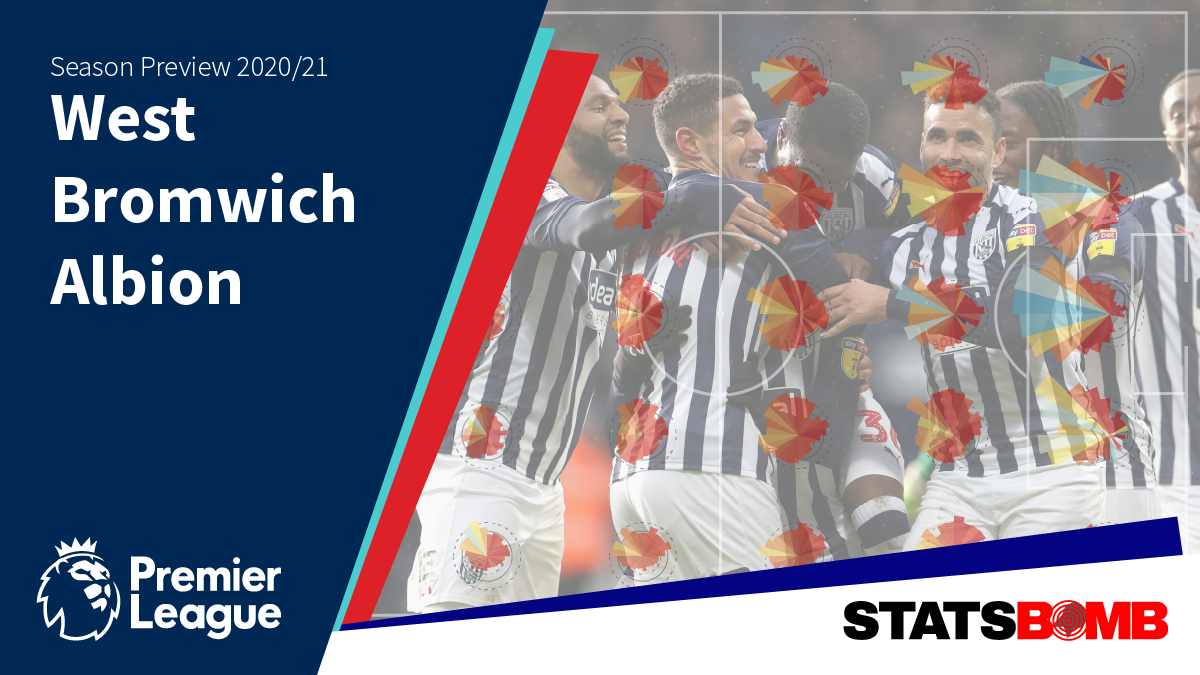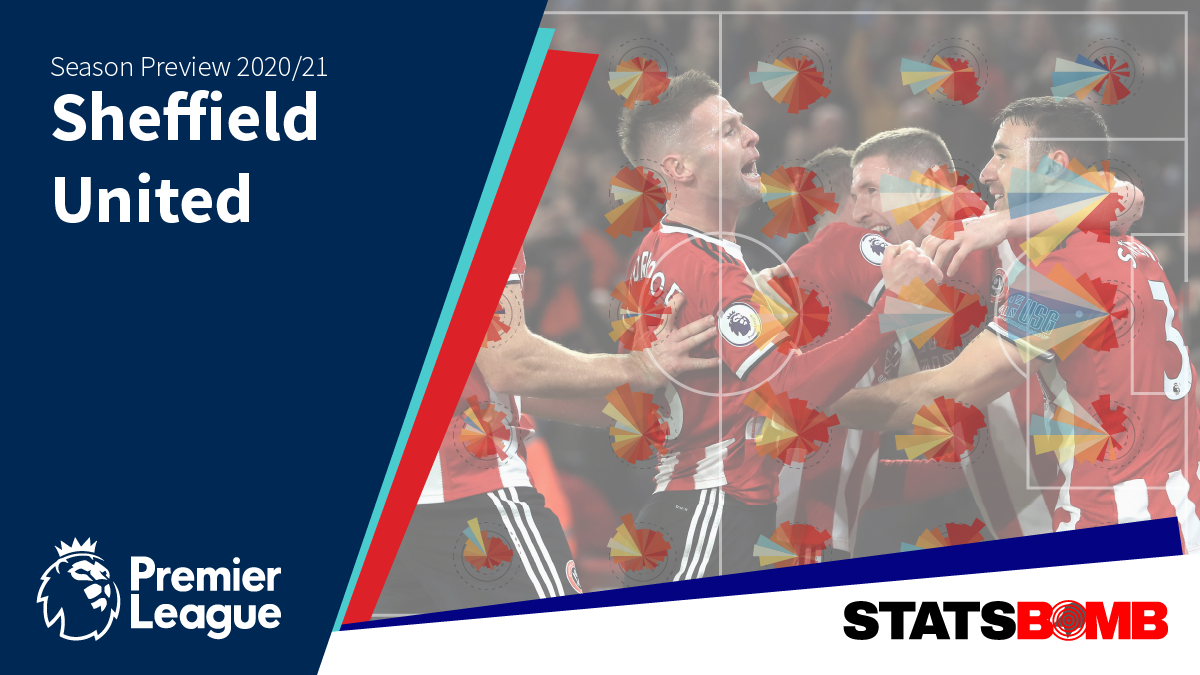Author: Oliver Walker
StatsBomb Data Case Studies: Pressures
As football fans, we all know how exciting it can be to see a team close in on their opposition, hunting the ball as a ferocious collective, and seeing the composure visibly drain from the team in possession. We know what this looks like on the pitch, but what does it look like in the data? Time to investigate what contrasting out-of-possession approaches look like using StatsBomb’s pressure data.
On March 17th 2021, we will bring you the latest innovations to come out of StatsBomb at our free online event StatsBomb Evolve, including upgrades to our current dataset and the launch of our revolutionary new data product StatsBomb 360. In the build up, we’re looking at some of the unique data points that already make StatsBomb Data the clear best in the industry, and the obvious choice for smart clubs and analysts.
Given the topic, it would be different-for-different-sake to ignore Leeds. Combining chaos and coordination, Marcelo Bielsa’s approach to defending without the ball has drawn admirers for many years for its aesthetic, intensity, and its utility.
In a season where teams across the world are looking to conserve energy just to survive the condensed fixture schedule, Leeds have barely taken their foot off the gas, continuing to press and engage the opposition all over the pitch. Wherever the ball is, Leeds are going after it.
We knew that adding pressure data to our data specification back in 2018 would introduce significant context that was previously missing when evaluating a team’s approach out of possession, allowing for a deeper level of analysis and a more complete picture of the game. For example, here’s Leeds’ defensive activity map this season, relative to the rest of the Premier League, without pressures included:
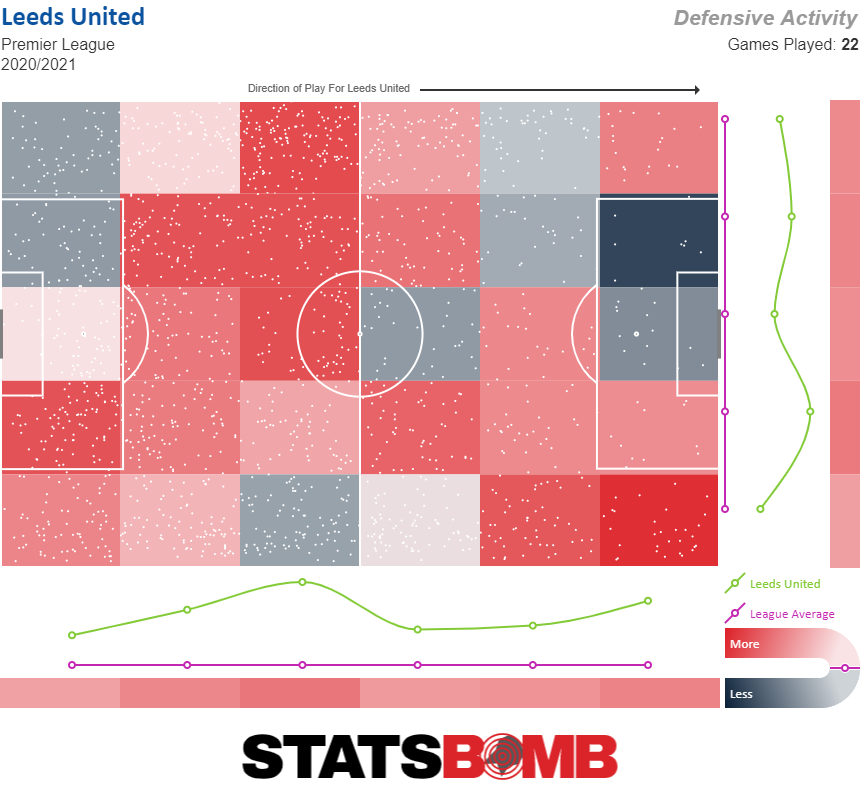
As you can see, it would suggest that Leeds are fairly active off the ball, but not significantly more than other teams in the league, particularly in the opposition half where they appear to be a shade above average.
Including pressures tells a different story.
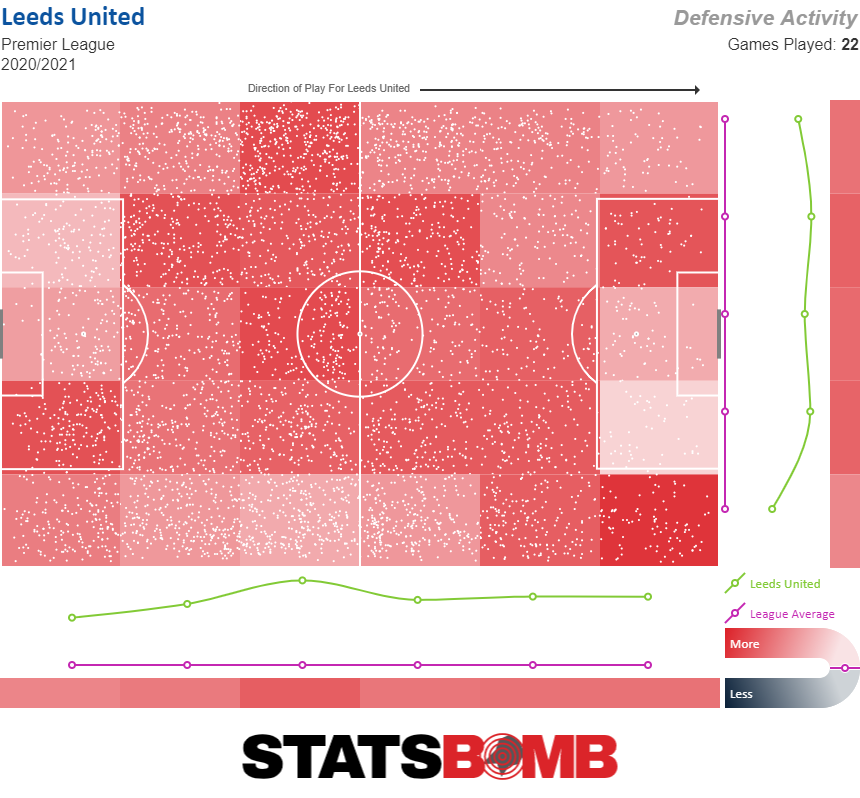
Now we can see an accurate reflection of just how active Bielsa’s side are out of possession.
The intensity of their approach to getting the ball back is a major outlier in the Premier League. There are plenty of other pressing sides but none quite like this, both in terms of the volume of pressures they’re applying but also the sheer number of turnovers they’ve forced the opposition into as a consequence.
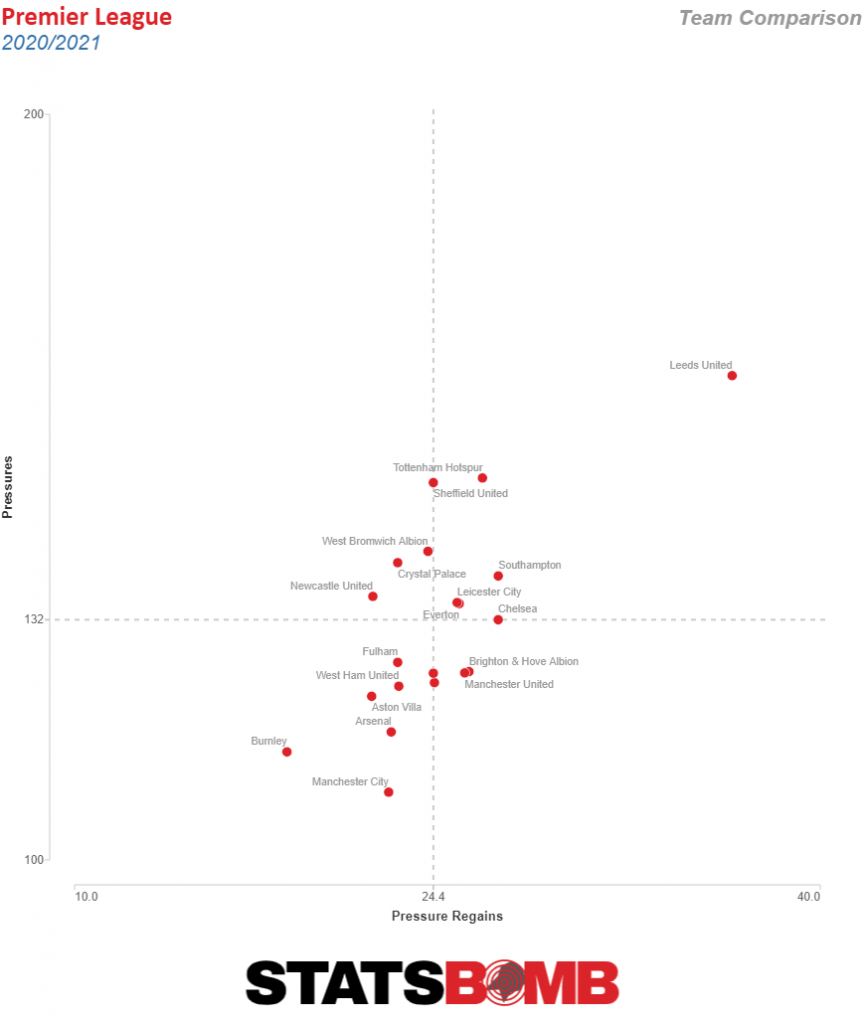
It’s quite literal to say that you barely get two seconds on the ball when playing Leeds. Nearly 1-in-3 of their opponents’ pass receipts are pressured, fouled, or tackled within two seconds of receiving the pass, as measured by their Aggression %.
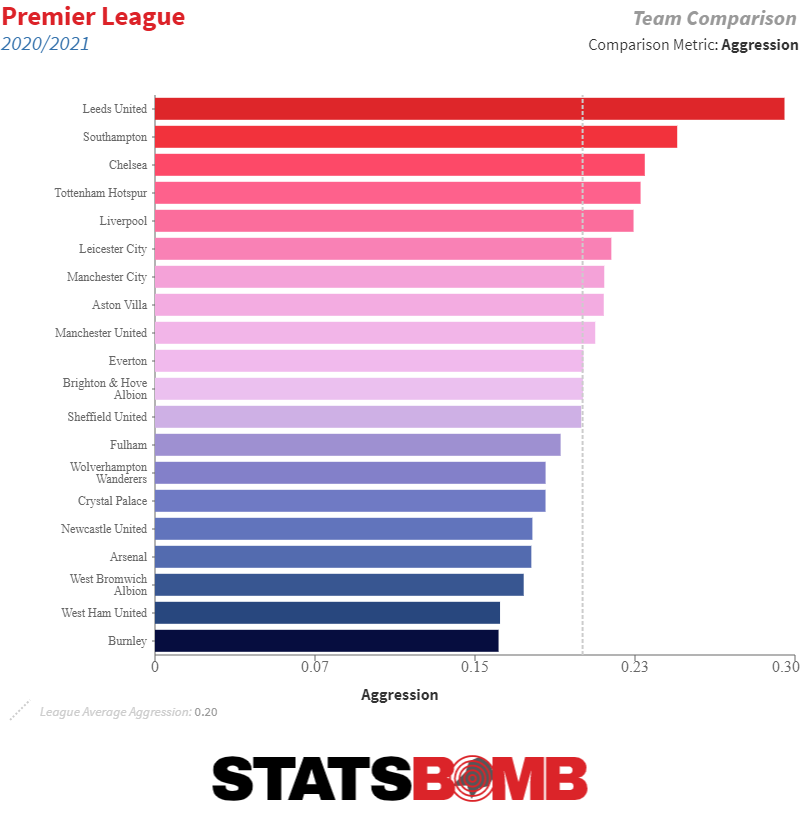
You can imagine what it must be like as an opposition player when you barely get a moment to pick out a pass before a white shirt arrives, charging in to try and turn the ball over. And turn the ball over they do - Leeds’ opponents have the worst pass completion % in the Premier League.
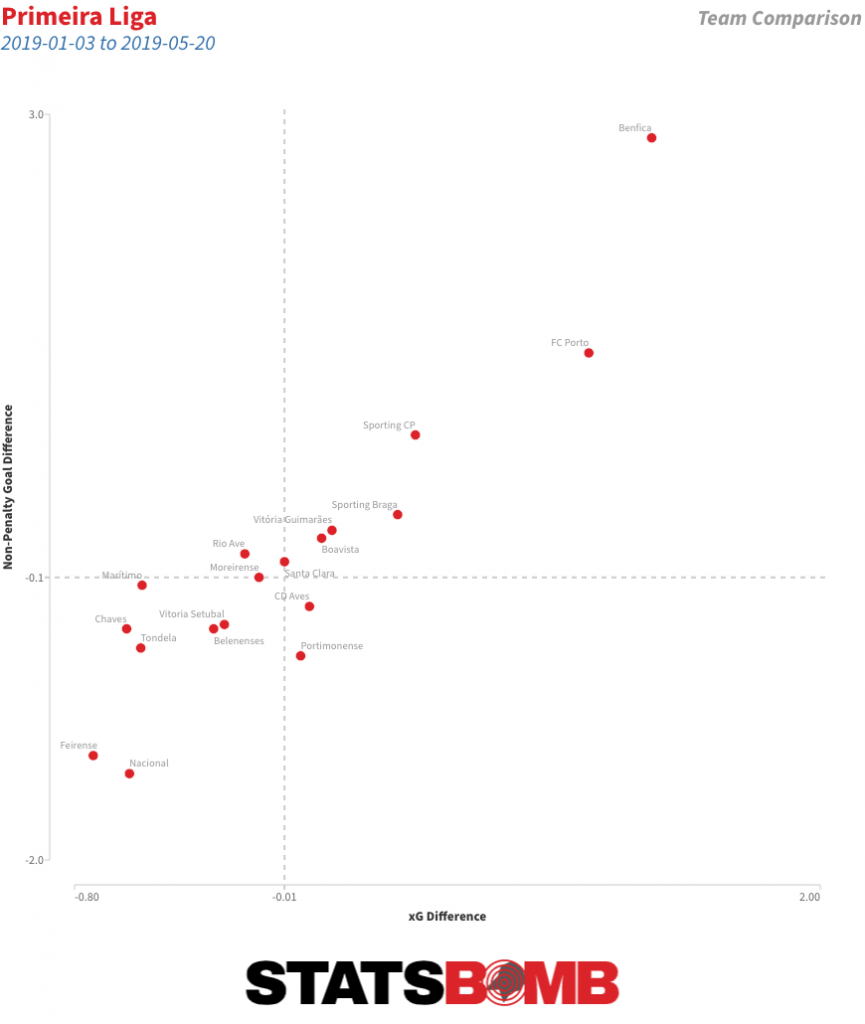
The beauty of a well-executed press isn’t just in forcing the opposition away from your goal, though, it has attacking advantages as well. Leeds have the most High Press Shots in the league: shots generated within 5 seconds of a turnover of possession.
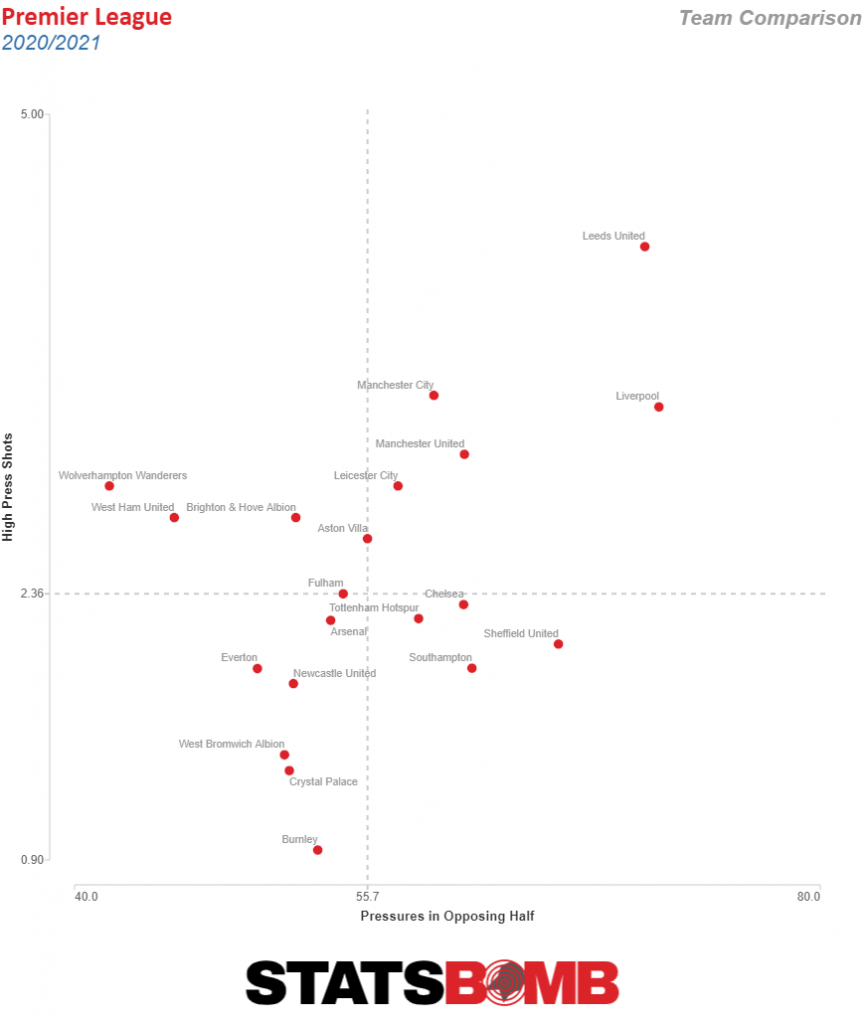
There are some drawbacks. Such a cavalier approach has led to Leeds being a slight outlier at the other end of the pitch. Inevitably the opposition have to come up with a method of beating or playing through such heavy pressure somehow, and it seems they've found most success on the break.
Committing so many bodies forward as both an attacking and defensive measure naturally leaves spaces to attack, and Leeds' man-to-man approach out of possession leaves vulnerabilities should their player not win their 1v1. A combination of beating them on the dribble and then attacking the space seems to have been the most effective way of combating Bielsa's press so far.
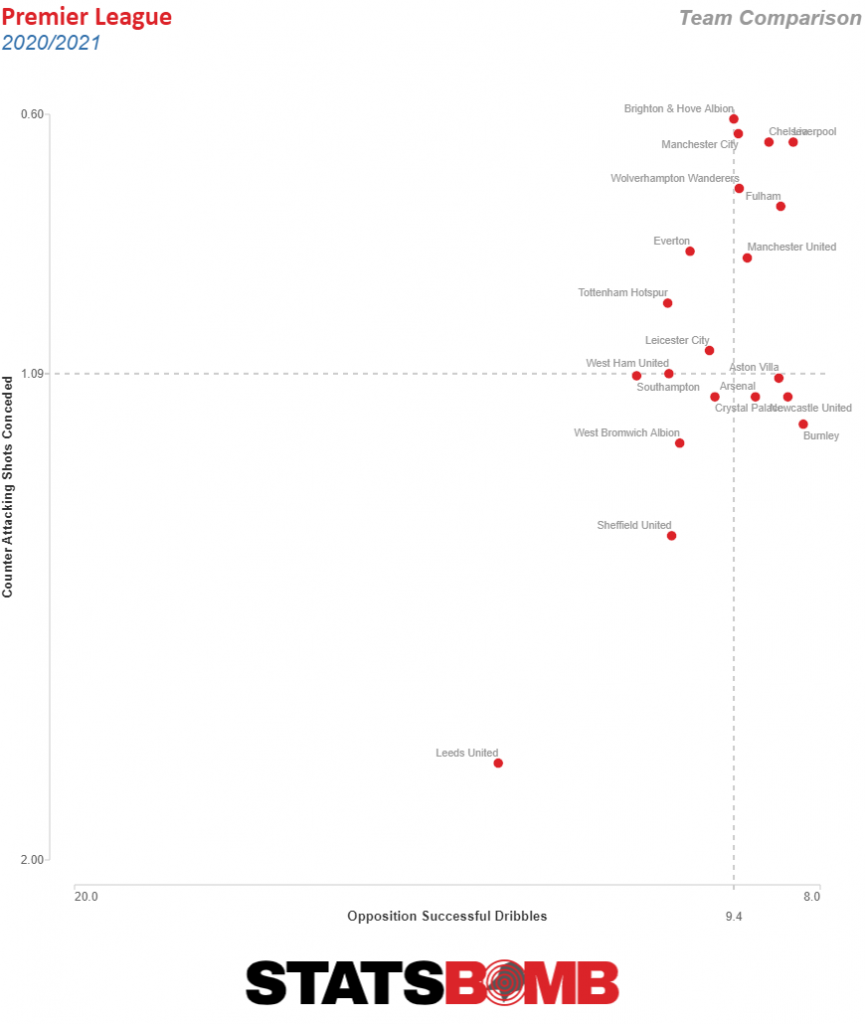
But, with the side comfortably midtable in their first season back in the top flight, it’s inarguable that Bielsaball is leading to net-positive results.
Taking a different approach to their work off the ball is Burnley and Sean Dyche.
The Clarets have earned a reputation for being one of the best-drilled sides in the Premier League and their game plan out of possession is without doubt the predominant reason they’ve been able to establish themselves in midtable. Burnley had the ninth-best defensive record last season by goals conceded, and the seventh-best by xG conceded.
Given their notoriety for favouring a low block 4-4-2, you might be wondering why they’re featuring in an article about pressing. The reason? It’s where they decide to apply pressure, and the effectiveness of the block as a whole, that’s most interesting.
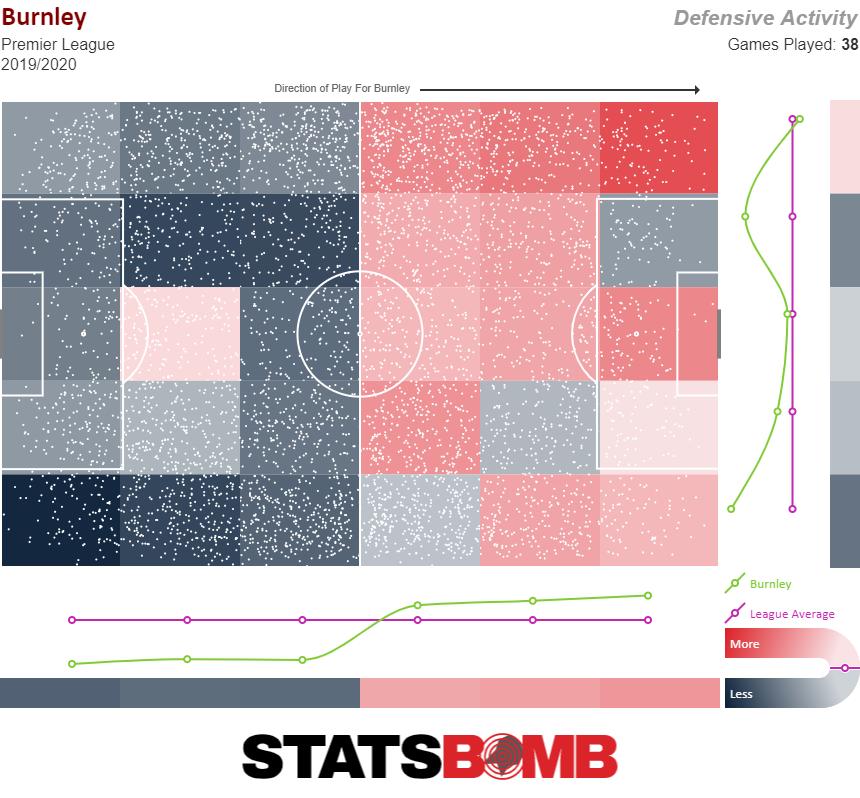
Essentially, Burnley run a specific press based on where the ball is.
From opposition goal kicks, Burnley squeeze right up and put their two forwards on the opposition defensive line, hoping to force the long ball where they know James Tarkowski and Ben Mee can win the aerial ball.
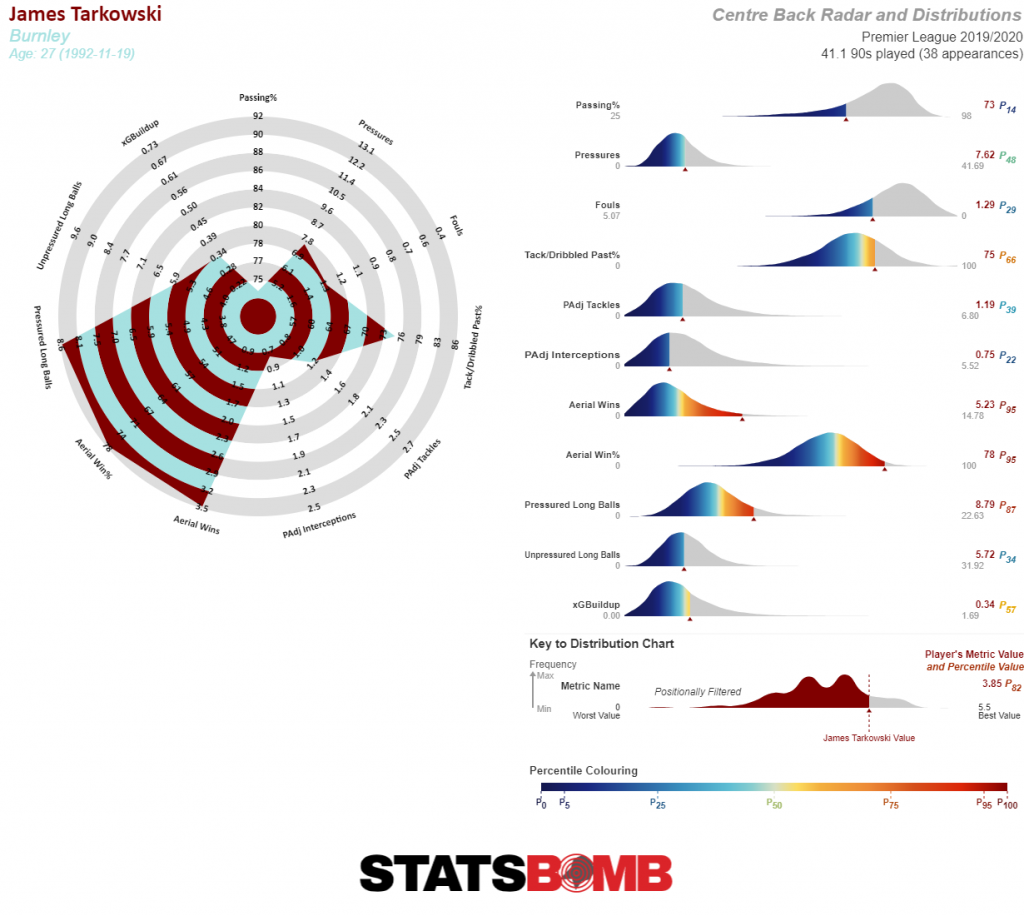
The plan is to have squeezed the play so much that a Burnley player will get on the second ball from the aerial duel, or squeeze the opposition should they get on the possession. Burnley averaged 75 pressures in the opposition half per game in 2019/20, sixth-most in the Premier League, and as a percentage of their total pressures it ranked third.
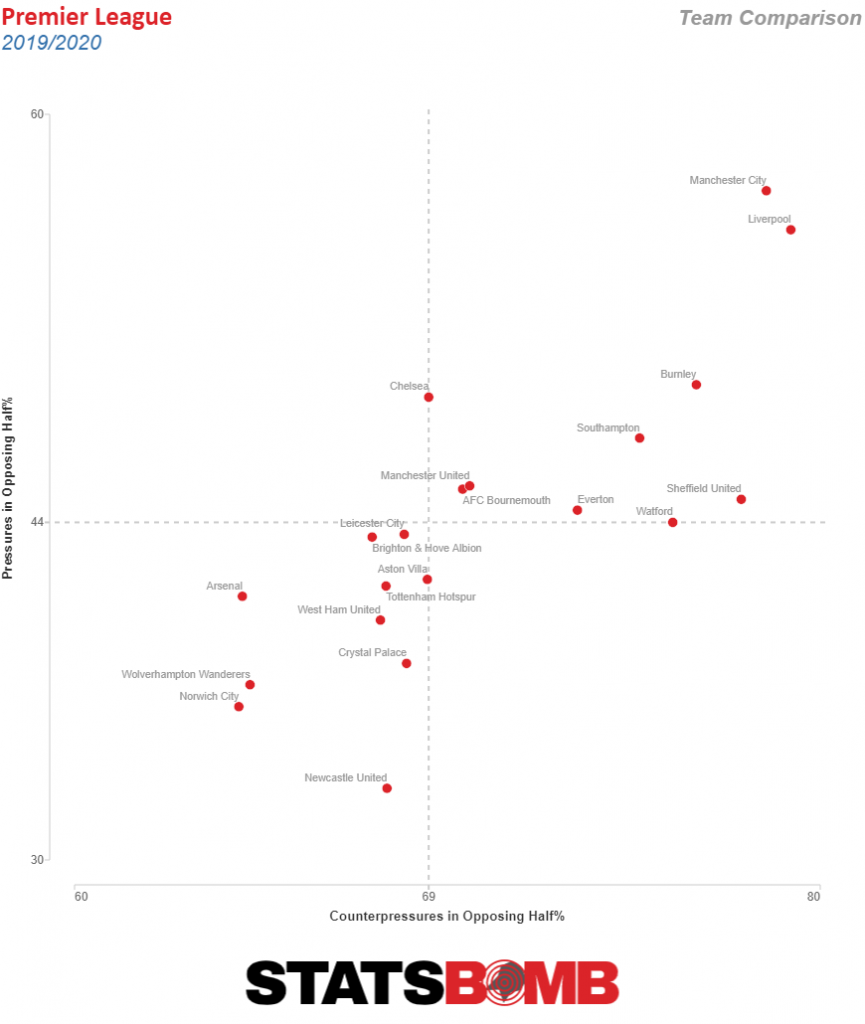
It’s only once the opposition have advanced into their half that Burnley form their infamous block, keeping spaces tight between the lines and forcing the opposition to try and play around them, rather than through them.
The success of their block is highlighted by how difficult their opponents found it to get into their defensive territory. Despite their opponents having most of the ball - Burnley ranked 19th for possession % - their opponents were only able to progress into the final third with 39.6% of their possessions that started outside it, the 8th-best rate in the league. Thou shall have the ball, but thou shalt not enter their defensive territory.
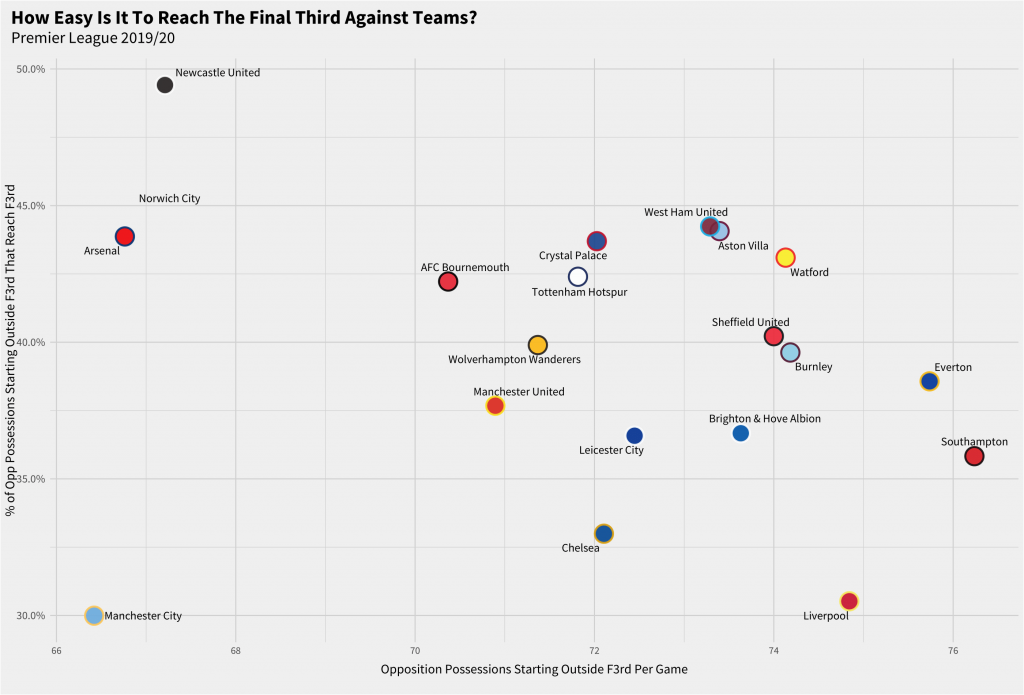
Should the opponent succeed in reaching the final third, the Clarets excelled at preventing them from creating quality opportunities, often applying pressure to the shooter or reducing the area of goal the shot-taker was able to aim for to hamper the chances of scoring.
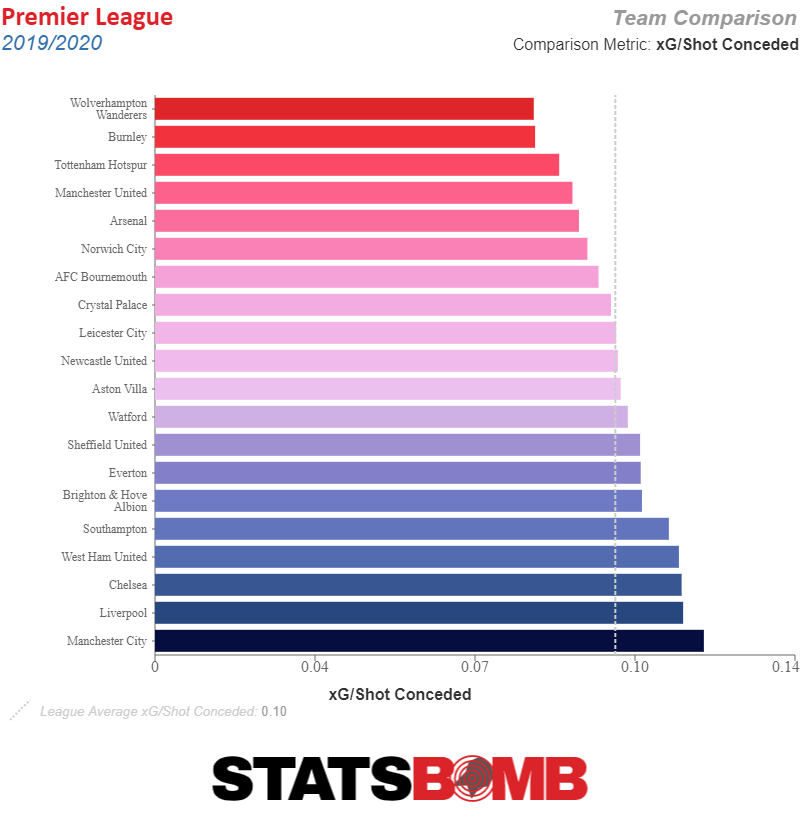
Two different approaches to out-of-possession, chaos and intensity versus immovable block, but Burnley and Leeds continue to succeed in their contrasting methods of press.
Join us at StatsBomb Evolve on March 17th 2021 to discover how we're going to change the football industry, including the launch of our new data product, StatsBomb 360. To find out more, click here.
Bundesliga 2020/21 Mid-Season Review
Our final look at the major European leagues sees the German Bundesliga come under the spotlight. Talk of a Bavarian behemoth, a alliterative forward winning with Wolves, hard-pressing Hütter, and sorry Schalke 04.
On the back of a Bundesliga, DFB-Pokal, and UEFA Champions League treble, Bayern Munich continue to meet their lofty standards.
On course for yet another 80+ points haul, the juggernaut continues to plough a furrow through the Bundesliga, but there are some curious trends in their performance levels this season. Bayern aren’t swatting teams aside with the ease and comfort that we’ve come to expect of them - their xG difference of 0.64 per game is their lowest since 2016/17.
Their 15-game expected goals trendline since the start of the 2018/19 season illustrates the fact that they haven’t quite been at their imperious best so far this campaign.
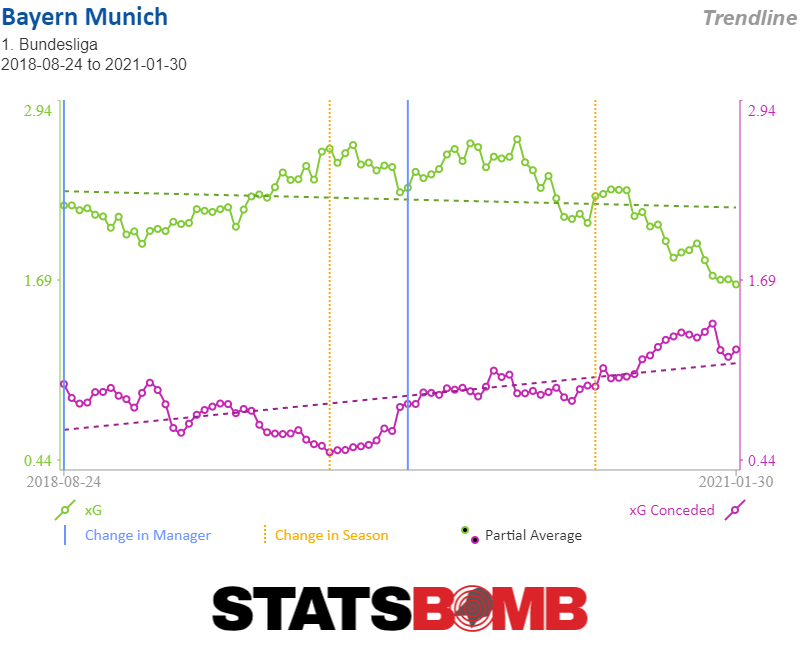
The 26 goals they've conceded already is only six shy of the 32 they gave up in the entirety of 2019/20. There was even a six-game spell between FC Köln on October 31st and Union Berlin on December 12th inclusive that Bayern didn’t “beat” their opponents on expected goals – in each of those six matches the opposition created the more dangerous opportunities.

But FCB didn’t lose a single one, claiming three wins and three draws from their “wobble”. Since then, they’ve flexed their muscle and performances have improved in line with a commanding haul of 21 points from the next eight, a run that has seen them pull clear at the top.
RB Leipzig are looking to go one better than last years third-place finish and their metrics look sufficiently strong to support them, but it's below them where chaos starts to ensue: just three points separate Wolfsburg in third and Borussia Mönchengladbach in seventh.
Wolfsburg, who had to win the Bundesliga relegation/promotion play-off match two seasons in a row between 2016-2018 just to stay in the league, are currently on course for their highest finish for six seasons and Champions League qualification. Big Wout Weghorst - to give him his full name - is having his best goalscoring season in the green of Die Wölfe. He's behind only Robert Lewandowski for non-penalty goals with 11.
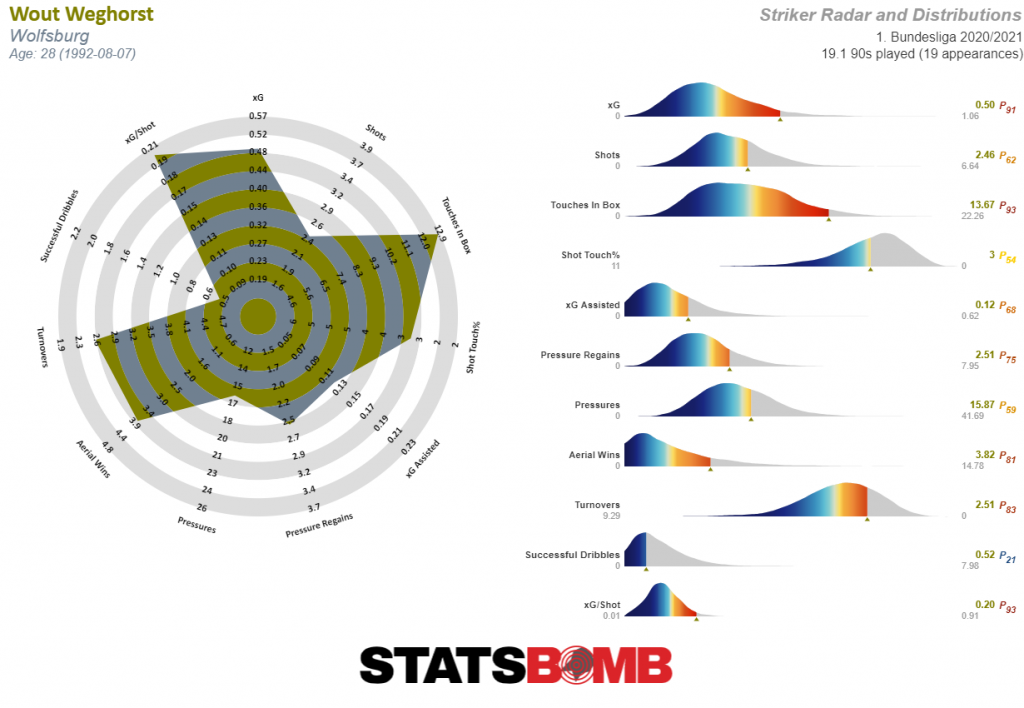
At the other end of the pitch, goalkeeper Koen Casteels is on course to concede fewer goals than expectation for the fourth season running, with the best Shot Stopping % in the Bundesliga this season (Save % - xSave%).
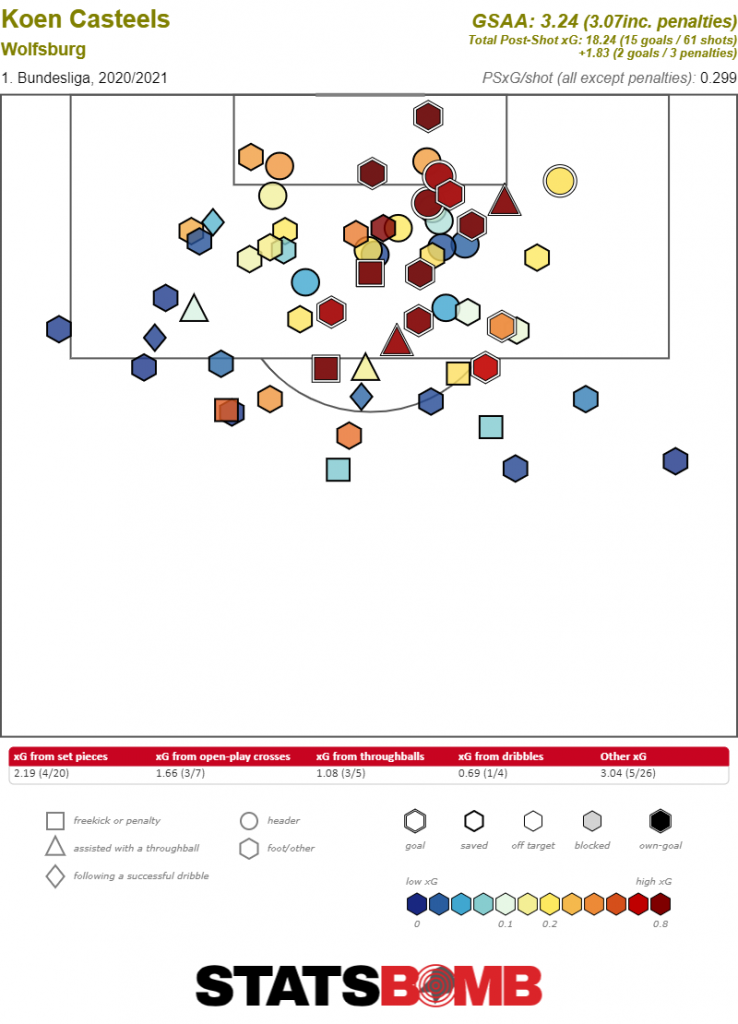
Another team gunning for a rare Champions League qualification is Eintracht Frankfurt, who haven’t qualified for the premier European competition since they lost the 1960 final to Real Madrid (when it was known as the European Cup). Right now, they're in position to break that duck.
You know what you’re going to get with an Adi Hütter side. The ex-RB Salzburg and Young Boys coach has again instilled an aggressive press into his team, one that’s proven effective as Frankfurt currently sit fourth in the table, having lost just two of their 19 games.
No other side in the league engages the opposition as regularly as Frankfurt: their Aggression % - the portion of opponent’s ball receipts that are tackled, fouled, or pressured within two seconds - is the highest in the Bundesliga at 24%.
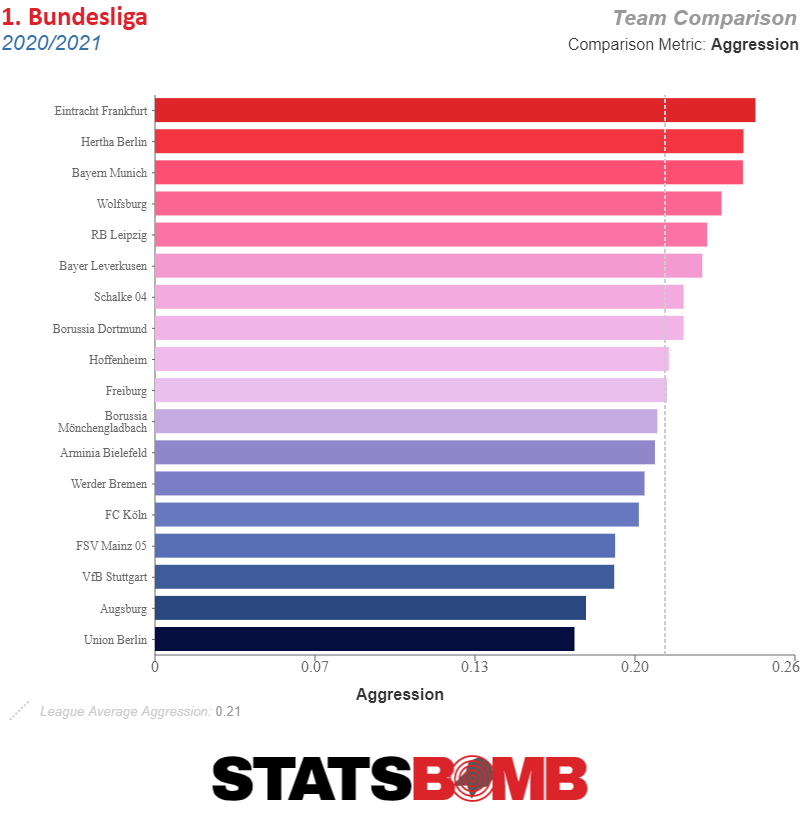
Andre Silva, like Weghorst, is having his best Bundesliga season yet, but it’s supplier-in-chief Daichi Kamada who’s providing the chances for the Portuguese forward. Kamada, who top-scored himself for Frankfurt in 2019/20, is behind only Thomas Müller and Marco Reus for xG assisted from open play.
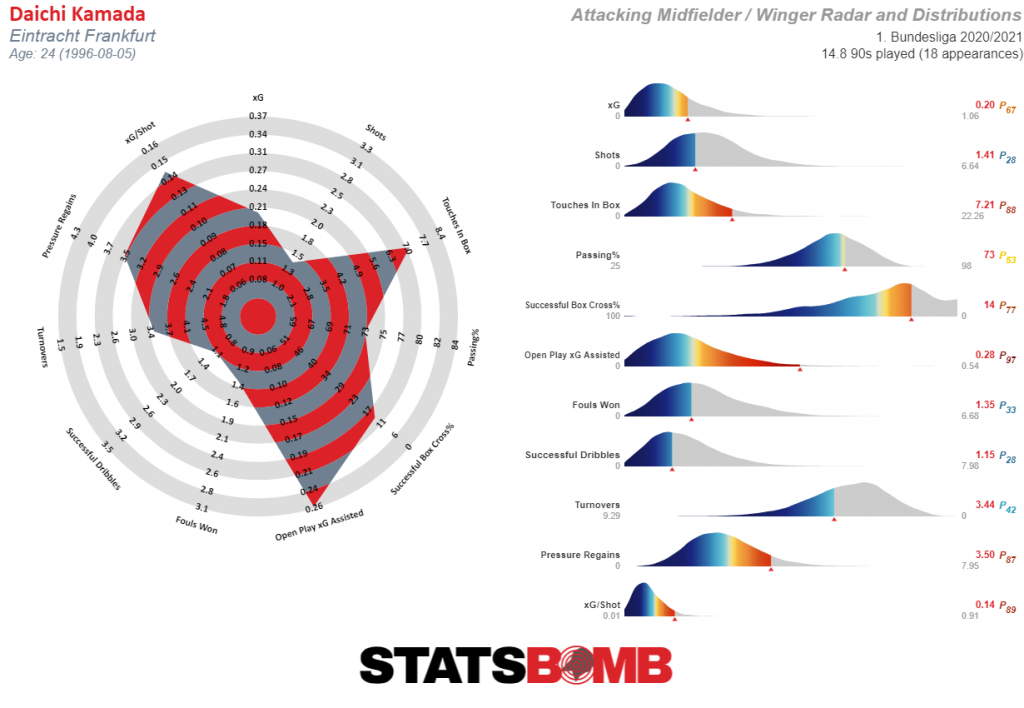
Meanwhile, the irony will not be lost on long-term followers of football analytics discourse for the way that Lucien Favre lost his job at Borussia Dortmund, on the back of some pretty large underperformance on their expected goals.
Favre's teams were notorious for outscoring the performance metric, but this season it came unstuck and Dortmund currently languish in sixth place despite having the strongest expected goal difference this campaign.
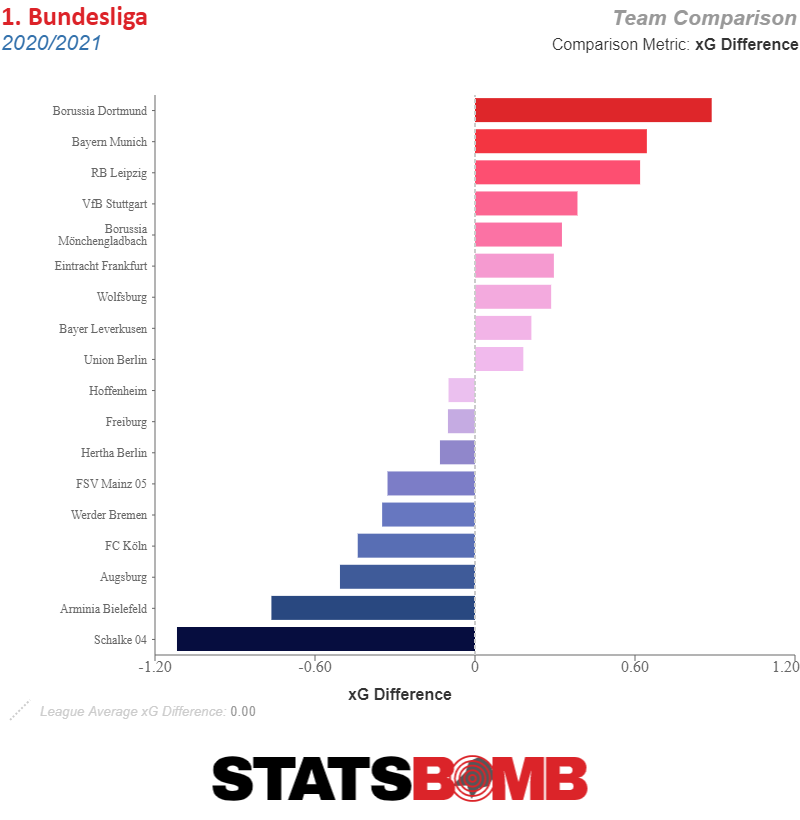
At 37.5 xG, which happens to be the same as Bayern’s, their chance creation in attack has been the best in the Bundesliga, but where Bayern have scored 51 non-penalty goals from their 37.5 xG, Dortmund have finished bang on expectation, scoring 37 times. They haven’t been able to match this in defence, conceding 25 non-penalty goals from 19.6 xG.
Despite a strong start, going 5-0-1 in their first six games, the five games that followed cost Favre his position as Dortmund won just once. His last match was a heavy home defeat to VfB Stuttgart - there was no ambiguity over who deserved the result on that day.
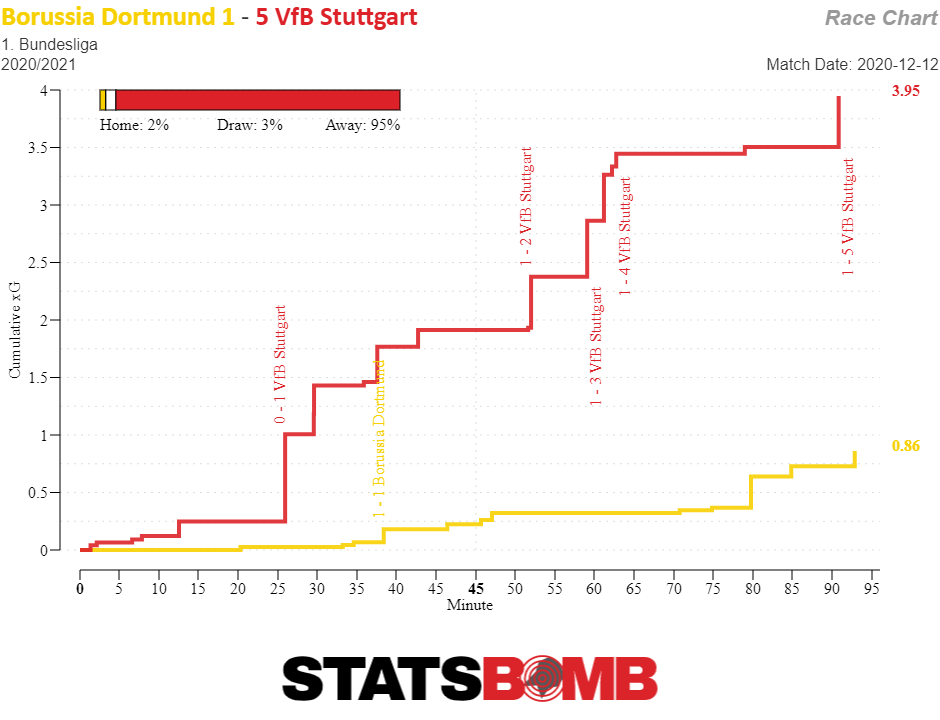
Speaking of VfB Stuttgart, they’re making an impressive mark on the league following promotion back to the Bundesliga in 2019/20. Previously assistant to Julian Nagelsmann at Hoffenheim, Pellegrino Matarazzo was appointed to his first senior management role in December 2019 and led Stuttgart to 2nd place in the Bundesliga 2. Right now, Stuttgart have the fourth-best xG Difference but are behind expectation in both defence and attack, to have a goal difference of +6 from an expected goal difference of +9.5.
At the bottom, Schalke 04’s sorry season has persisted despite two managerial changes already. David Wagner was politely asked to leave just two games into the 2020/21 campaign after back to back defeats continued an 18-match winless run, and the appointment of Germany under-18’s coach Manuel Baum did not have the desired effect. He was relieved of his duties after just 10 games. Now it’s Christian Gross who looks to dig something out of the Miners in his 33rd year of management.
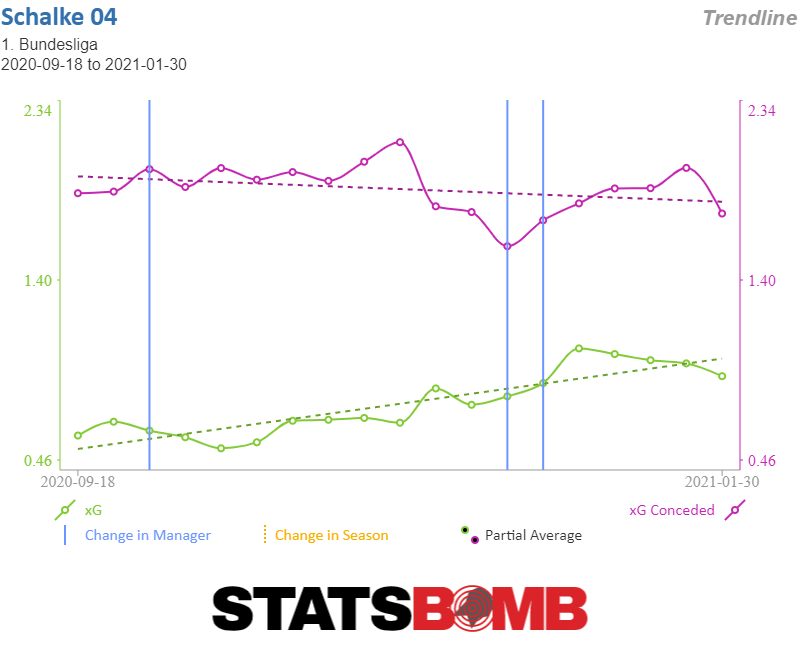
Nine points adrift and bottom of nearly every performance metric you can think of, it’ll be some turnaround if Gross can steer them to safety.
Join us at StatsBomb Evolve on March 17th 2021 to discover how we're going to change the football industry, including the launch of our new data product, StatsBomb 360. To find out more, click here.
Premier League 2020/21 Mid-Season Review
The latest destination on our traverse around the Big 5 European Leagues sees us land in England. The Premier League pendulum could be swinging back across the North-West, it's halcyon days if you wear claret-and-blue, whilst a couple of yo-yos appear to be unwinding at the bottom.
It's been four seasons since the top of the Premier League table has been this close after 22 games. There was a 25-point gap between 1st and 4th at this stage in 2019/20, it's just seven points in this campaign. Both Liverpool and Manchester City have taken it in turns to race ahead of the pack in recent seasons - some title races have been processions as early as January - but, for now, things remain congested.
With heavy recency bias, the current prevailing narrative is that Liverpool may well have ceded their title defence already. We all know how unrelentingly good they were last season (they were 21-1-0 at this stage) and maintaining those otherworldly standards was always going to be tricky - and that's even before you factor in the injury to Virgil van Dijk (and Joe Gomez, and Joel Matip...) as well as the issues in negotiating a pandemic-condensed fixture list.
It'll raise eyebrows, but there’s virtually nothing between Liverpool’s metrics last season and this. Their attack is identical, creating 1.8 xG per 90 and, ok, shots have risen from 15.4 to 15.6, whilst their defensive metrics have also seen a slight improvement, knocking 9 shots per game down to 7.7, and xG conceded from 1.0 xG to 0.9 xG.
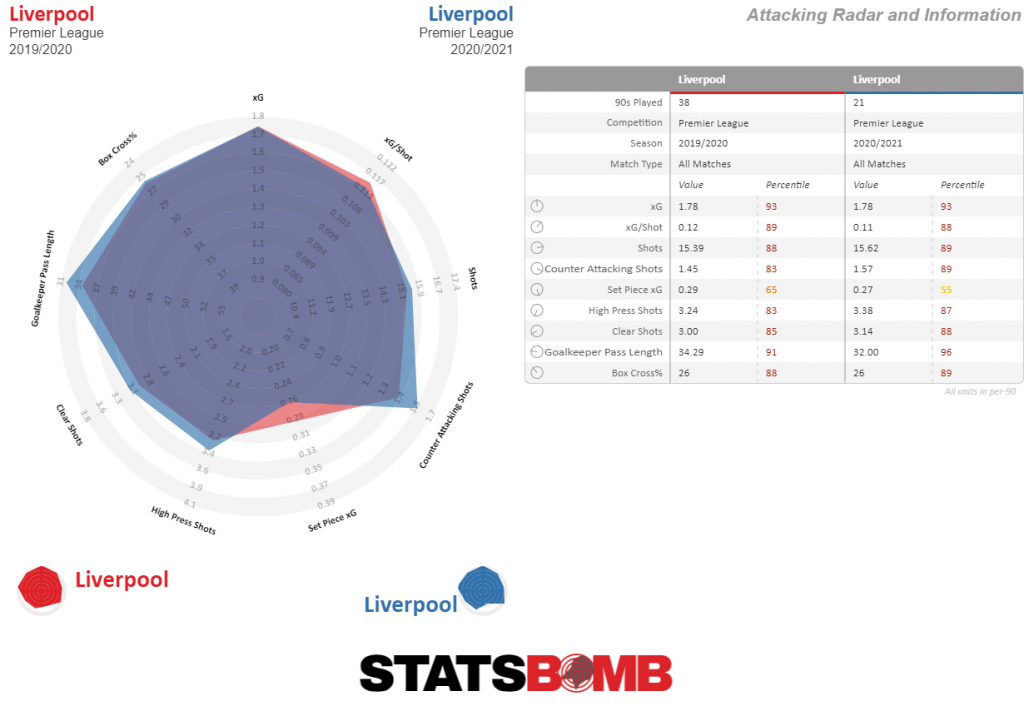
The metrics may be the same, but obviously the results are not. Why the big difference in outcomes?
More detailed analysis on their title win can be found in their season preview by James Yorke, but it boils down to this. Liverpool were extremely good at taking the lead in games last season, scoring first in 16 consecutive wins between November and February, for example. Not only that, they were also very good at doubling their lead once they were ahead. And what happens when you’re 2-0 ahead? You stop attacking as much and your opponents start attacking you more. Your chance creation decreases, your opponents chance creation increases.
This would’ve kept a ceiling on their metrics last season, and therefore those metrics may not actually be a true reflection of how good a team they really were.
This season, they’ve spent far less time ahead and haven’t opened the scoring as regularly, meaning they’ve had to keep their foot on the accelerator more often and their opponents have sat back to try and soak up the pressure - conditions under which you’d expect the metrics to skew more in Liverpool’s favour. So, whilst season-to-season the numbers may look the same, they're the product of very different game scenarios.
Another factor is that Liverpool are scoring slightly behind expectation in both attack and defence in 2020/21. Turns out this team is from Planet Earth after all, despite their near-perfect showing last time out suggesting otherwise.
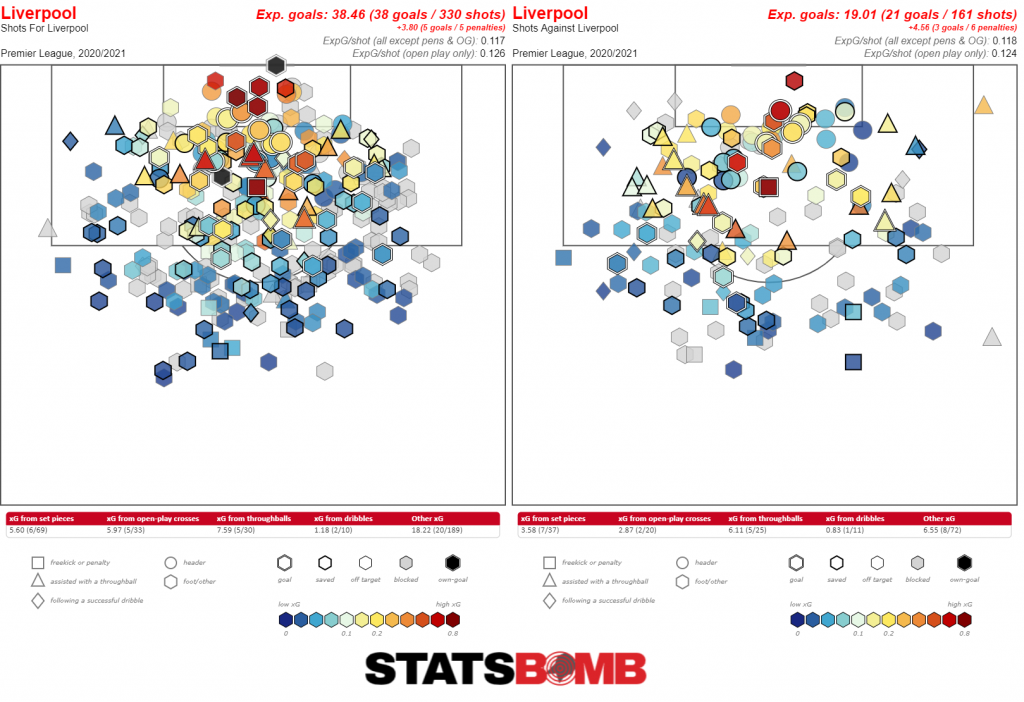
For all that’s gone wrong at Liverpool, relatively speaking, let’s talk about what’s gone right at Manchester City. The pendulum swung away from City last season as they finished a distant second, but right now it’s looking like it might be their time again. City are top, with the best goal difference, a game in hand, and have just won nine games on the spin.
Which means that their start to the season is already an imperceptible spec in the rear-view mirror. Just 12 points from their opening eight fixtures suggested City might fall short again, but that reaction now looks like it may've been premature, both with hindsight and when you consider they had to face Liverpool, Leicester, Spurs and Arsenal in a tricky set of opening fixtures.
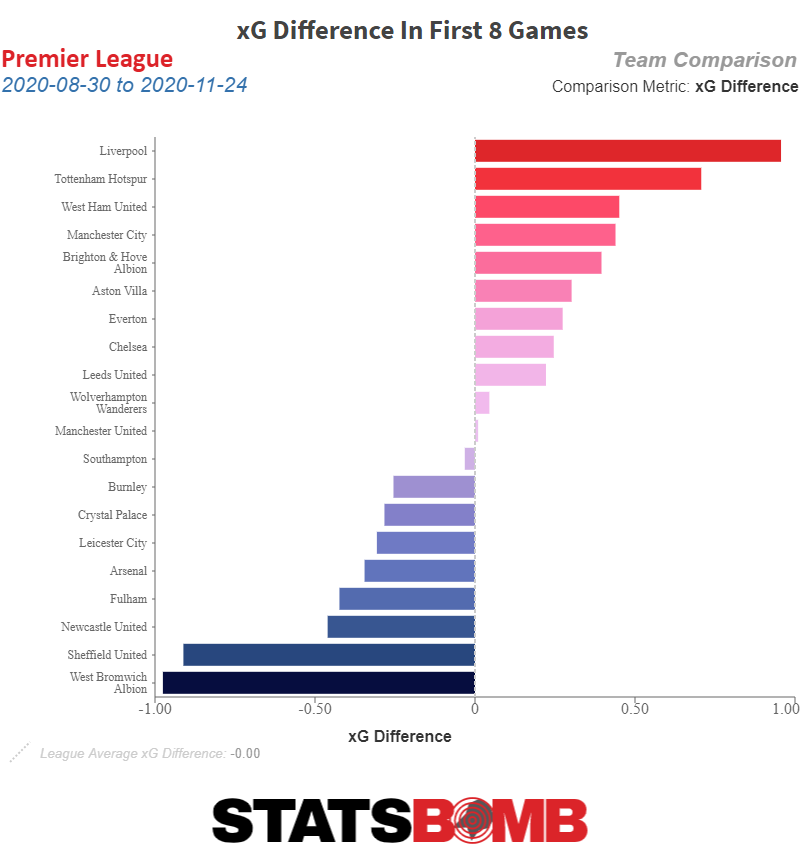
A run of 11-2-0 from their next stretch has seen them muscle their way to the front.
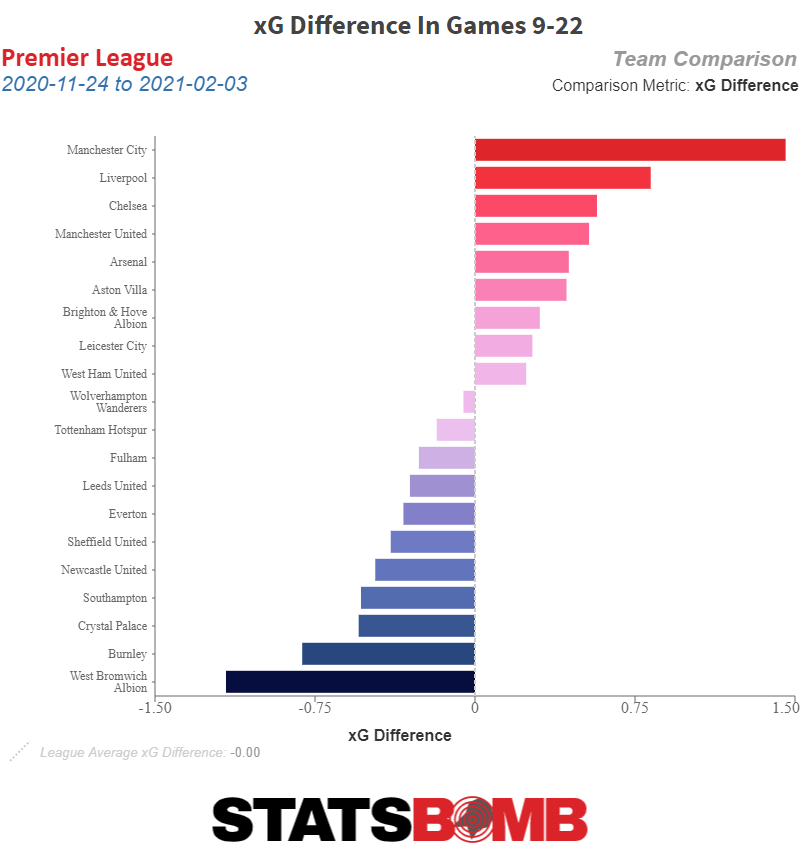
What may've been underplayed is that this is a different Manchester City team to the relentlessly attacking one we've been accustomed to in recent years. Their insatiable desire for goals has been replaced by an insatiable hunger for clean sheets. They're creating less in attack compared to previous seasons, but this is also the tightest they've been defensively in a long time. The trendline below shows the single-game xG values for each fixture and illustrates how consistent they've been at the back. They've conceded more than 1.0 xG on just one occasion.
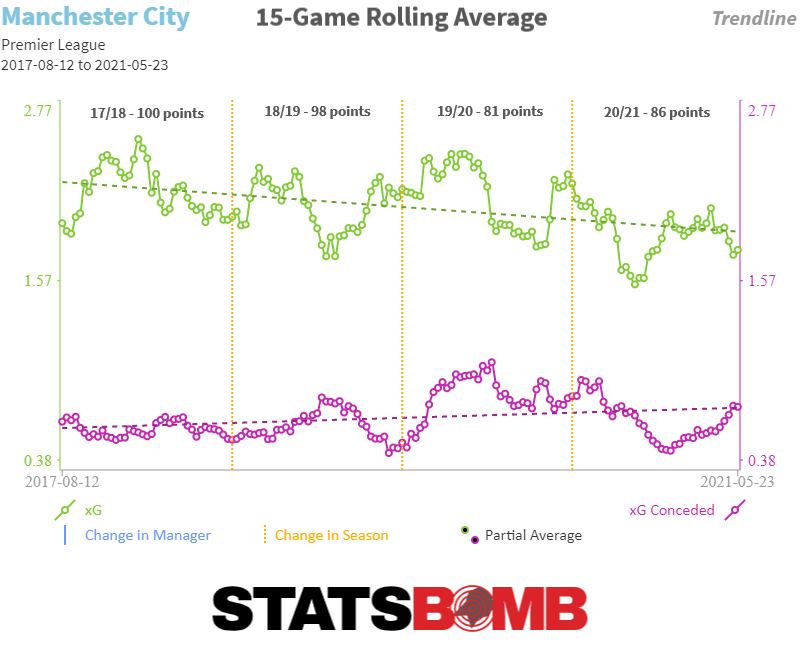
They're successfully limiting the number of shots their opponents are able to generate, but it's mostly a very noticeable decline in the quality of chances that City are giving up that has driven this improvement - this is the lowest xG per shot conceded that City have recorded in four and a half seasons of StatsBomb data.
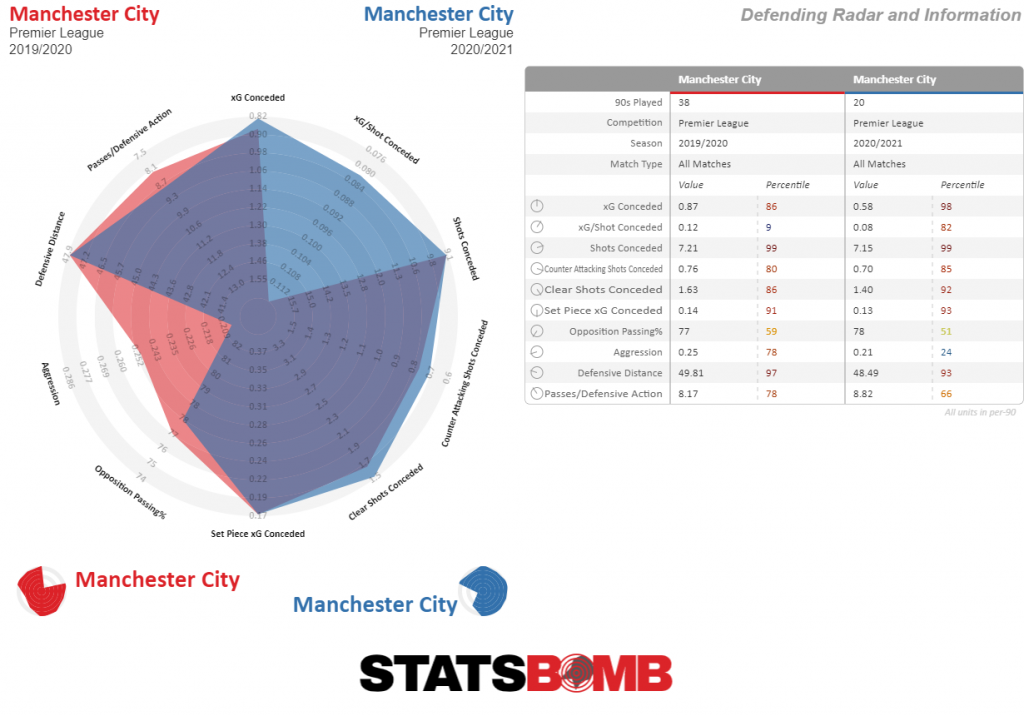
The title appears to be City's to lose at this stage, but the red half of Manchester are very much in this race as well. Manchester United are 2nd in the league and are also top scorers with 46 goals. The entire United squad appear to have to magic finishing touch right now with the exception of Anthony Martial and, perhaps surprisingly, Mason Greenwood. Greenwood blazed his way to 10 goals from 3.6 xG last season, but it's just 1 goal from 2.5 xG this. Fortunately, his teammates have taken on the mantle to leave United as a whole ahead of expectation.
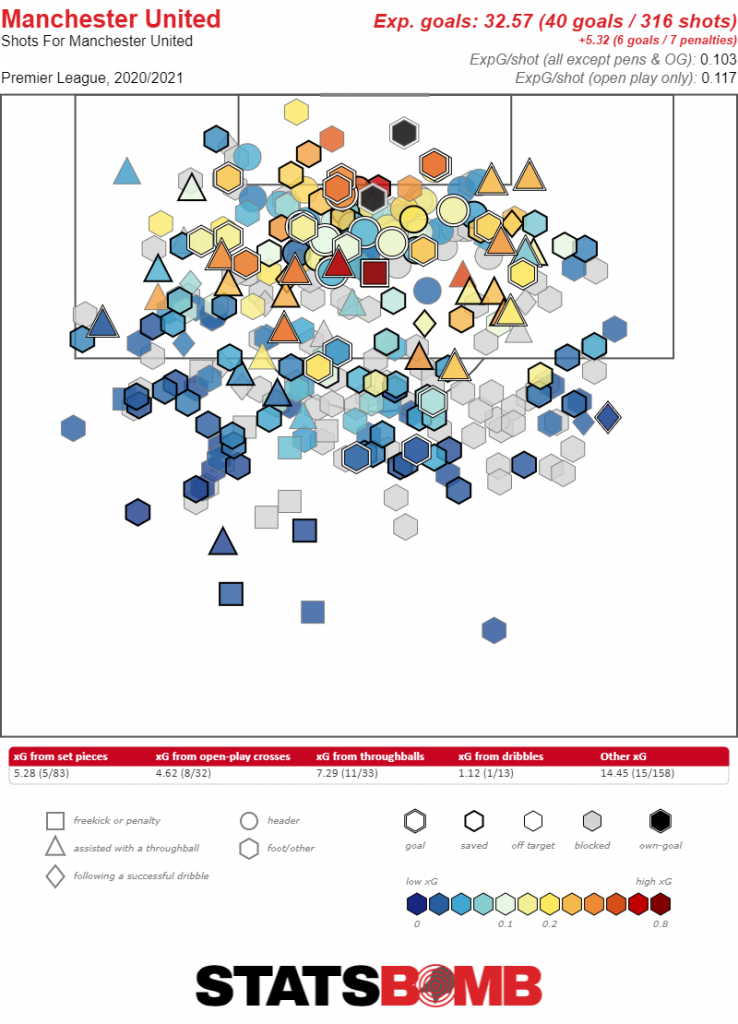
Bruno Fernandes has continued his excellent form since signing in January last year, serving up chances for the United attack with the regularity that Marcus Rashford serves half-term dinners. Fernandes has been the creative cog and link player between the midfield and attack that had been missing from the United side for years, and his performances have put him firmly in the conversation for the end-of-season player of the year award.
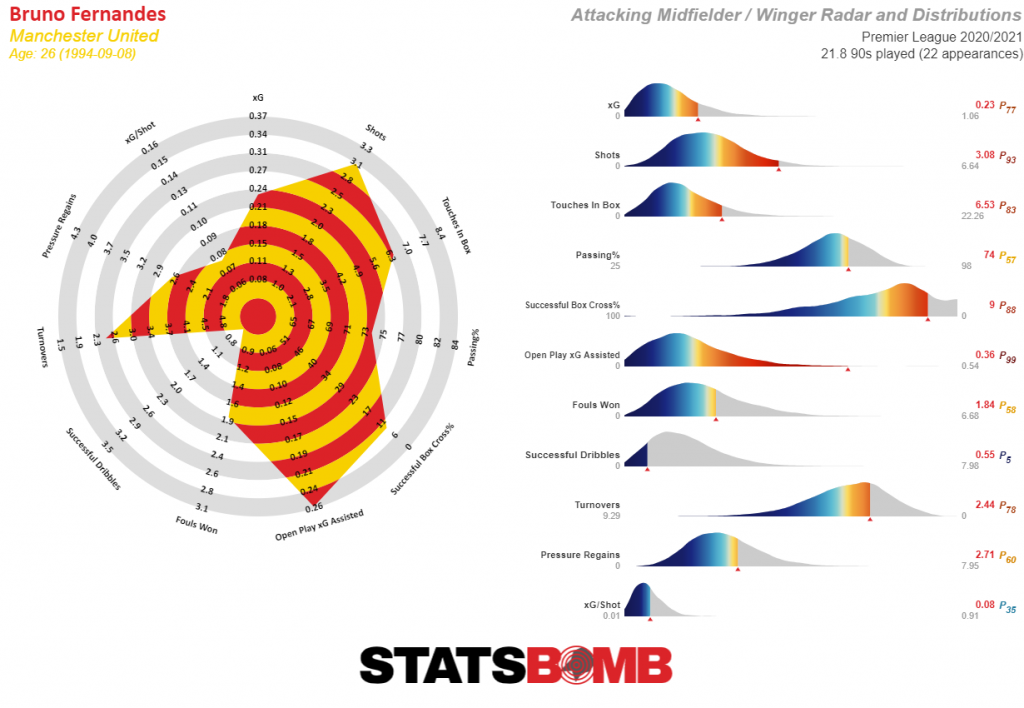
Leicester are third and at the speed they’re picking up points are rightly considered contenders, though they’re coming off less impressive metrics than their competition. Their expected goal difference is just above zero without penalties, but that comes with the caveat that they haven’t had to be as productive in open play due to their rate of winning spot-kicks, which at a 1-in-every-2-games rate is currently the highest in the Premier League and also the highest since the 2016/17 iteration of Leicester City.
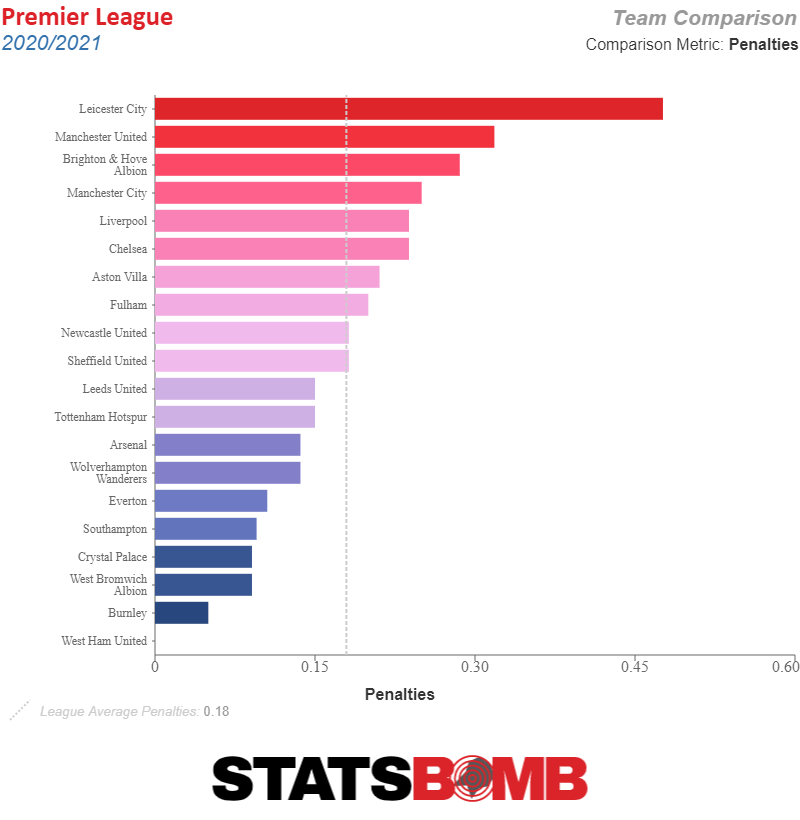
What Leicester do have in their favour, and the secondary explanation for their strong points tally despite the average metrics, is their record when taking the lead. The Foxes have gone in front 15 times in matches this season and conceded equalising goals on just two occasions. They’re at their best when ahead in games as seen in the positive-game-state shot maps below. They still create more than the opposition despite having a lead to hold onto. It’s also notable that six of their ten penalties have been won when they're ahead, allowing them to settle nerves and secure victories.
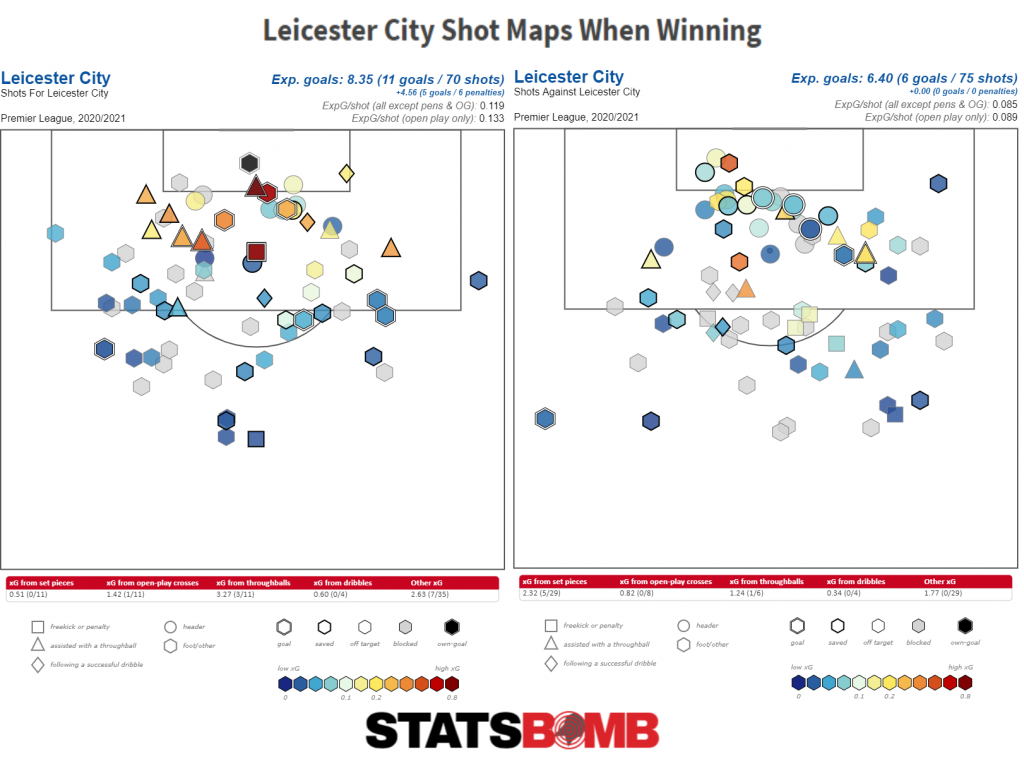
A collection of over and underachievers exist in the smörgåsbord between 5th-10th. Even now, ignoring pre-season expectations, if I asked you to put Arsenal, Aston Villa, Chelsea, Spurs, and West Ham in order of where you think they lie in the xG difference table, I bet it wouldn’t be this:
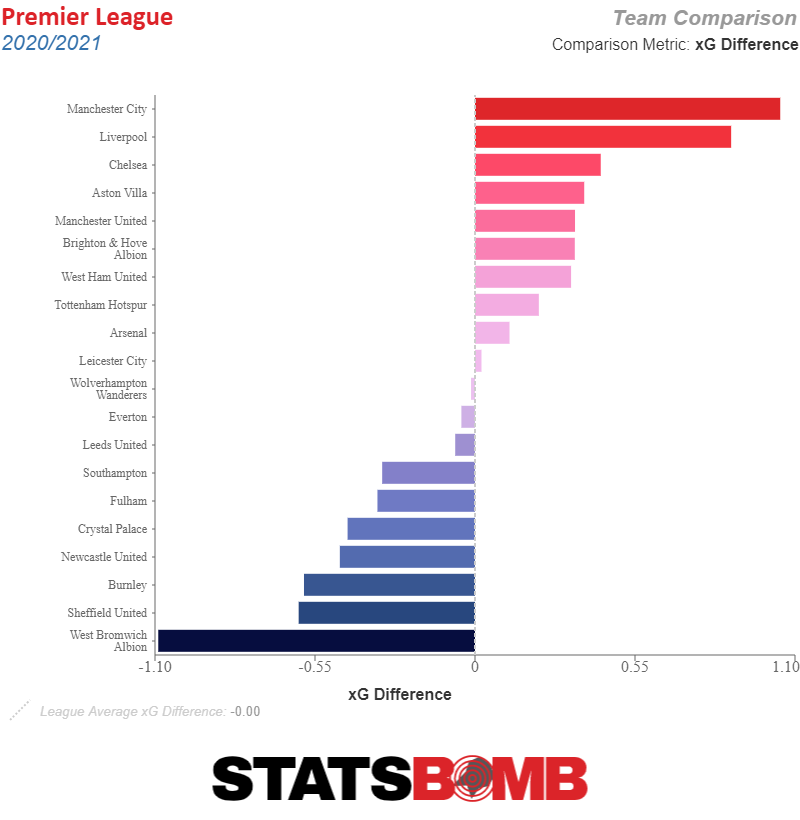
There’s also a deserved word to be said on Leeds too. People can’t seem to stop talking about Marcelo Bielsa's side this season and it’s not hard to understand why: they've come up from the Championship, changed nothing, and the result is the fourth-best attack and the second-worst defence by xG. Leeds games are box office; their press like a 90-minute swarm of angry Yorkshire bees, with a regular flow of chances at both ends of the pitch. Leeds' PPDA of 5.9 is a Premier League low in the last four seasons.
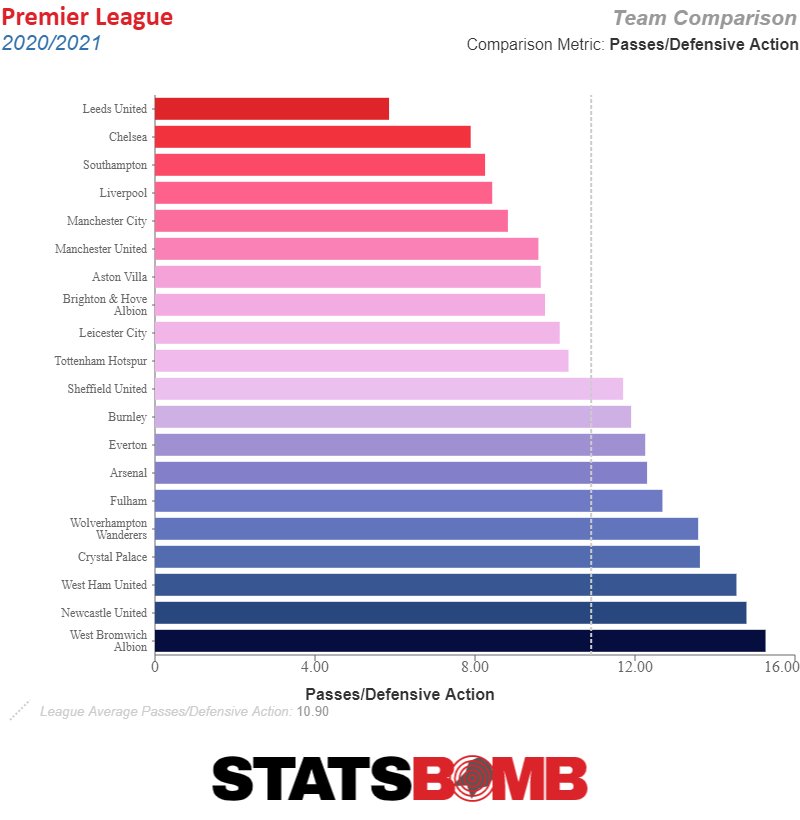
Lastly, the bottom of the table where three teams find themselves cut adrift of the pack. Just three points separate Fulham, West Brom, and Sheffield United between 18th-20th, though that gap was larger before Sheffield United picked up three wins in their last five.
There was talk of the Blades’ possibly becoming the Premier League’s worst ever side before that renaissance, but it’s newly-promoted West Brom who would be the strongest candidates for that dishonour on current showing, had they not already surpassed 2007/08 Derby County’s points tally. The Baggies currently have the worst xG difference per game and the worst xG conceded of the past four and a half seasons of StatsBomb data. And as the ancient football proverb goes: what yo’s up, must eventually yo down.
Join us at StatsBomb Evolve on March 17th 2021 to discover how we're going to change the football industry, including the launch of our new data product, StatsBomb 360. To find out more, click here.
Ligue 1 2020/21 Mid-Season Review
We go to France next in our mid-season reviews of the major European leagues, where the title race is far from the foregone conclusion it has been in recent seasons, and with some surprise packages providing entertaining support acts along the way.
Just once in the last eight seasons - Monaco in 2016/17 - has the Ligue 1 title not been won by PSG. The Parisian’s grip on French football has not just come in the form of league titles, it’s also been the processional inevitability and comprehensive margin of victory that observers have become all too used to in recent seasons.
Not this season. Mesdames et messieurs, we have ourselves a title race.
We’ll start with the holders. PSG began their title defence with defeats in the opening two rounds of the season, the first time they’d done so since 1984/85. A curtain-raising defeat to newly promoted Lens was still a shock despite several enforced absences due to positive Covid-19 tests or isolation, including the pair of Mbappé and Neymar. The following 1-0 loss to Marseille in Le Classique was the equivalent of using sandpaper to rub salt into the wound.
The subsequent eight-game winning streak, scoring 26 and conceding 1, that followed suggested on a surface-level that Les Rouge et Bleu were back on course and their period of plain sailing was to continue, but that wasn't to be the case. Hints at a downturn in performance turned into nudges, and then nudges turned into sharp elbows to the ribs as the team’s attacking output drifted away. A run of three wins in seven games saw the end of Thomas Tuchel's managerial reign.
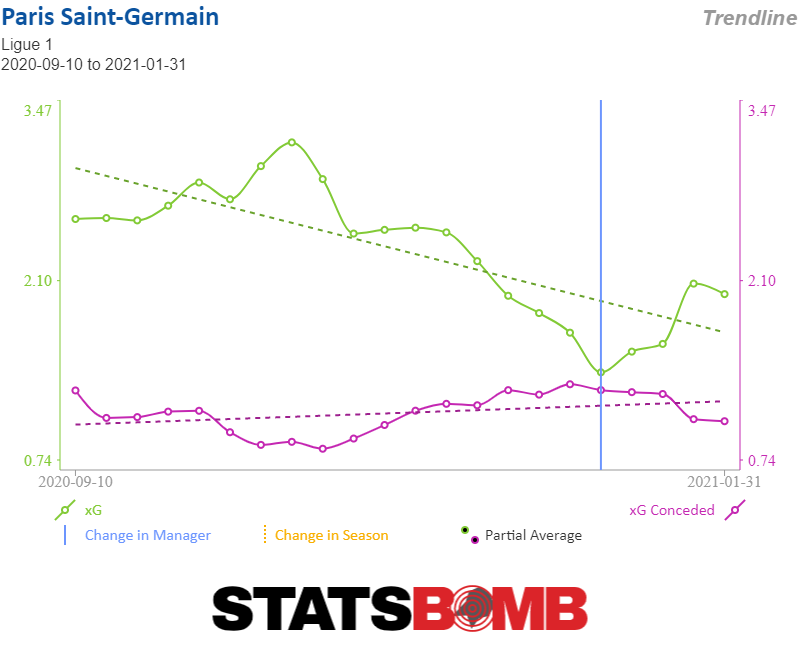
Whilst their attack only cooled in more recent games, there had always been warning signs on the defensive end that all was not well, despite conceding the fewest goals in the league at the midway point. It’s thanks to a combination of poor finishing from their opponents as well as consistently good goalkeeping from Keylor Navas that PSG have so far retained the best goals against record in the league because by xG, they are far from the most watertight defensively, conceding chances worth 23.4 xG, only the seventh-best record in the division. This is where the most obvious improvements can be made for the incoming Mauricio Pochettino.

It’s the team at the top of the xG conceded ranking that also tops the league table as things stand. Lille have the lowest expected goals conceded and have indeed conceded only one more goal than PSG – a defensive record that has helped them to lose just two games in 22 this league season.
It’s a clichéd blend of youth and experience in the centre of defence providing the sturdy foundation for Lille’s title charge to sit on. The now 37-year-old José Fonte partners the highly-rated Sven Botman, freshly graduated from the Ajax academy, and both are screened by the busy Benjamin Andre in central midfield, who leads the league in tackles + interceptions.
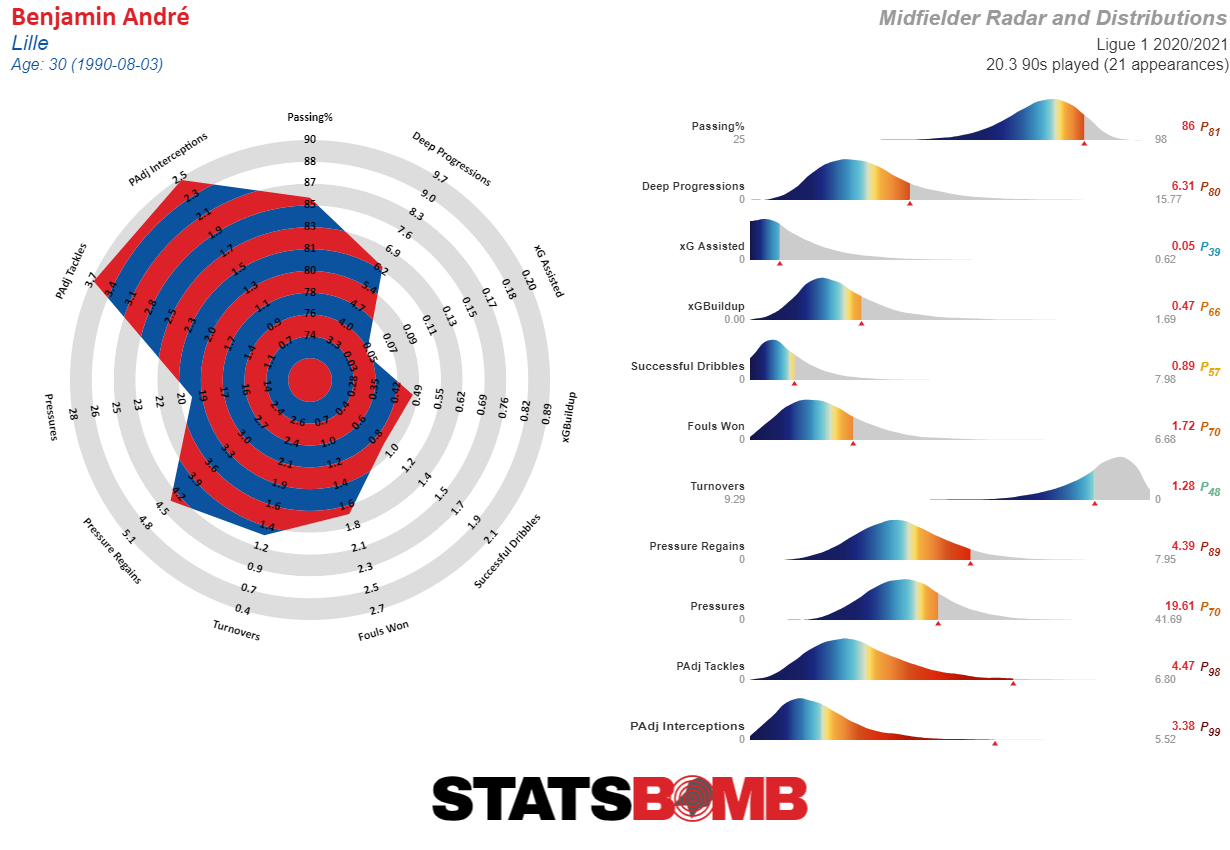
It’s a highly effective partnership that Fonte and Botman share, with each excelling in different areas on the game – Botman providing the progressive outlet in buildup, playing the second-most passes from open play in Ligue Un, whilst Fonte sticks to putting his body on the line in front of goal, ranking joint-first in the league for blocks made per shot conceded. This willingness to keep the goalkeeper's gloves clean at any cost has helped Lille to concede the joint-fewest Clear Shots in all of Ligue 1 – shots with just the goalkeeper between ball and goal - rarely allowing their opponents a straightforward view of the goal.
Organised in the defensive phase, they’re equally well-drilled in the defensive transition, running an effective counterpress high up the pitch to prevent the opposition from hurting them with space in behind, resulting in a league-low return for shots conceded on the counter attack.
2nd placed Lyon currently have the best underlying numbers in the league and lead the pack by expected goal difference. It's mostly due to massively upgrading their attack that they've been able to push themselves into title contention: compared to last season, they’ve added 3.5 Shots per game to their output, and are also taking those shots from better locations, resulting in a 0.8 xG per game upgrade on their final third output.
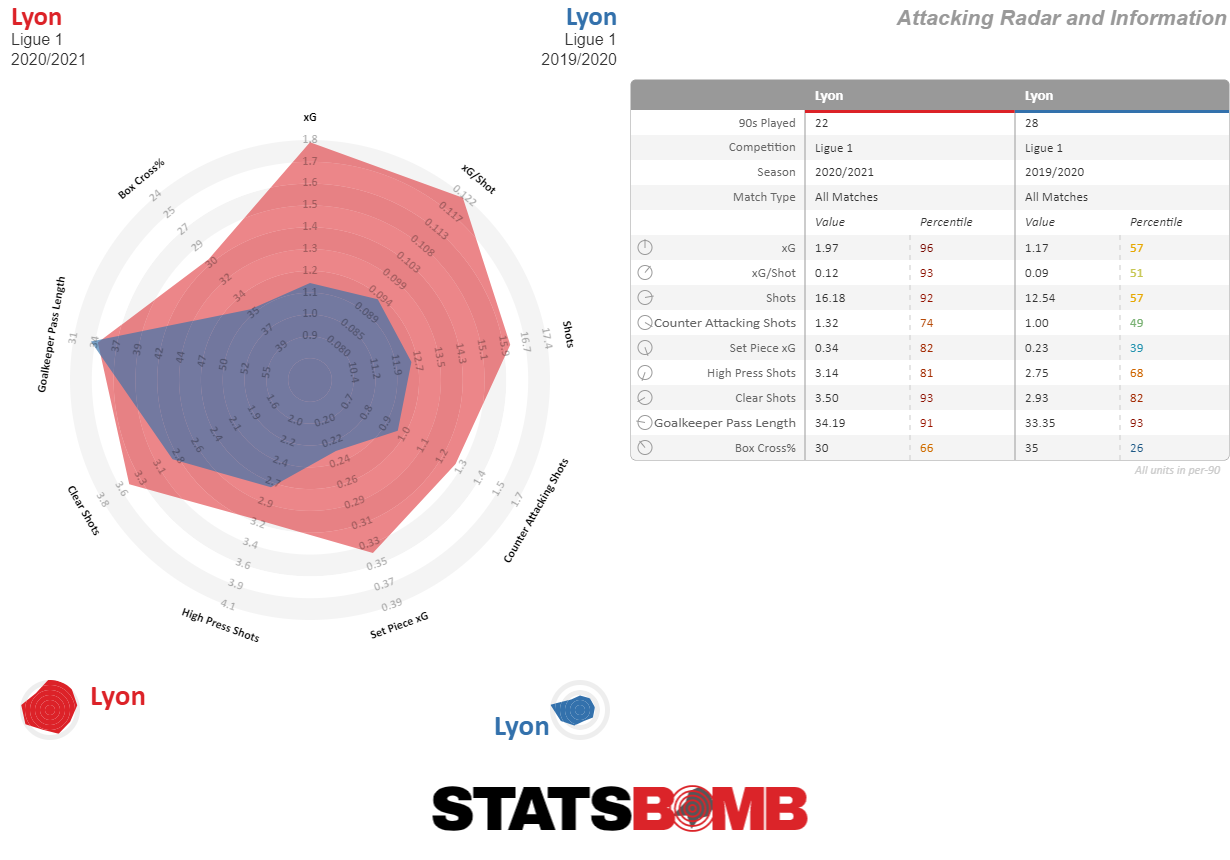
Manager Rudi Garcia, a Ligue 1 title winner with Lille in 2010/11, took Lyon to the Champions League semi-finals in 2020 despite a 7th-placed finish in the league, and has managed to translate that European success into domestic form in this campaign.
Despite playing as the centre-forward, Memphis Depay has been the team’s leading creative outlet, laying on the chances for wide players Karl Toko Ekambi and Tino Kadewere rather than providing the main goal threat himself. Depay ranks second only to Ángel Di María for xG assisted per 90 in Ligue 1. Toko Ekambi and Kadewere are the willing recipients off the left and right flank respectively, with both having the second and third highest xG per 90 respectively in the league.
It isn't just their cohesive and potent attack that's giving Lyon a very credible chance at winning their first title since 2008 though, it's the balance they've found between that and a very competent defence. Les Gones have the best xG per shot conceded and it’s largely down to allowing just six(!) shots within their six-yard box all season.
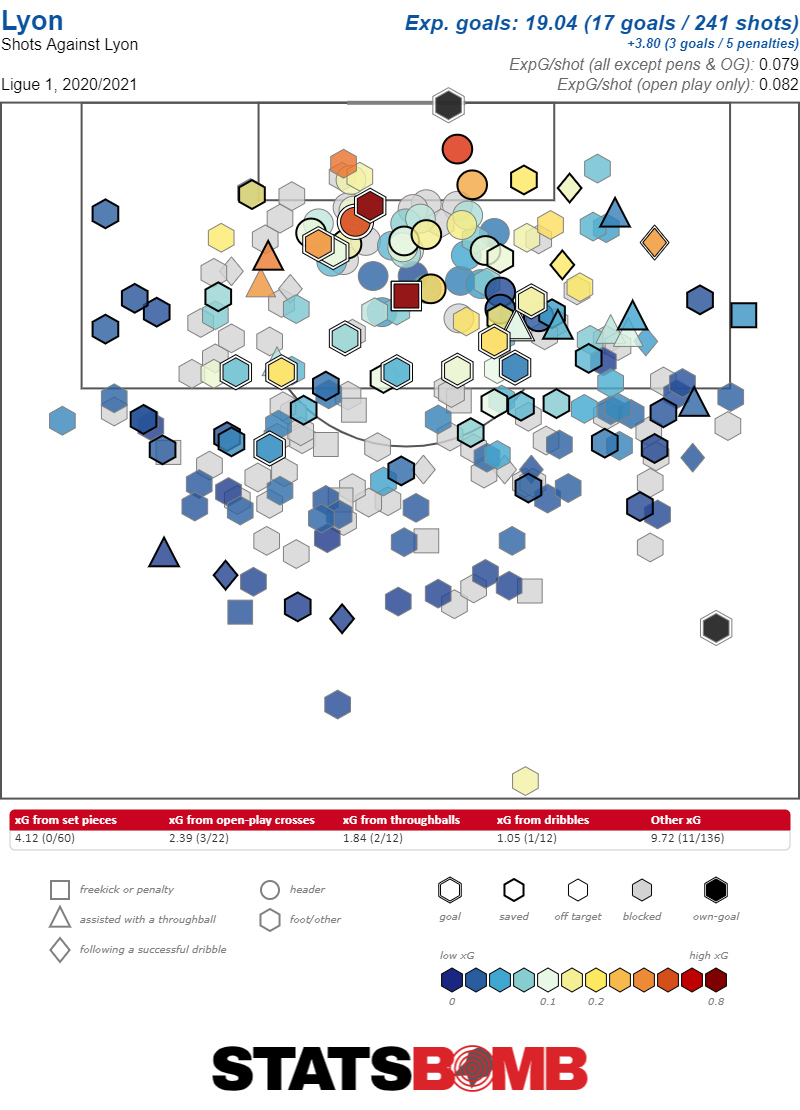
AS Monaco are well in the race as well, just six points behind leaders Lille, and their on-pitch process appears to back that up, having the third-best xG Difference in the league. Goalkeeping issues have held them back so far - Benjamin Lecomte had the worst Shot Stopping % (Save% - xSave %) in the division before breaking his hand, and replacement Vito Mannone fared almost equally poorly. The result is that Monaco have conceded 27 non-penalty goals from 18.8 xG, though it’s also only fair to point out that this has been counter-balanced by some overperformance on the attacking end. Their attack has been powered by a sizeable output from set plays with 14 goals a full six goals clear of the next best team in this phase. Centre backs Guillermo Maripán and Axel Diassi have netted seven goals between them up to now, with Maripán, at 0.44, currently enjoying a better goals per 90 rate than Neymar.
Elsewhere, there are two surprise packages sat in the top half - Metz and Lens. Metz finished 15th last season following promotion but are already sat on the same points tally they finished last season’s curtailed renewal with, on 34 points from 22 games this campaign. There’s been some overperformance at both ends of the pitch for Les Grenats, but there are also some clear signs they have improved on their 2019/20 showing. Their xG per shot against of 0.08 is only marginally bettered by Lyon and Lille, and they’re keeping this down by preventing their opponents from shooting from close range as often as possible – the average Shot Distance by their opponents of 18 metres is the second-furthest in the league.
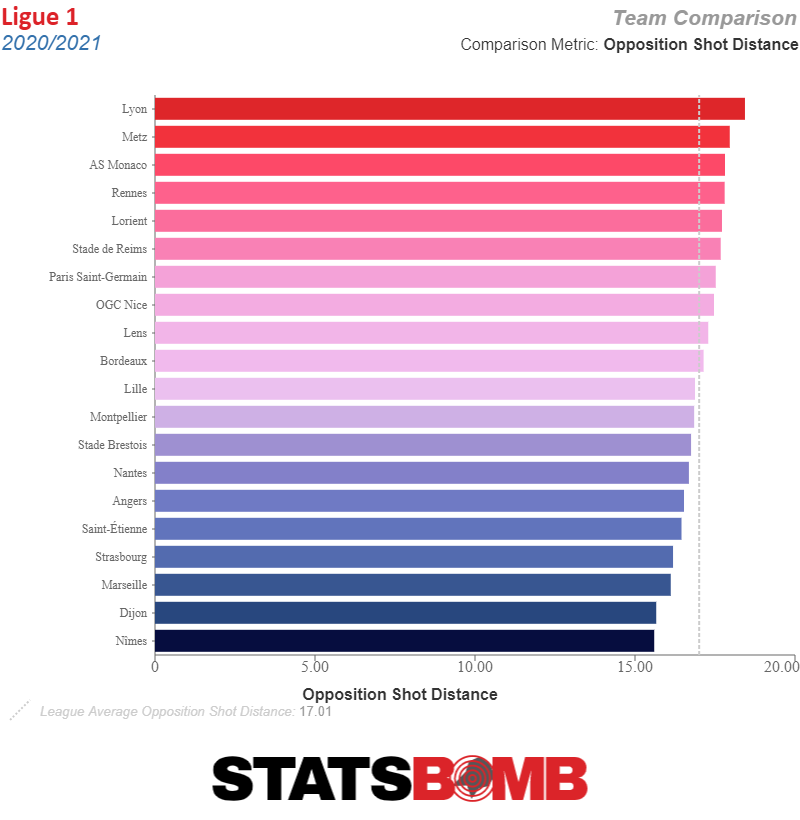
Lens are interesting for two reasons: that they’re newly promoted and that their underlying numbers are actually legit – they have the sixth-best expected goal difference. Franck Haise’s side are running a highly effective defence and are one of the most disruptive sides in the league in their own defensive third, preventing their opponents from moving the ball close to their goal. Lens have conceded the second-fewest passes inside their own penalty area and second-fewest passes within 20m of their goal.
Their organised block stops the opposition from having any meaningful possession in areas that threaten their goal. Towards the bottom, Dijon find themselves 19th in the table despite having conceded the joint-ninth fewest goals with 31. How? Because they’ve scored just 15 times. Things could be even worse too, given the quite mysterious misfiring of their opponents in front of goal, whilst there’s nothing in fellow strugglers Nîmes underlying numbers to suggest they might pull off an equally dramatic escape.
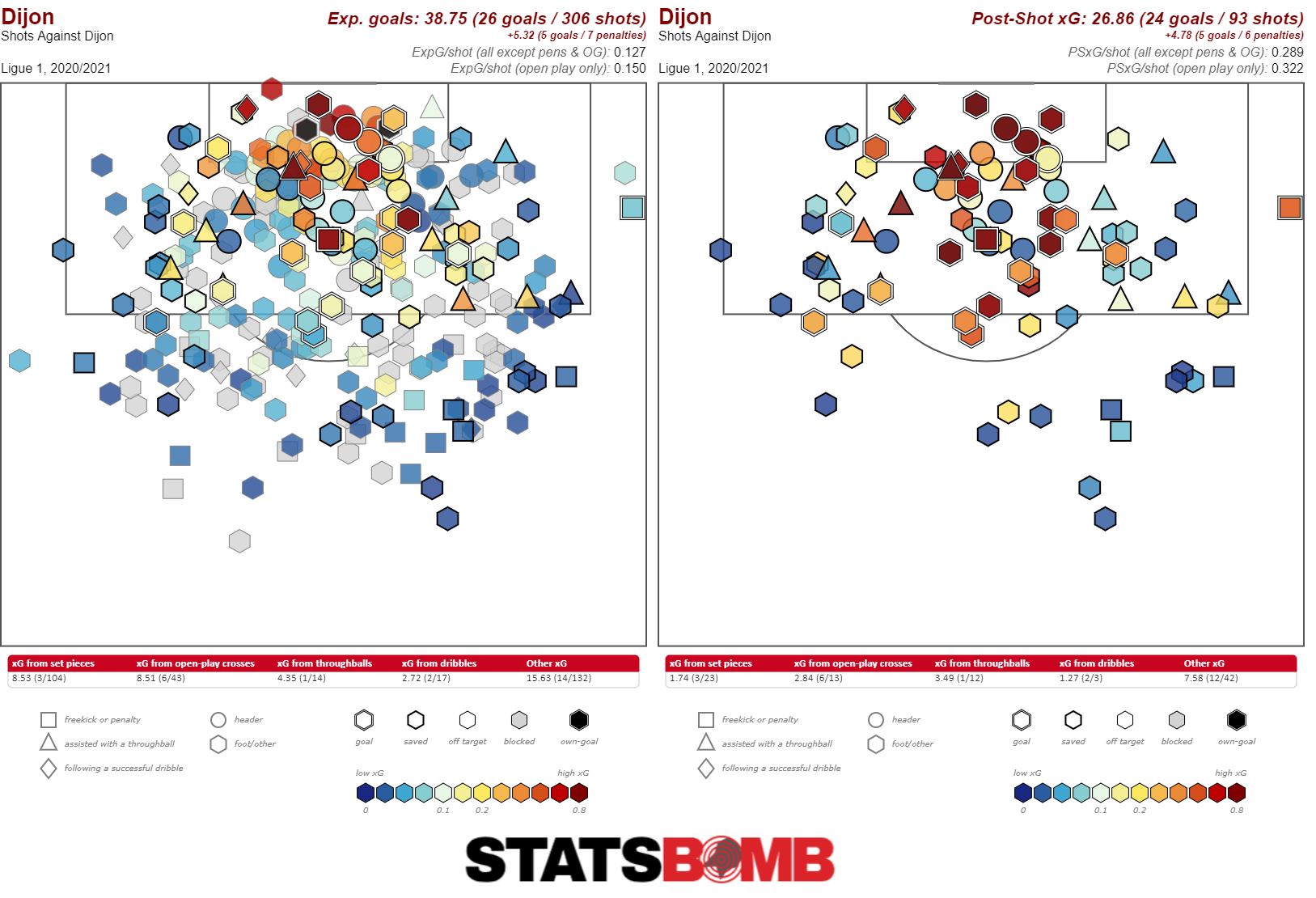 There are genuine threats to PSG’s title defence this campaign and from multiple directions. Pochettino will need to have an immediate impact on his Parisians if they’re to retain yet another Ligue 1 victory.
There are genuine threats to PSG’s title defence this campaign and from multiple directions. Pochettino will need to have an immediate impact on his Parisians if they’re to retain yet another Ligue 1 victory.
Join us at StatsBomb Evolve on March 17th 2021 to discover how we're going to change the football industry, including the launch of our new data product, StatsBomb 360. To find out more, click here.
Serie A 2020/21 Mid-Season Review
We begin our round-up of the mid-season state of play in the major European leagues with a look at Italy's Serie A, where a close title race, a plethora of goals and an unfortunate finishing run feature among the standout stories at this stage of the campaign.
The Tightest Title Race
Serie A could well be on course for one of the closest finishes of the modern era. Five or six teams have put together broadly similar results and underlying numbers to date, and it wouldn’t be at all surprising if three or four of them finished the campaign within a couple of wins or less of one another.
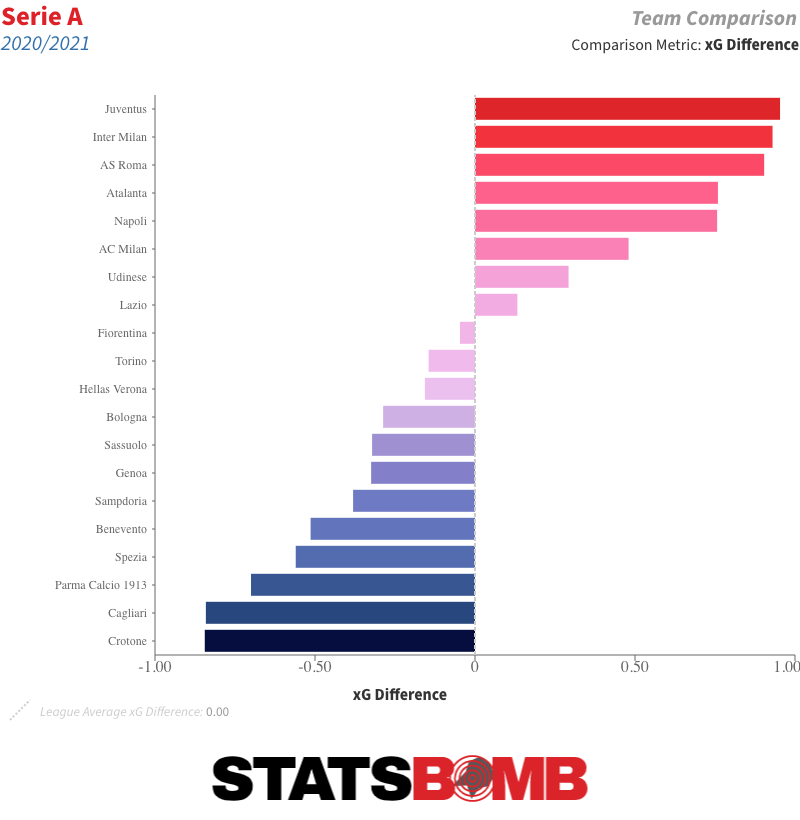
The two Milan sides have set the pace so far, but both Roma and nine-time defending champions Juventus are within reach, while Napoli, Atalanta and a Lazio side with less competitive metrics are only slightly further back. Inter look particularly strongly placed, with the second best metrics and a workable margin over both Juventus (with the best) and Roma (with the third best). Romelu Lukaku has been near unstoppable up front.
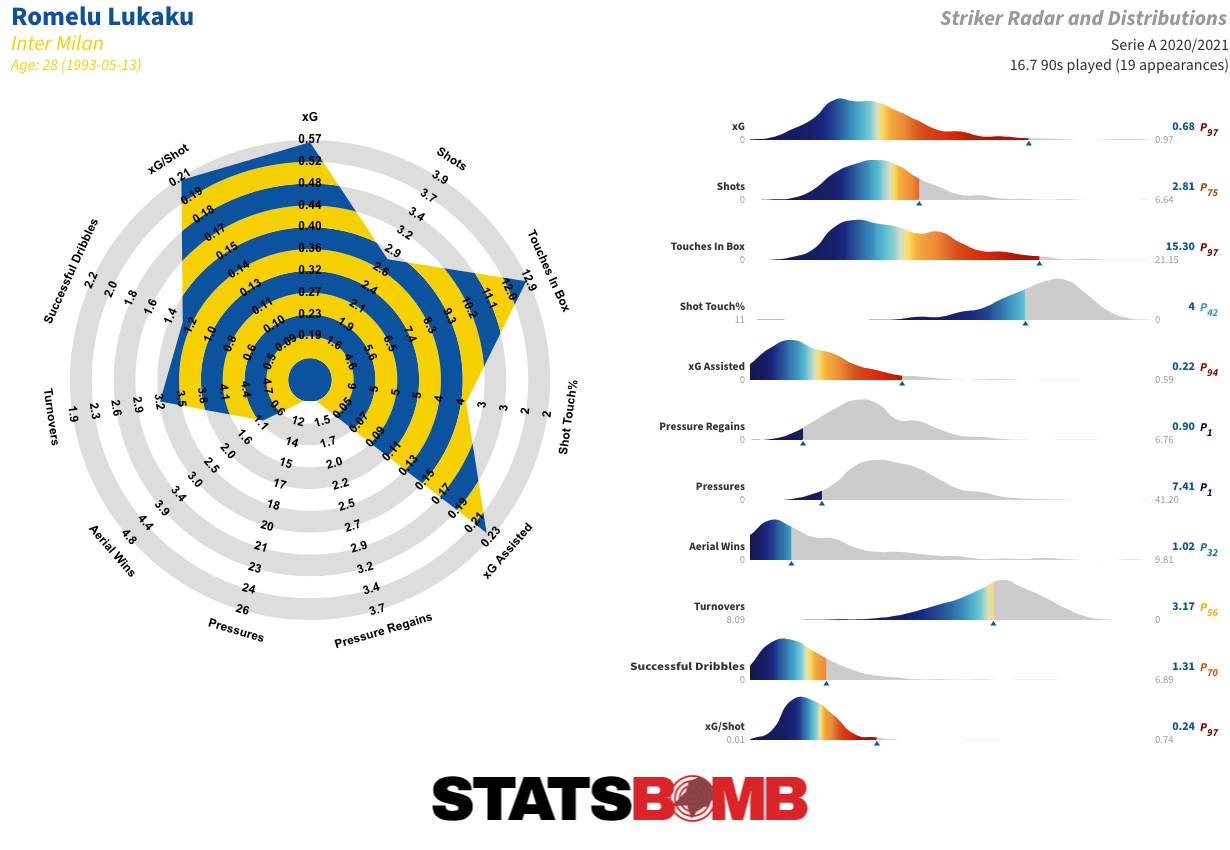
Milan have carried their excellent form down the final stretch of last season into this, but there are a couple of things that may count against them during the second half of the campaign. Firstly, while they are performing pretty much exactly in line with their metrics, they are not as strong of those of their primary competitors. Secondly, Stefano Pioli’s side have benefited from far more than their fair share of penalties. They’ve won nearly three times and scored exactly twice as many as any other team.
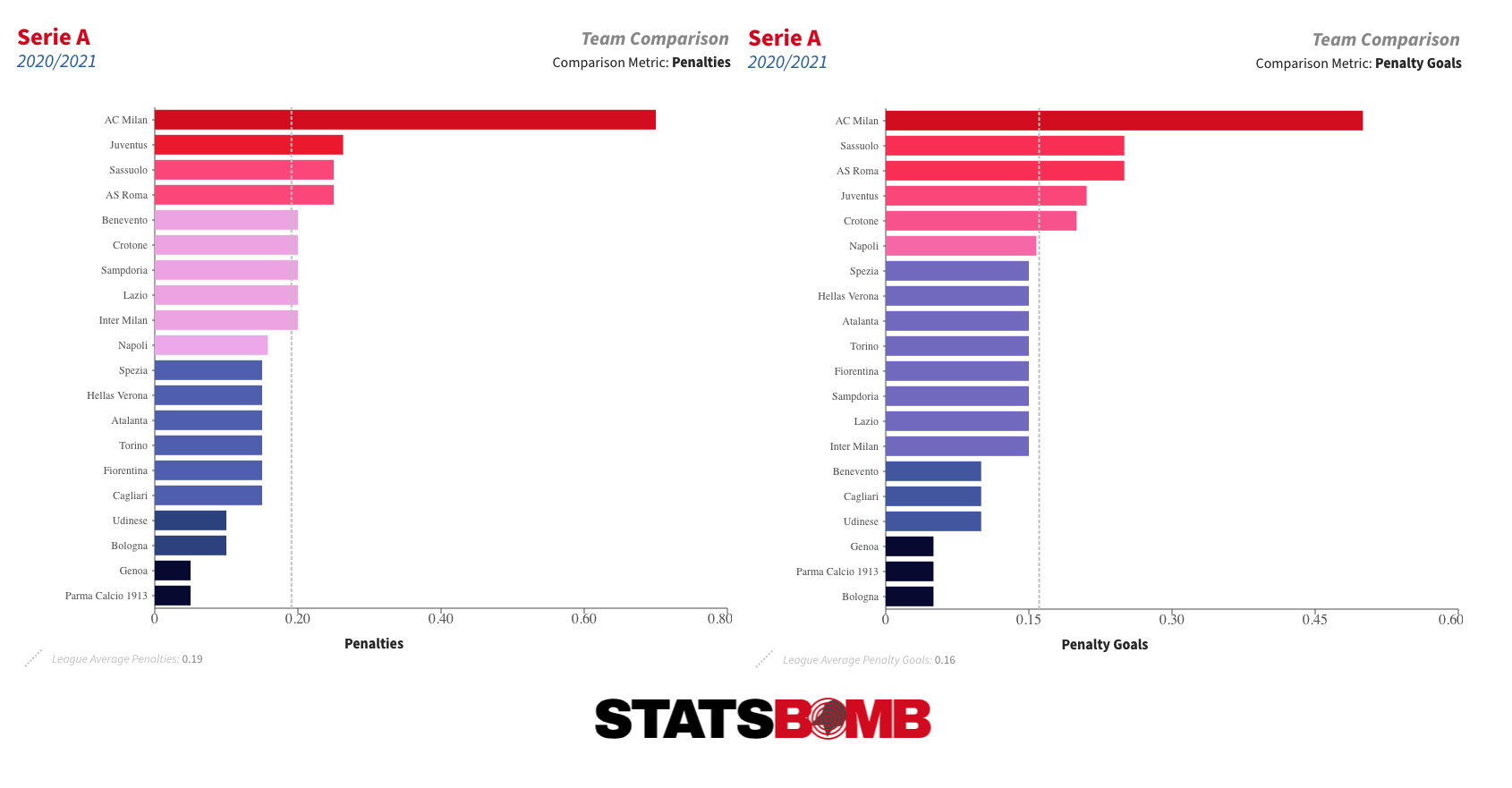
That is unlikely to hold. They’ve already been awarded six more penalties and scored two more than in the entirety of last season in a league that has actually seen slightly less penalties given this time around. The points are already on the board and this is still on course to be Milan’s best season since they finished third in 2012-13. Good recruitment work has created a squad capable of continuing this upward trend into the seasons to come. But they are arguably the most likely candidates to suffer a drop off in results from hereon out.
Lots of Goals
Serie A came flying out of the traps with an average of 3.75 goals, 3.44 non-penalty goals and 2.96 expected goals (xG) per match over the five first matchdays of the season. It was comfortably the highest-scoring of the big five leagues at that stage. That has inevitably settled down a little as the campaign has progressed and the sample size has increased. Both the underlying xG figures and the degree to which non-penalty goals are outrunning them have decreased...
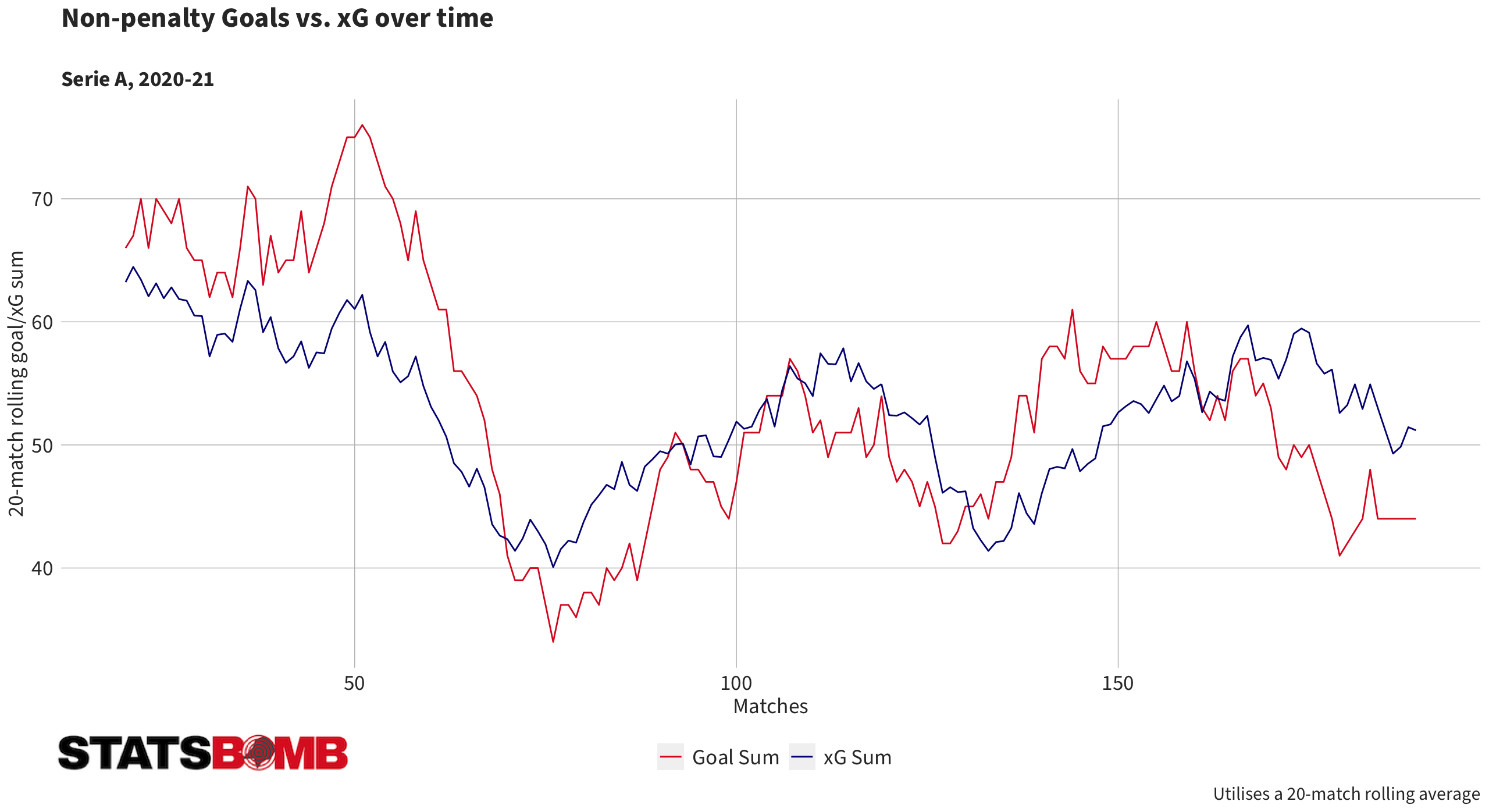
...but Serie A remains almost neck and neck with the Bundesliga as the highest scoring league by all three measures. That despite the fact that it is seeing an average of almost four less shots per match compared to last season, down from 28.15 then to 24.45 this time around. The mild increase in xG per match season-on-season has been driven by a clear increase in average shot quality, from 0.090 xG/shot last season up to 0.106 in 2020-21. That is reflected in the decrease in the average shot distance -- down from 17.28 metres to 16.29. Every single one of the 17 teams who remained from last season are taking their shots closer to goal on average.
Udinese’s xG woes
No side have underperformed their metrics to a greater extent than Udinese. Luca Gotti’s side appear well-constructed, and in Rodrigo de Paul they have a player capable of running pretty much all aspects of their attack.
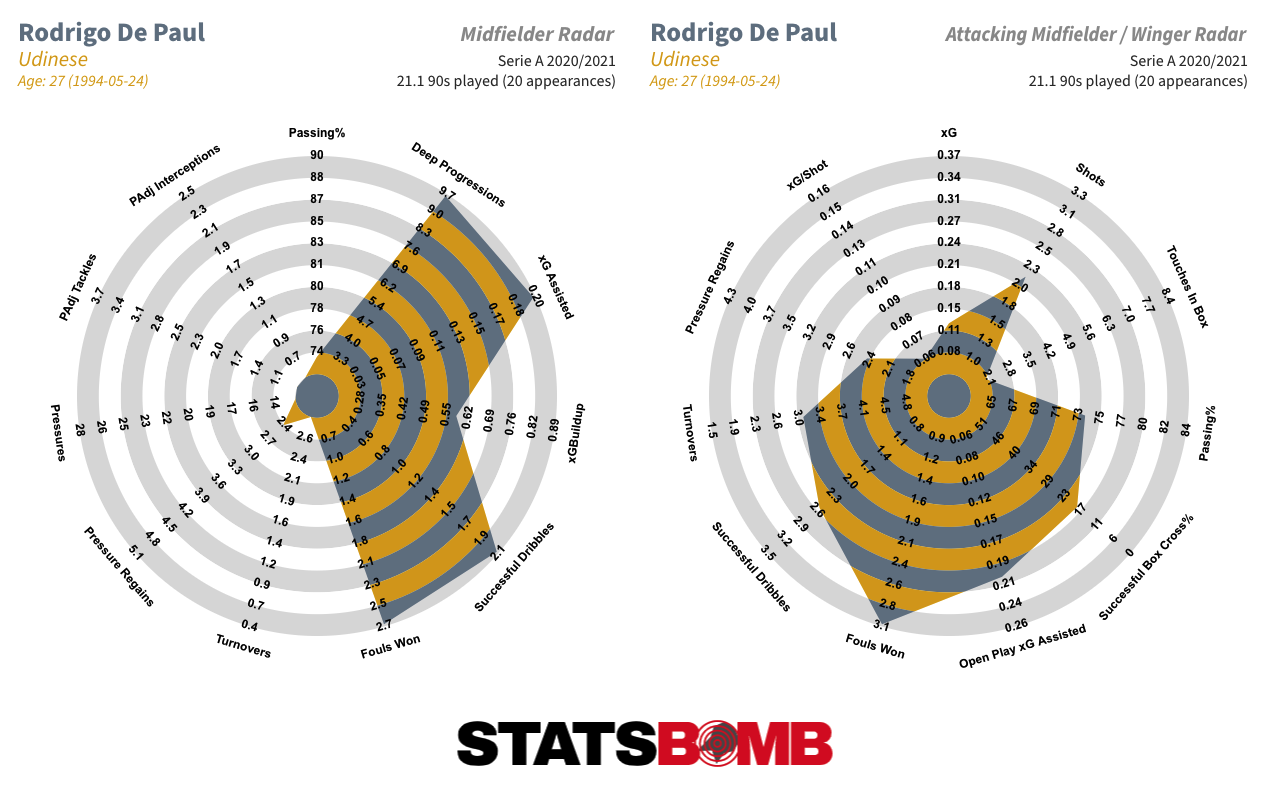
They are a top-eight side by xG difference but due to an underperformance of comfortably more than half a goal per match, they instead find themselves down in 13th, some 10 points off that mark.
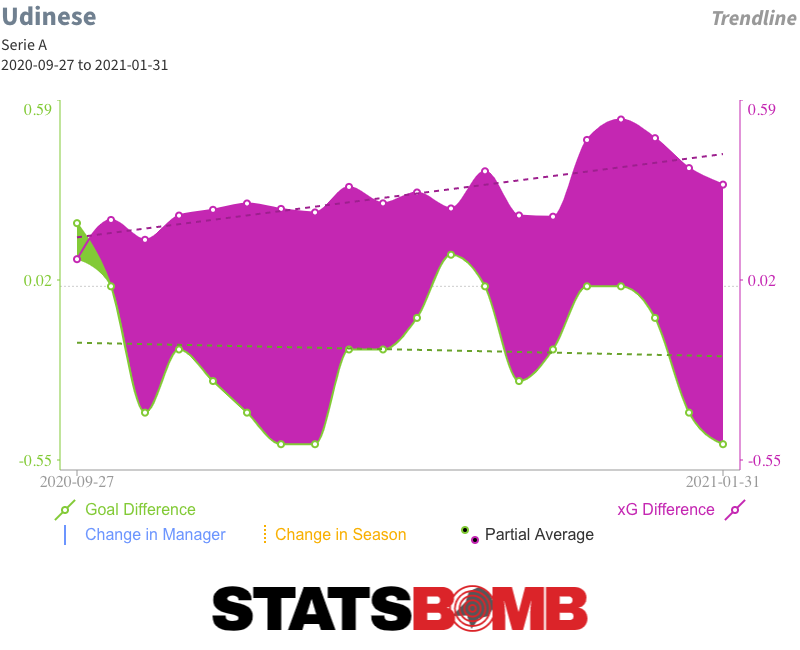
That underperformance is evenly distributed between both ends of the pitch. They are just under six goals behind in attack.
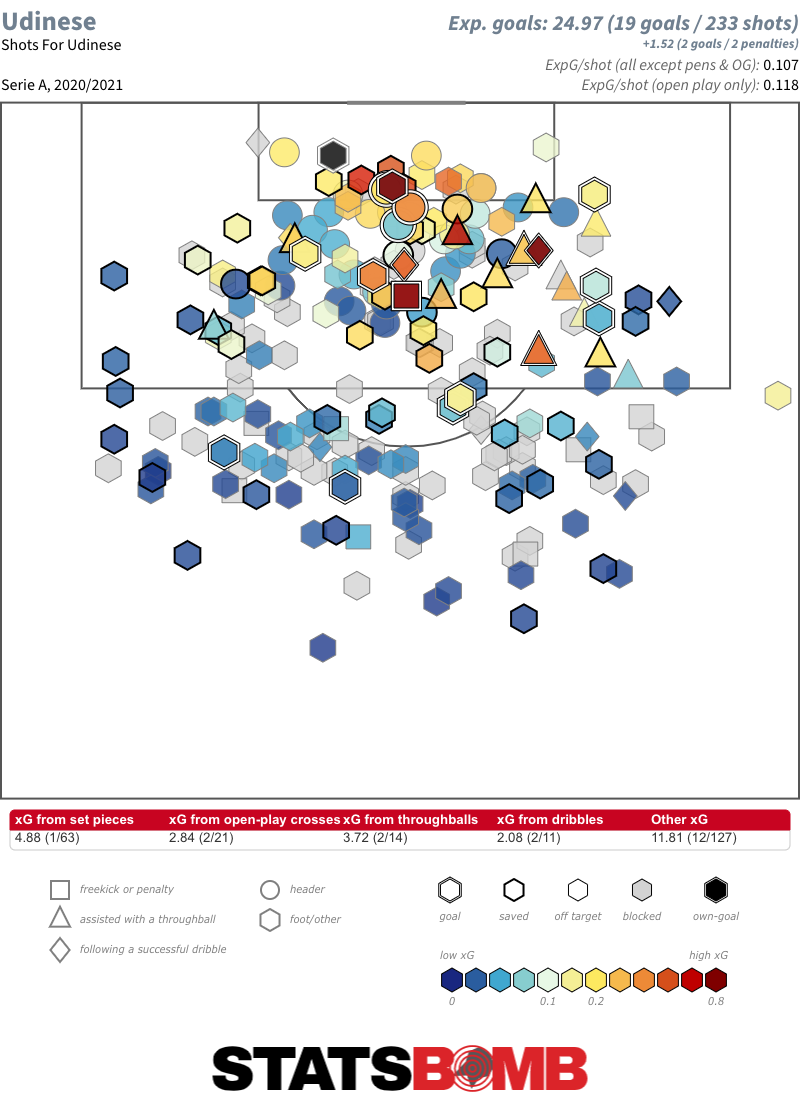
And have conceded just over six goals more than expectation in defence.
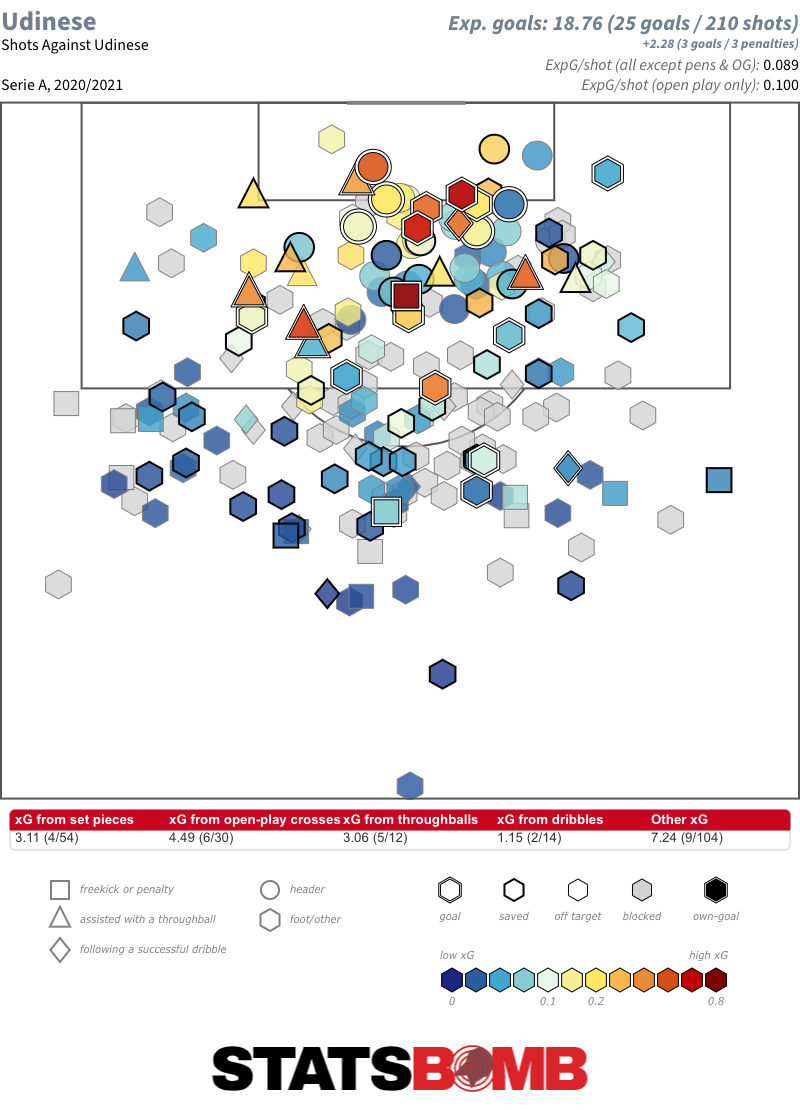
A fair amount of that attacking underperformance would appear to fall on the shoulders of one man: Kevin Lasagna. He’s been layering on the xG, only for it all to fall apart in the oven. He’s getting on the end of plenty of throughballs -- more, per 90, in fact, than anyone else in Serie A -- and into other advantageous positions, but the finishing touch has too often eluded him. He has just two goals from 7.34 xG.
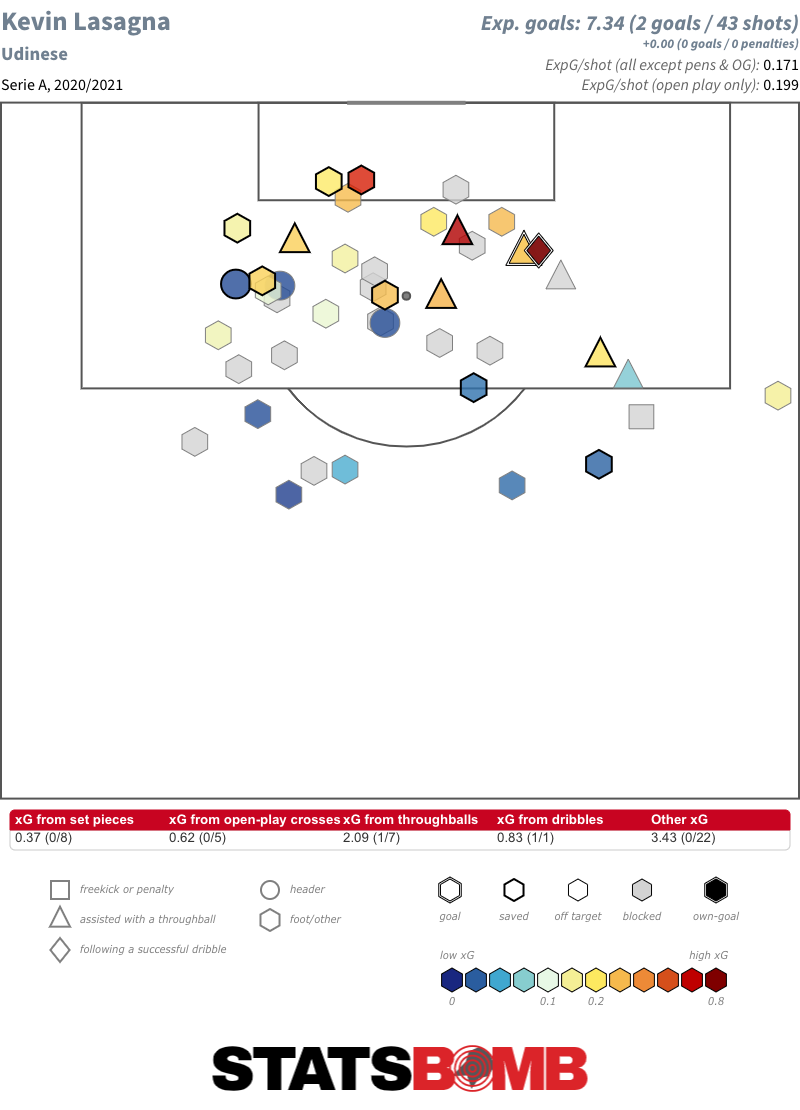
Lasagna is not a perennial underperformer. He scored pretty much exactly in line with his xG last season, and was even a couple of goals ahead in 2018-19. He is probably just going through a very unfortunate run of finishing on a side who appear to be suffering a similar fate. Udinese are more than good enough to avoid relegation troubles, and if they start performing more in line with their metrics, they might even be able to salvage a top-half finish.
Additional tidbits
- Genoa are the only side across the big five leagues to have used their entire complement of five substitutes in each and every match. That is even more remarkable given they’ve had two different coaches: Rolando Maran; then, from late December, Davide Ballardini.
- Piotr Zielinski is the nutmeg king of Serie A. The Napoli midfielder has not only completed more nutmegs in total than anyone else (8), but is also the only player among those to have played more than 900 minutes to have performed a nutmeg more than once every two matches. Achraf Hakimi of Inter Milan is next up.
Join us at StatsBomb Evolve on March 17th 2021 to discover how we are revolutionising the football data industry (once again), including the launch of our new data product, StatsBomb 360. 
EFL 2020/21 Mid-Season Review
As we hurtle through the midway point of this unrelenting EFL season, there's just time to quickly take stock. A top-to-bottom analysis won't be much use when it’ll all have changed within a week, so instead we’ve picked out 10 of the most interesting storylines from a typically chaotic opening half of the EFL season.
1) Swansea City Shut-Outs
Play-off semi-finalists in 2019/20, Swansea are going well once again. So well, in fact, that they’re currently on course to break a Championship record since it rebranded in 2005 for the fewest goals conceded in a league season. Preston North End’s miserly 30 concessions in 2005/06 is the yardstick to beat - The Swans’ record of 14 conceded from 25 games puts them on course.
Steve Cooper's made a clear move towards implementing a more robust defensive structure: their Aggression % - the percentage of opposition pass receipts that are tackled, fouled or pressured within two seconds – has dropped from 23% to 18%, and this new approach has paid rich dividends across every defensive metric.
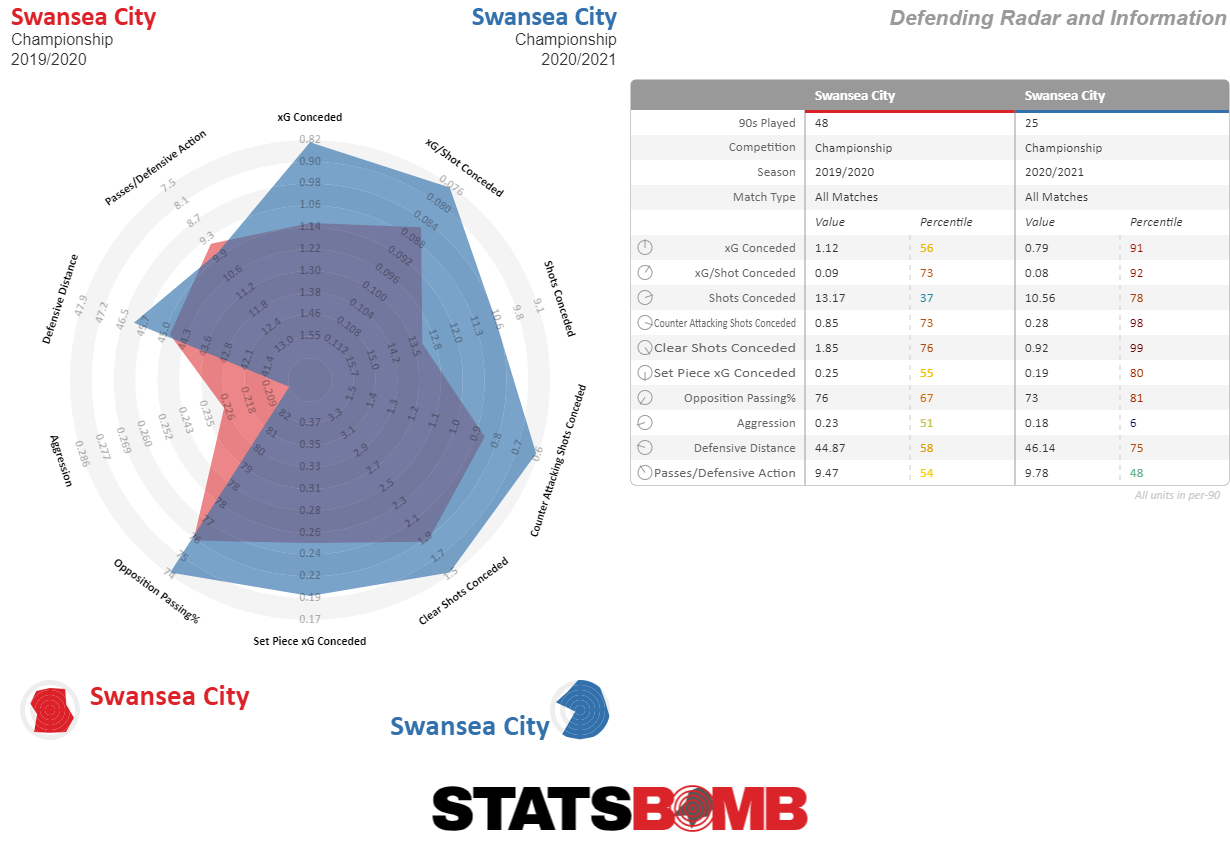
Their diligence in the defensive transition means they've conceded seven(!) counter-attacking shots all season, as well as just 22 shots that have solely the goalkeeper between ball and goal.
Simply, the team doesn’t concede valuable chances. The Swans have faced just 11 shots with an xG value greater than 0.30 all season. In laymans terms, they very rarely concede anything approaching a clear-cut chance. Such stinginess could power them all the way back to the Premier League.
2) Pressing Matters With Callum O’Hare
After a successful loan spell, securing Callum O’Hare’s services on a permanent deal was a crucial piece of summer business for newly promoted Coventry. They’ve been rewarded with an unrivalled work rate from the young attacking midfielder.
This comes as no surprise considering O’Hare led League 1 last season with a whopping 33 pressures per 90. That number is slightly down this campaign – understandable given the especially tight schedule – but relative to the Championship it’s barely noticeable. The result is that no one in the entire EFL registers more pressures per 90 than O’Hare, and in the Championship it’s not even close.
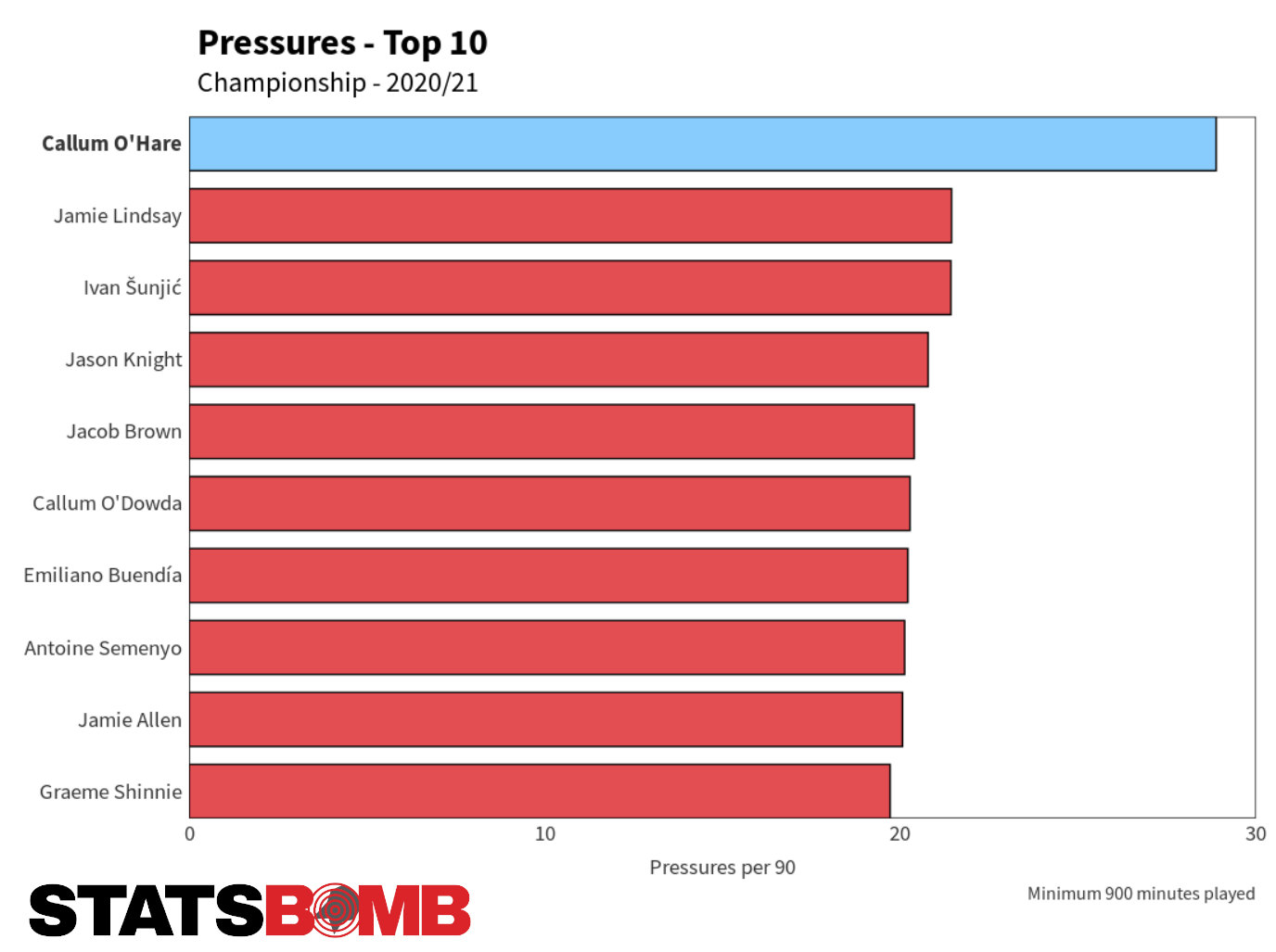
When you consider that he’s played more minutes than all-but-one of the other players in the top 10, it's even more impressive. The prolonged off-season Coventry enjoyed compared to their Championship rivals is certainly paying off for both O’Hare and the Sky Blues.
3) Has ‘The Beast’ Unlocked a New Level of Physical Dominance?
It was a different world when Adebayo Akinfenwa last appeared on the StatsBomb site back in October 2019. At that stage there was one unknown and one unlikely: the unknown was whether then-37-year-old Akinfenwa would continue playing this season, the unlikely was that Wycombe would secure promotion to the Championship for the first time in their history.
Fast-forward and here we are, with both Akinfenwa and Wycombe playing at Championship level for the first time. Bayo was never likely to turn down the opportunity to go to war with Championship centre backs, having bullied their League One and League Two counterparts in his career up to now.
Last season in League One he managed 9.7 aerial wins per 90, league-leading for players with more than 1200 minutes, but this season he’s taken that aerial dominance to a new level despite the rise in class, in what is a notoriously physical league in the Championship. His current rate of 14.6 aerial wins per 90 is the best in England’s top four divisions.
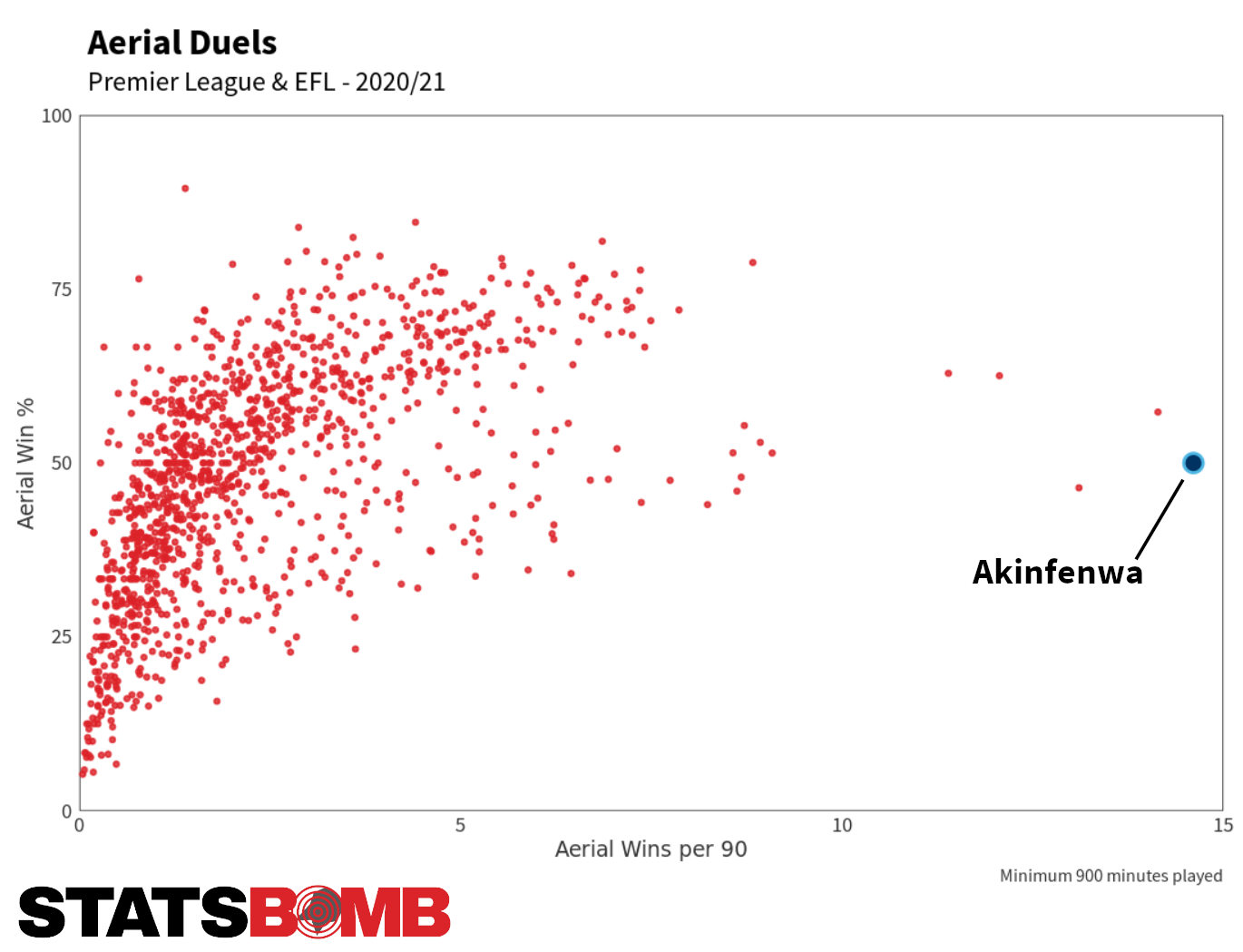
Wycombe’s not-so-secret weapon continues to provide a valuable outlet for them in making the ball stick up front. Can they and Akinfenwa together pull off an unlikely survival in the second half of the season?
4) MK Dons: Camped In Enemy Territory, But Defensively Exposed
Into League One now where MK Dons have caught the attention of the EFL audience for their possession-based style of play. They’ve gained a lot of plaudits for their ability to control the territory but, whilst being easy on the eye, they’ve struggled to convert this dominance into points, currently sitting 16th with a return of 28 points from 24 games.
There’s a real dichotomy between the process and the outcomes at Stadium MK. The Milton Keynes based side, with 52.8 Deep Progressions per 90, enter the opposition’s final third more often than any other team in League One and, once they’re there, they’re also completing more passes within 20m of goal than any other side, completing 6.4 Deep Completions per 90. However, this dominance isn’t translating into shots or good chances on goal: the Dons rank 13th in League One for both shots and expected goals created.
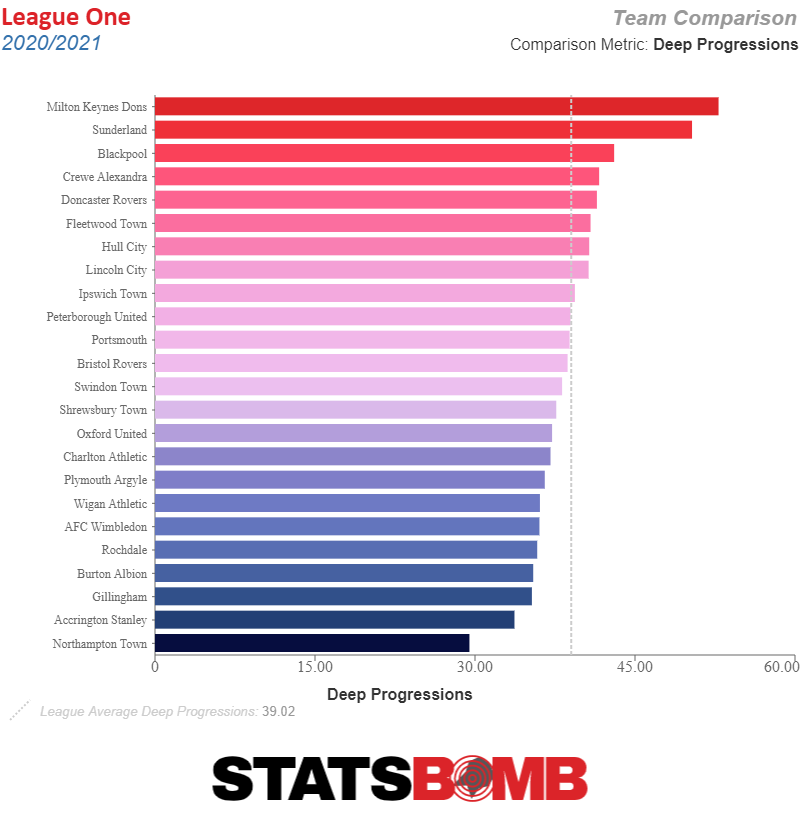
It’s a similar story at the back. MK are behind only Sunderland for both final third entries conceded and Deep Completions conceded. It’s only a good thing that the opposition are spending so little time in threatening positions, but the issue is what happens when they do break into MK Dons territory - find space and cause a lot of damage. MK’s xG per shot conceded of 0.13 is the worst in the league.
5) Josh Emmanuel: Full Back Attack
There are many great sights within the beautiful game. Surely one of the best is a player carrying the ball with power and dribbling at speeds the casual spectator could only dream of. When it comes to seeing this in the EFL, Josh Emmanuel is a stand out.
Flying up and down the wing was something Emmanuel could have done in a completely different sport having been offered trials at Saracens in Rugby Union as a youngster, but it’s now on Hull City's right flank where Emmanuel’s heels are shredding turf.
Emmanuel’s average carry length is currently the fifth-longest amongst other League One full backs and wing backs, but he’s a much more dependable outlet than those above him. His 38.7 Carries per 90 is by far the most of that group, and completed at a higher percentage than his competition too.
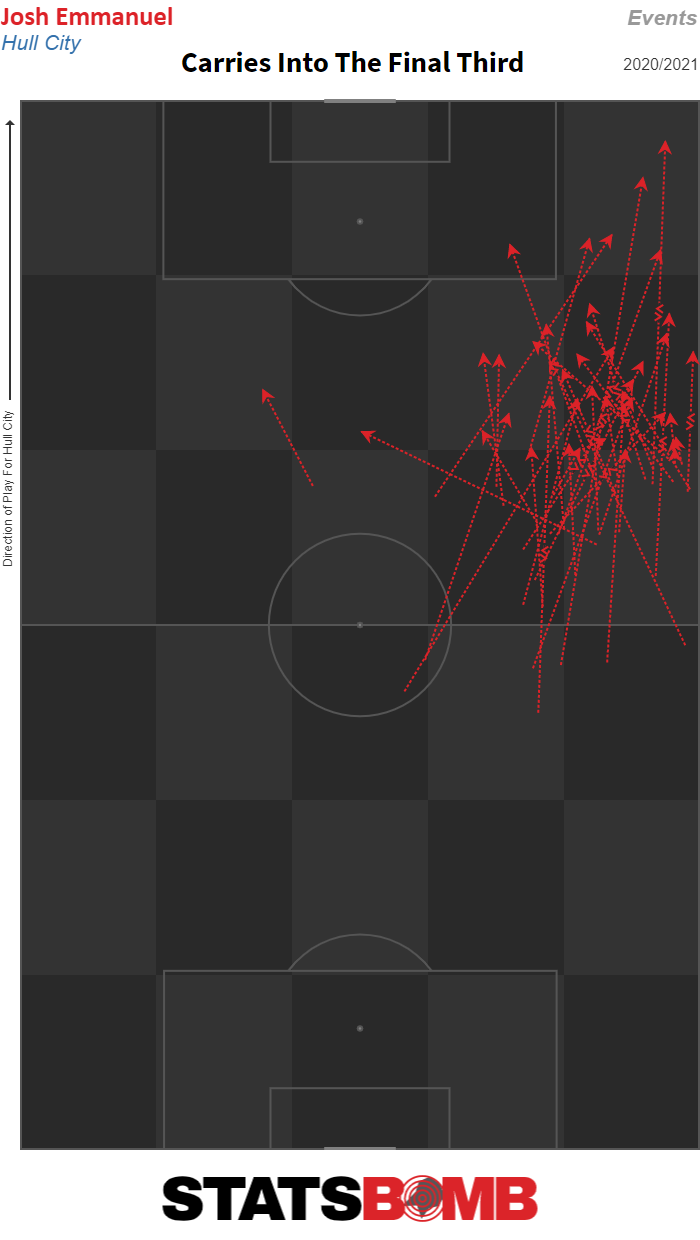
It’s not just carrying into space that he thrives in, he’s capable of taking the ball past an opponent too. Emmanuel’s completed the most dribbles of League One full backs this season and was behind only two others in 2019/20. This on-ball capability makes him a key player in the attacking phase of Hull’s game: making the second-most final third entries of his side, the third-most passes into the box, and has the third-highest xG assisted from open play.
6) Chuks Aneke: Bench Warmer, Ice Cold Finisher
A hark back to the good old days of sub-effects now.
Chuks Aneke is excelling in the role of super-sub this season. The Arsenal academy graduate has played in 20 of Charlton’s 25 games so far but made only seven starts to accumulate a total of 999 minutes - just 40% of the minutes available.
And yet…
Aneke has been absolutely smoking tired League One defences this season. Of his nine goals, just three have come in matches he’s started, the other six have come when being deployed from the bench. When he starts he scores at a rate of 0.52 goals per 90, when he comes off the bench it's 1.12 goals per 90.
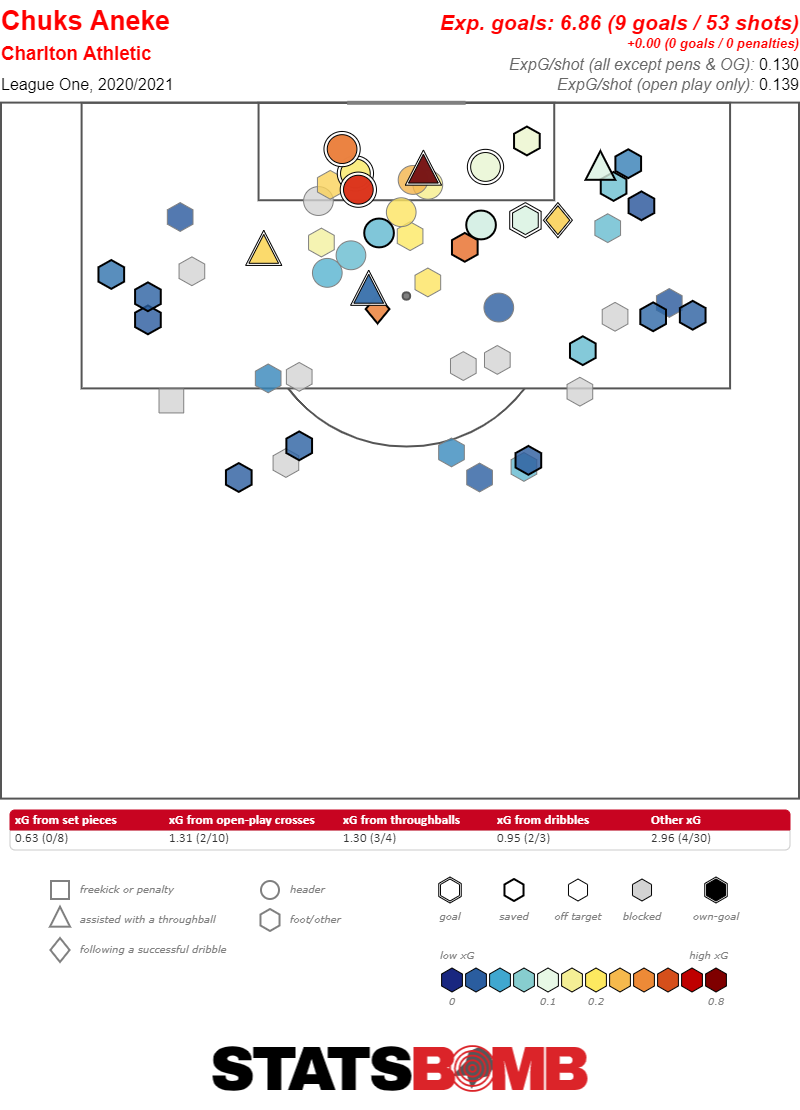
The sub-effects are real but that’s not to downplay his impact. Aneke is objectively (and subjectively) putting in some of the best forward performances in the league. Ignoring his monumental return off the bench, his contribution of 0.52 goals per 90 from the start would be the 5th best return in League One. All in, for players with at least 900 minutes played this season, Aneke is tops the league for all of Shots per 90, xG per 90, and goals per 90.
7) Max who? Max Watters
There's only one place to start in League Two and that's with probably the story of the entire EFL season up to now. Released by League One Doncaster after five forgettable appearances, Max Watters rocked up at Crawley Town in October to little fanfare, having only been spotted by the Crawley staff when playing against them in a friendly for non-league Maidstone United where he was on trial.
Three months, 15 appearances and 13 goals later, Watters was off to Cardiff City in the Championship for a reported seven-figure fee.
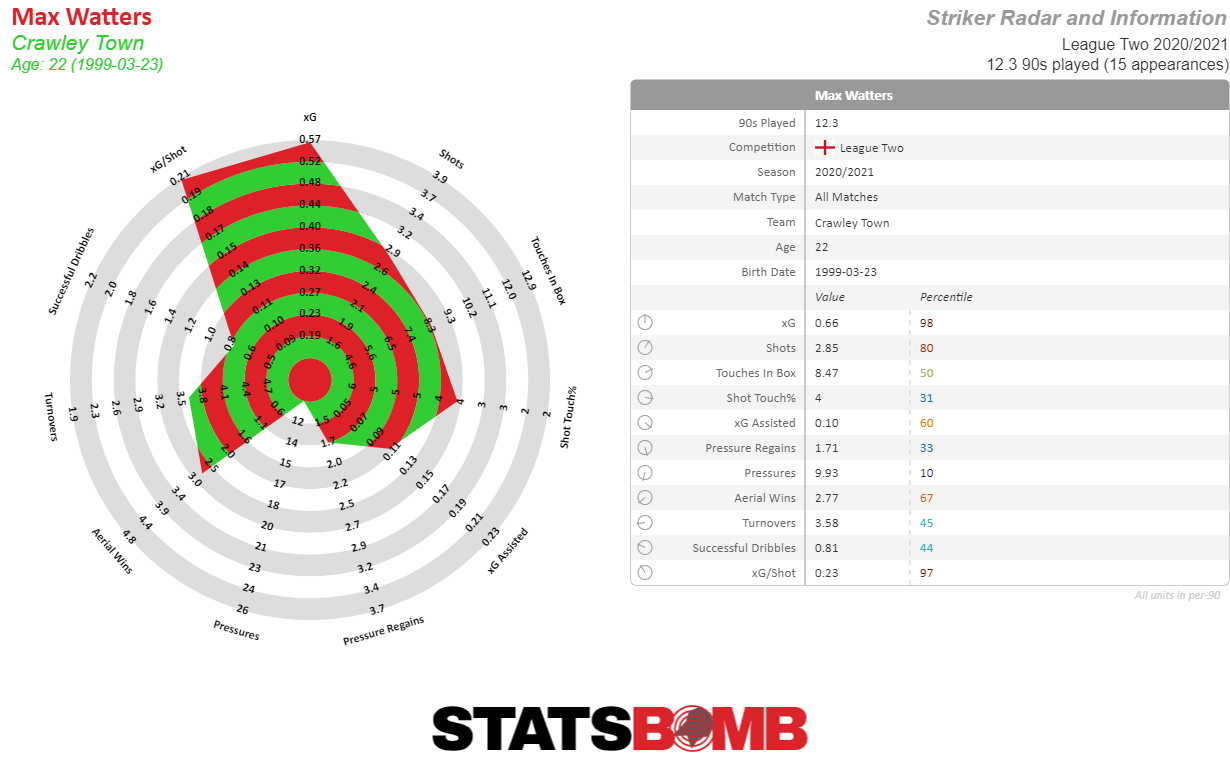
Watters was a touch ahead of his expected goals, notching his 13 goals from 8.1xG, but he repeatedly showed a nose for getting into good goalscoring positions and finishing in a variety of ways too - scoring with his left foot, right foot, or head - and with little-to-no wastage whatsoever in his shot selection. His rate of 1.06 goals per 90 was so extreme that it was nearly half-a-goal better than the next best record in League Two, and his 0.66 xG per 90 was also a clear standout ahead of the rest.
Just three months of very successful League Two football was enough to persuade Cardiff to give him an opportunity in the Championship. Returns like the ones he was making at Crawley would make the fee an absolute bargain.
8) Sunshine and Beechball in Cumbria
There were no signs in Carlisle’s unremarkable 2019/20 campaign to suggest they'd embark on a promotion push just months later, but here we are. With no discernible improvement in results, the November 2019 appointment of Chris Beech went largely under the radar last season, but behind the scenes foundations were being laid.
This season has seen a move to a style of play that pundits have christened “Beechball” – an energetic, high pressing and direct game that has brought praise for both its entertainment and its efficacy, with the Cumbrians currently top of the table by points per game.
Last season most of Carlisle’s defending was done in their own half, but this season they’re active much further up the pitch: their Defensive Distance – the average distance from a team’s own goal that it makes defensive actions – has shifted from 41.2 metres, 23rd in 19/20, to 47.4 metres, 1st in 20/21. It’s working too – Carlisle are conceding the fewest shots in the league.
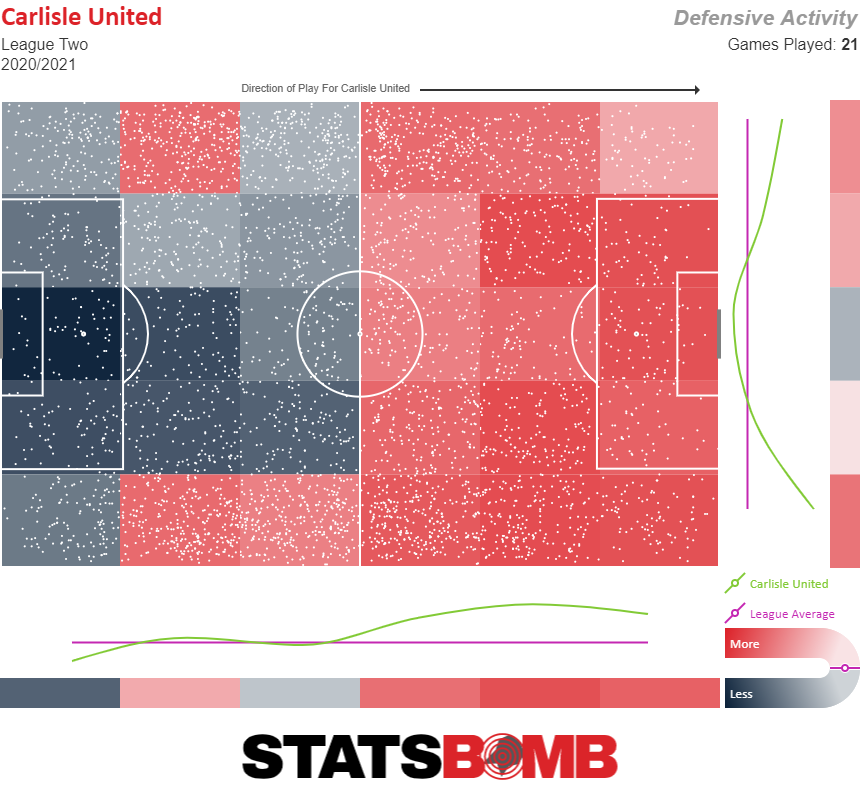
They’re also thriving in possession and pose a well-rounded threat. An average of 17.5 shots per game is the most in the league and three more than next best Newport County, and they’re generating opportunities from all phases of play. Carlisle rank 1st for counter attacking shots, illustrating their speed and threat in transition, but also rank 1st for set piece xG, with 0.48xG per 90. Significant output in this area could go a long way to helping their promotion push – creating half-a-goal a game from set plays, extrapolating to 23 goals over a full season, is a juicy cherry to put on top of the open play cake.
Even within set plays they’ve got all bases covered, creating regular chances from corners, indirect free kicks, and throw ins. The latter has been particularly noteworthy with winger Josh Kayode catapulting projectiles into the opposition penalty box at every available opportunity.
9) The Second Best Attack In The Country
Across England’s top four divisions, Exeter are second only to Liverpool for goals scored per 90 and xG created per 90. By xG per shot, they rank top.
Given the competitive balance in League Two, it’s a big surprise to see a team putting up numbers of that scale, particularly one that currently sits 9th in the table. The Devon-based club have implemented a style of play under manager Matt Taylor that sees them look to enter the box from high-value areas rather than playing into it from deeper positions. Almost all of their box entries have come once they have possession in the final third.
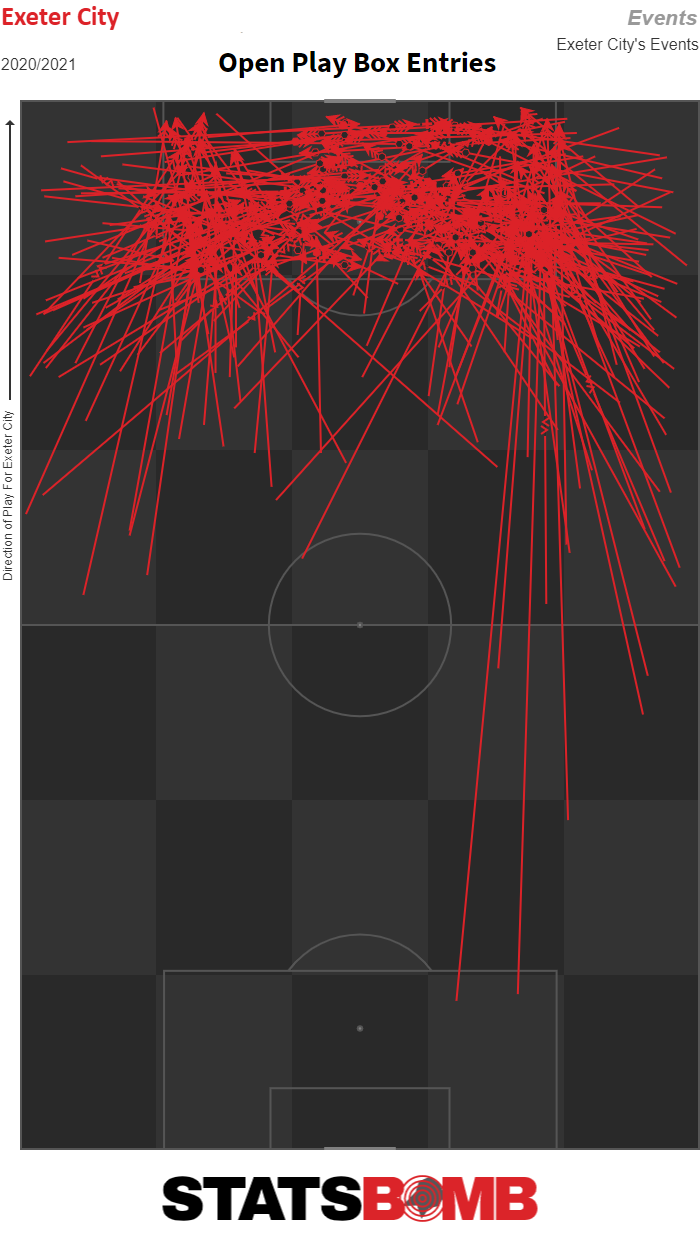
Watch an Exeter game this season and you’re guaranteed to see the ball being flashed across the face of goal or pulled back towards the penalty spot again and again.
The optimal execution of this strategy came in their November fixture at home to Colchester United, who had no answer for Exeter’s relentless probing of their penalty area. All six of Exeter’s goals that day came from within the six yard box and – typical manager interview cliché incoming – it really could’ve been even more.
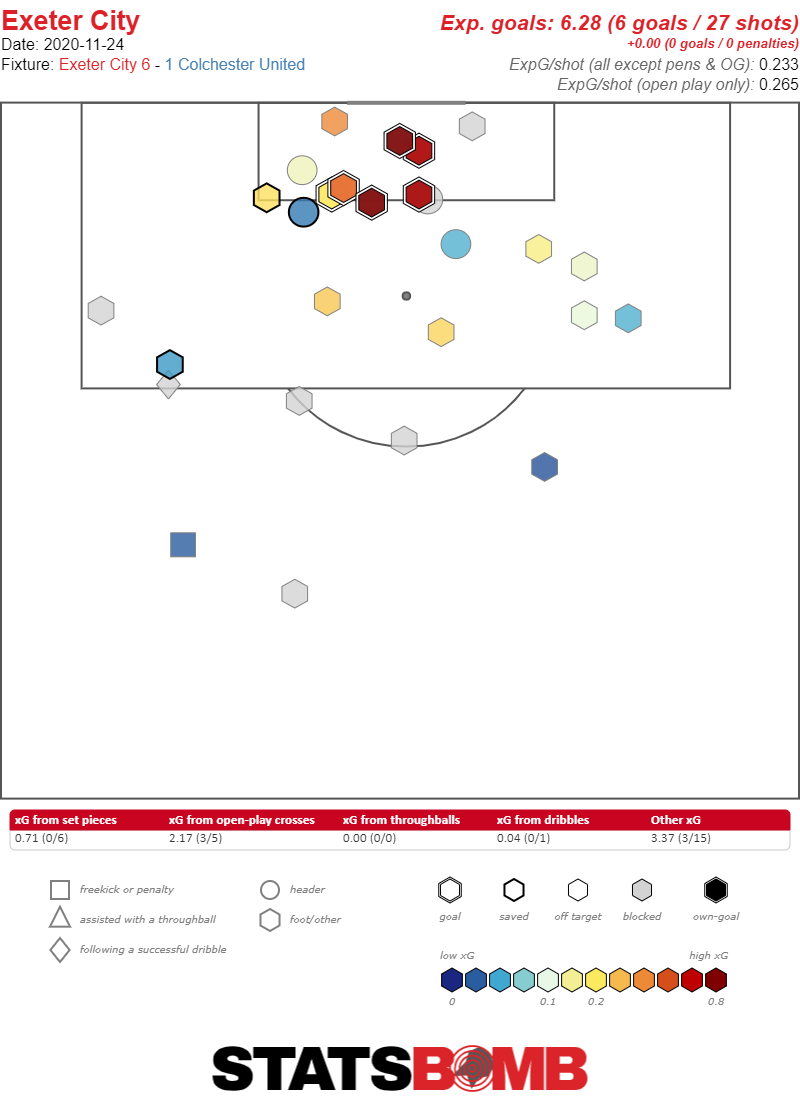
A case of blatant stat-padding, but even excluding that game Exeter still rank first in League Two for both xG created and xG per shot. Maintaining this level of creativity could see them go one better than last season’s play-off final defeat.
10) Lionel Wessi Seeing Out His Career In Cambridge
Contrary to Exeter, Cambridge take a slightly different approach to progressing the ball and getting into the opposition area. A strategy that makes total sense when you have a player of Wes Hoolahan’s – Lionel Wessi’s - skillset in your ranks.
The U’s, top of the league at the time of writing, are much more inclined to take a vertical approach through the centre of the pitch and Hoolahan’s driving runs and subsequent through balls have become a common sight at the Abbey Stadium. Even at 38, the class and quality that earned him over 100 Premier League appearances whilst at Norwich are still obvious and a major asset to Cambridge’s attacking game. You can pick out Hoolahan’s trademark slide passes through gaps in the opposition defence when looking at his open play passes into the penalty box.
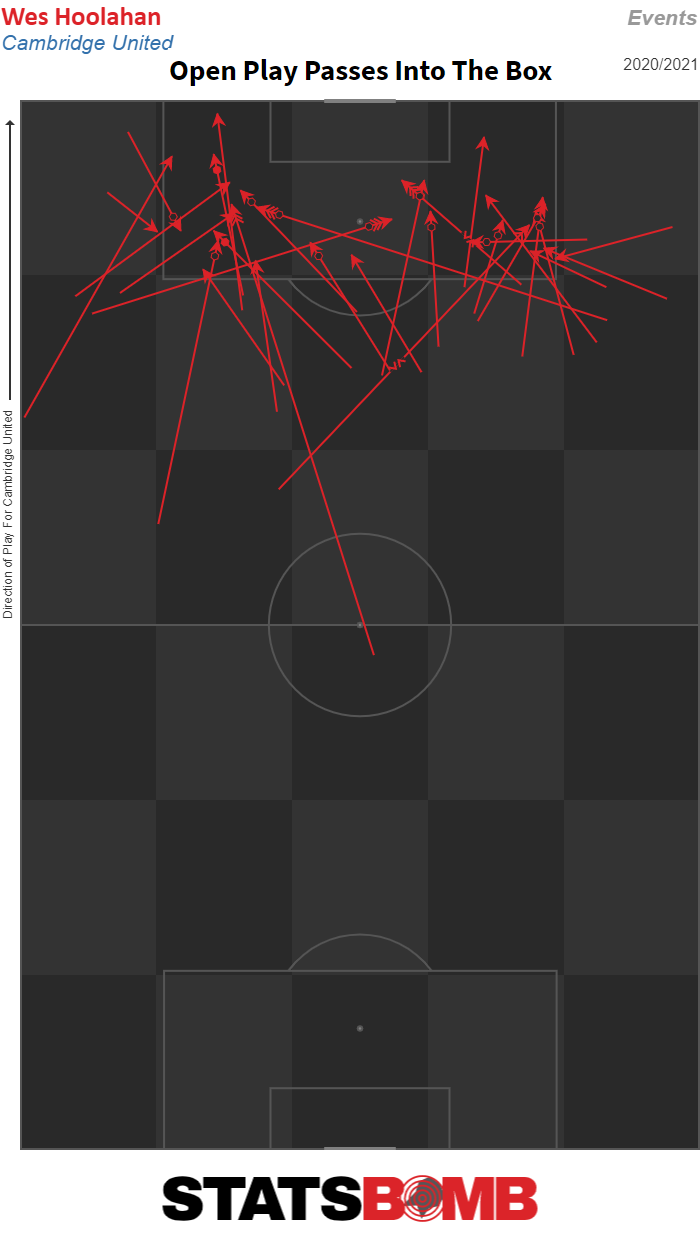
The creative spark in the midfield, on a per 90 basis Hoolahan ranks top in League Two for Carries of the ball and more importantly through balls, providing a high-class link between the middle and final third.
11) Bonus Nutmegs
Lastly, a small, nutmeg-flavoured palate cleanser now we’re at the end. Here's the top five Nutmeggers and Nutmegees of the 2020/21 EFL season. Enjoy.
Player |
Club |
Competition |
Nutmegs |
| Antoni Sarcevic | Bolton Wanderers | League Two | 8 |
| Adam Armstrong | Blackburn Rovers | Championship | 7 |
| Siriki Dembele | Peterborough United | League One | 6 |
| Scott Sinclair | Preston North End | Championship | 6 |
| Conor Wilkinson | Leyton Orient | League Two | 6 |
Player |
Club |
Competition |
Nutmegged |
| James Brophy | Leyton Orient | League Two | 5 |
| Emiliano Buendía | Norwich City | Championship | 4 |
| Oliver Rathbone | Rochdale | League One | 4 |
| Josh Laurent | Reading | Championship | 4 |
| Nathan Byrne | Derby County | Championship | 4 |
Join us at StatsBomb Evolve on March 17th 2021 to discover how we're going to change the football industry, including the launch of our new data product, StatsBomb 360. To find out more, click here.
English Players Abroad: German Bundesliga
Fraser Forster in 2016.
The first player based outside of England (in, er... Scotland) to be called-up for an England major tournament squad since Owen Hargreaves (Bayern Munich) and David Beckham (Real Madrid) for the 2006 World Cup.
With the recent trend of young English players turning their noses up at the perceived lack of available pathways at Premier League clubs, or seeking a cultural experience on different shores, there’s no denying that this generation of players are not shy of trying their hand away from home and it's highly likely Gareth Southgate's squad for this summer's Euros will contain at least one non-domestic based player.
Jadon Sancho’s 2017 move to Borussia Dortmund made him the poster boy for this movement, and he’s the obvious place to start in our round-up of young Lions that have landed in the German Bundesliga.
A rising star that went supernova is the only way to describe his 2019-20 season as Sancho contributed 32 non-penalty goals + assists (17G + 15A) at a rate of 1.21 per 90. Only Timo Werner (33 goals + assists) and, of course, Lionel Messi (39) contributed more in the big-5 leagues, and this was from a 20-year-old. The resultant hype was completely justified but expecting Sancho to repeat that was always going to be a big ask (for somebody not called Lionel Messi, at least).
To re-align expectations ahead of this season, one could point out that Sancho’s expected contribution numbers – his expected goals plus expected assists – for last season were behind, on a per 90 basis, those of Serge Gnabry, Christopher Nkunku, and Kevin Volland, to name just three in the Bundesliga.
All this to say, England's Bundesliga Beau has been having a tougher time of it in this campaign, netting just 2 goals and 5 assists in his 1287 minutes up to now. Let’s be clear, that’s still pretty good: it shakes out at a rate of 0.49 goals + assists per 90 - a goal or assist every 2 games. But, for a player many regard as having a talent worthy of gracing the pinnacle of the game, it’s not quite good enough.
Let’s look at the underlying numbers. This season is the first time in Sancho’s Dortmund career that he hasn’t overperformed on his expected numbers by quite a margin.
In 2018-19, he netted 25 G+A from 14.35 xG+xA. In 2019-20, it was 32 from 18.26. This season it’s 7 from 7.97. That’s comparing apples and oranges though, given the differences in playing time between the seasons. At a per 90 rate, his expected goal and assist numbers have remained strong across all three seasons: 0.49 in 18/19, 0.69 in 19/20, and 0.56 in 20/21. Whilst bearing in mind that 0.56 xG+xA per 90 is very impressive, it's still a noticeable drop on last season and suggests there's something going on besides the surface-level decline.
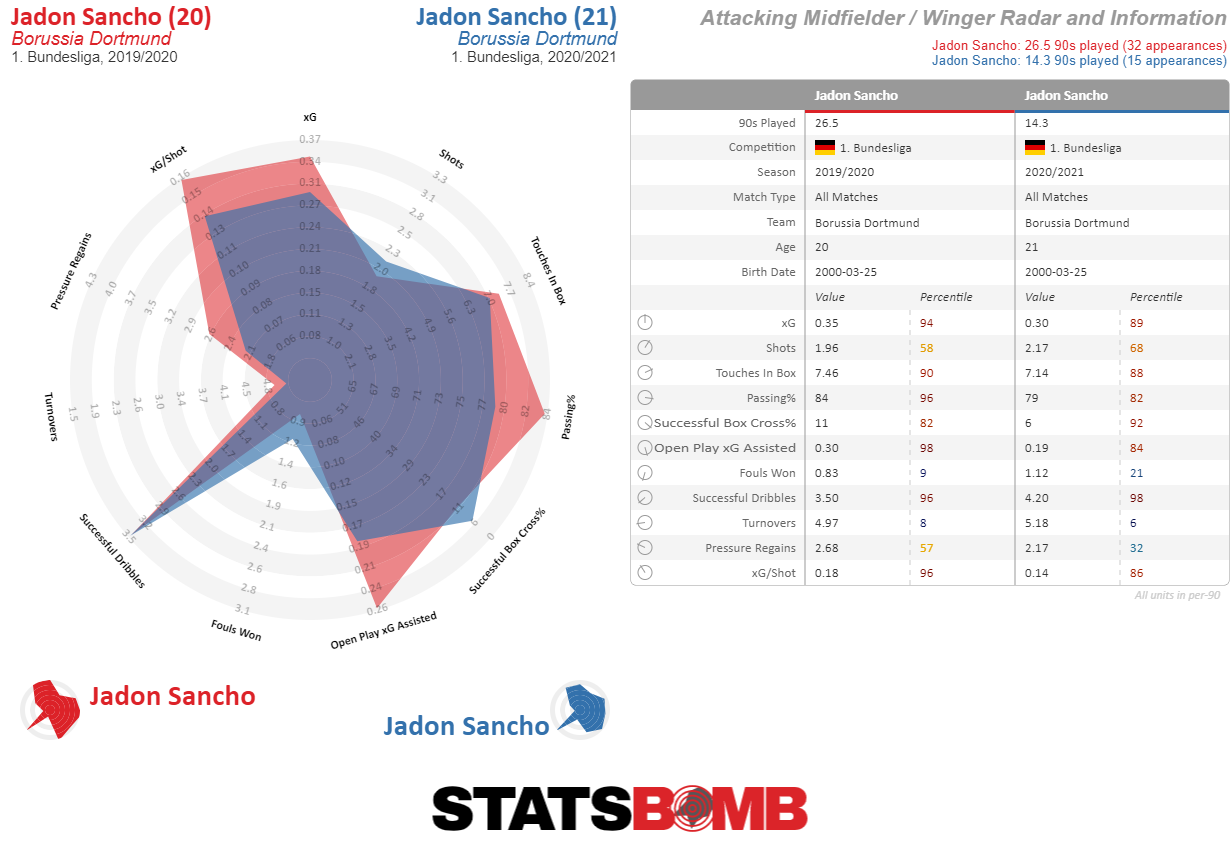
It's worth posing the question as to whether Sancho's issues are symptomatic of a bigger collective issue within Dortmund as a team, but no dice. Sort of. There is some symmetry between Sancho underperforming his expected numbers that Dortmund are also guilty of this season, but whilst Dortmund have improved their chance creation this season, Sancho’s output has receded. Let’s look into why.
His shot maps from the past three seasons reveal what might be going wrong in a goal scoring sense. There’s one type of chance that Sancho was getting previously that he hasn’t been this season: the high-probability, open-goal tap ins from ~6 yards out.
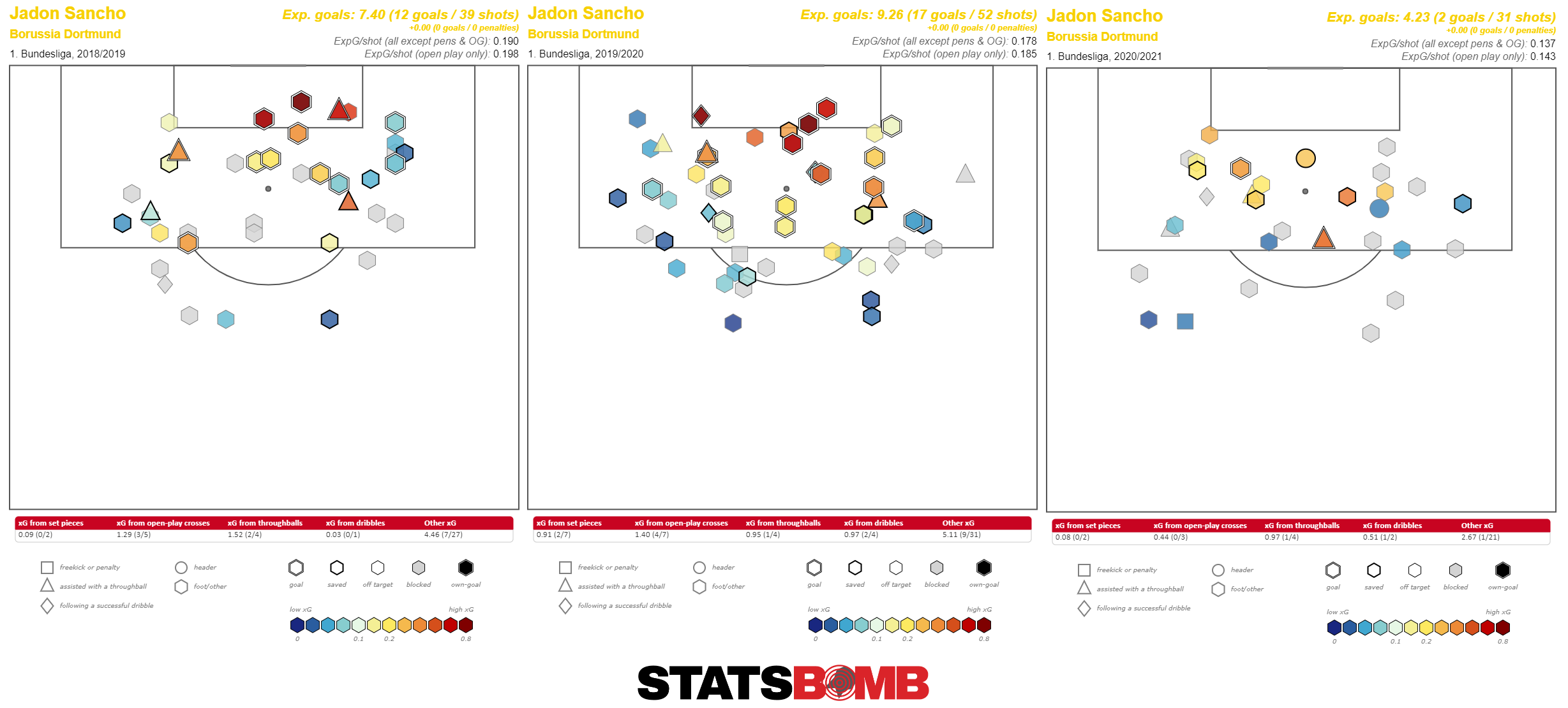
What is also obvious from the shot maps is that he just isn’t hitting the target as often this season. His Shooting % - the percentage of shots that are on target – is down from 54% last season to 23% this. Needless to say, that alone will cost you goals.
There are also issues creatively. His expected assist numbers in open play have dropped from a 1-in-3 expected-assister (0.30 OPxA) to a 1-in-5 expected-assister (0.19OPxA).
Drilling down, this appears to be an issue with his final ball. His dribbling numbers are up this season compared to last, as are his Open Play Passes Into the Box (3.57 per 90 up from 2.19), suggesting there's nothing wrong with Sancho's ability to progress the ball into dangerous areas. However, his passes completed inside the box have dropped from 1.09 per 90 in 19/20 to 0.49 per 90 this season. Once inside those dangerous areas, it's not coming off for him.
It could be that the increase in Successful Dribbles and Open Play Passes Into The Box but decline in goal-contributions are because Sancho’s playing a bigger role earlier in the attacking phase and he just hasn't been required to lay on the chances or apply the finishing touch as much as he was last season. Well, that theory gets debunked too when looking at the xGChain – a model that attributes the xG value of the final shot to all players involved in the entire possession - of Dortmund’s squad over the last two seasons.
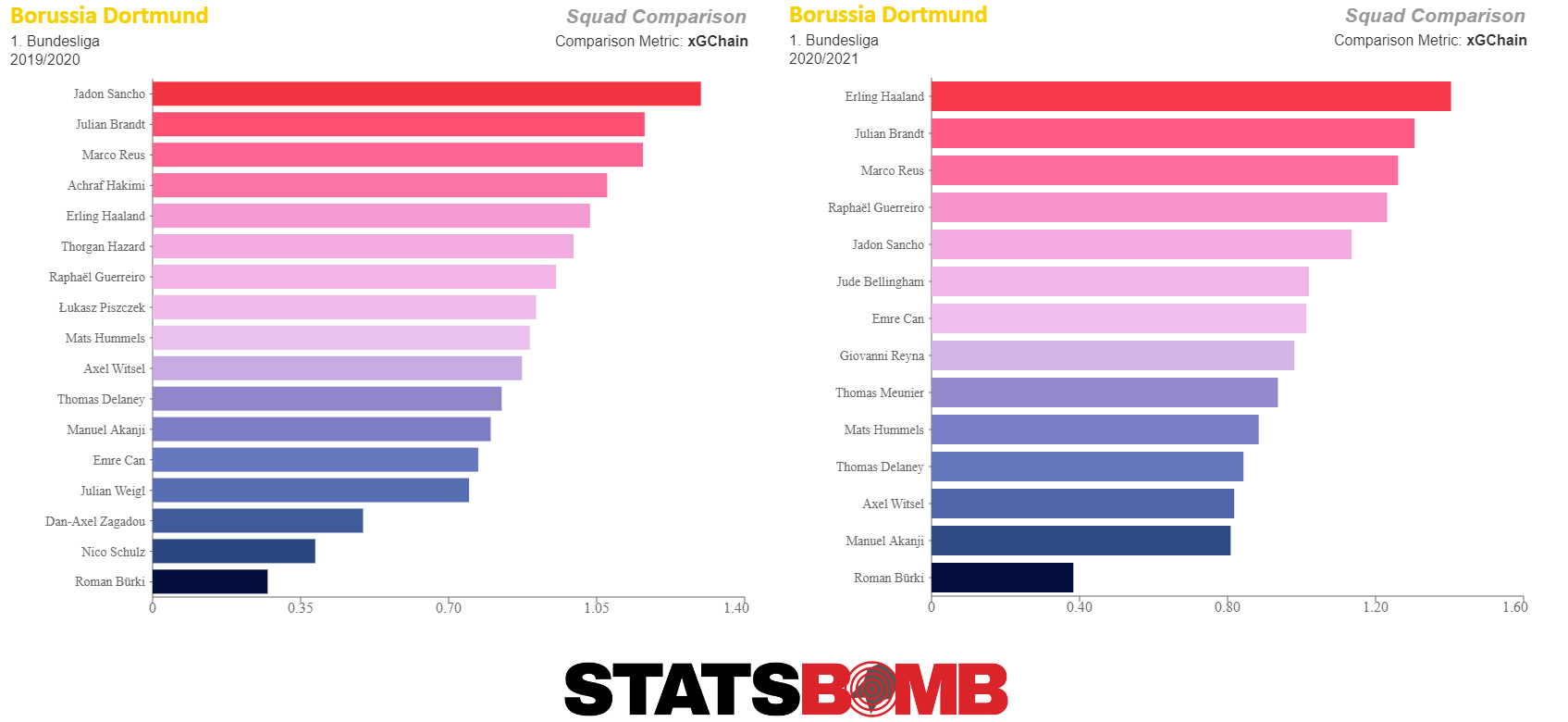
Sancho was consistently involved in Dortmund’s most-productive attacking moves in 2019/20, whereas he’s far less involved this time. So, either Dortmund aren’t moving the ball through Sancho as much or Sancho is being more wasteful with the ball.
The data would appear to suggest the latter. His pass completion % (I know, I know) is down from 84% to 79%, his Dispossessed rate is up, and so are the number of Turnovers he's registering.
Overall, it's been a much tougher campaign for the starlet this time out, but it needs stressing that this is in the context of his very, very high standards. It’ll be interesting to see whether his form picks up at all under new Dortmund interim coach Edin Terzic, following Lucien Favre’s sacking.
Sharing the Dortmund dressing room with Sancho is Jude Bellingham, who's enjoying another positive campaign.
In case you need reminding, Bellingham banked 32.0 English Championship 90s last season at the age of 16(!). He can’t drink or drive, but he can outclass experienced professionals twice his age and look comfortable in a physically demanding league. Those who watched him last season will know that the amount of first team minutes was in no way premature, nor was the transfer and size of fee that sealed his move to Dortmund, and nor are the steady stream of minutes he’s now getting in the centre of one of the most talented teams in the world.
A mix of starts and appearances off the bench has seen him feature in 7.8 90s - about 40% of the league minutes available so far - and he’s already making an impression in the Bundesliga. Bellingham famously wears the #22 shirt because he can play in all of the ‘4’, ‘8’, or ‘10’ midfield roles and his Jude-of-all-trades skillset has been on display: contributing in breaking up opposition attacks, playing combination passes in buildup, carrying the ball through the centre of the pitch, or making runs beyond the defensive line to get on the end of chances.
With the extreme caveats that he’s only featured in <8 games worth of minutes so far and will have enjoyed the sub-effect benefits of having fresh legs off the bench, here’s how his output this season compares with his output at Birmingham last season.
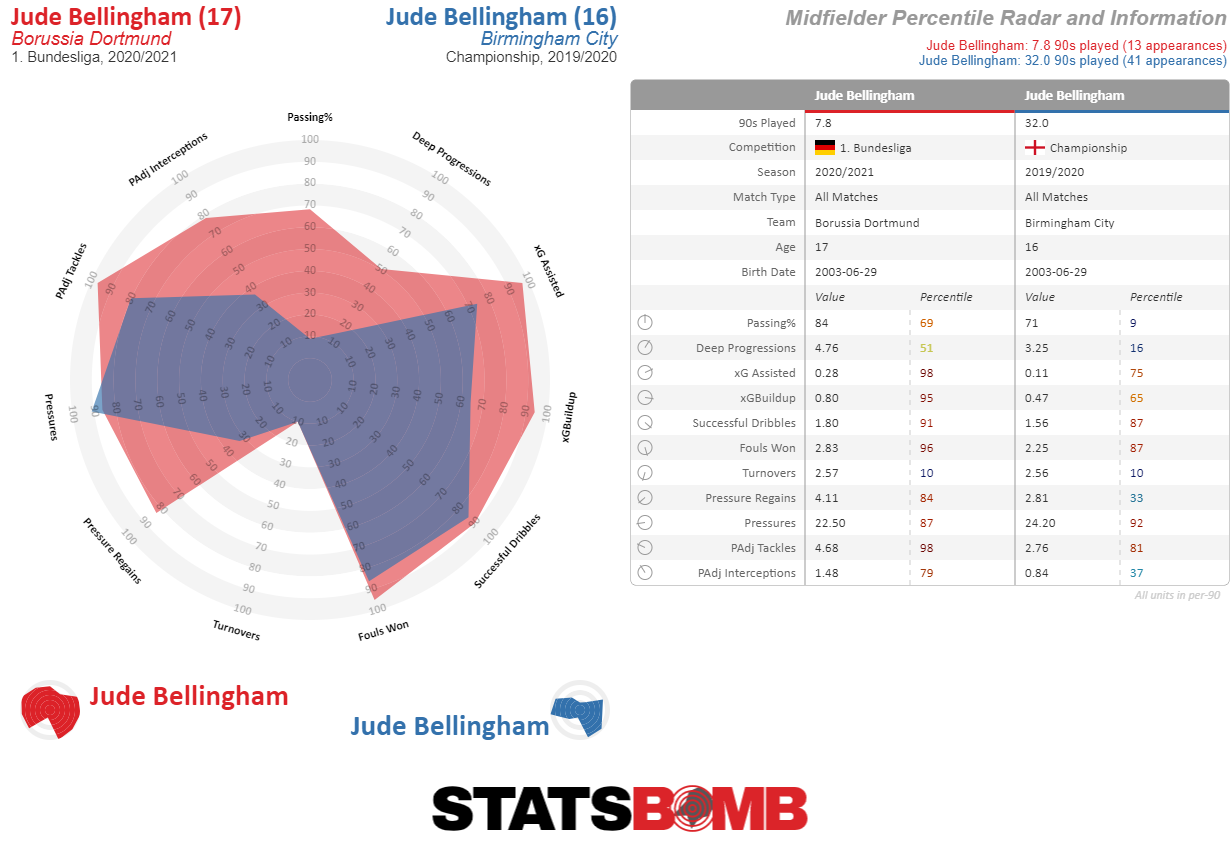
Stepping foot on the pitch for a club of Dortmund’s pedigree at his age would be a good enough indicator of his talent, but Bellingham has already been having a positive influence on the team and making a valuable contribution in every third. Add in the fact that he made his England Under-21 debut in September and his senior England debut in November, it’s been another season of rapid progression for the youngster and there’s half of it still to play. Not bad for a kid who turned 17 in June.
As if one 2003-born Englishman getting regular Bundesliga minutes at a German giant wasn’t enough, Jamal Musiala makes it two having muscled his way into the Bayern Munich first team setup this season.
Moving to Bayern’s youth setup from Chelsea in the summer of 2019, Musiala became the Bavarian behemoth’s youngest ever Bundesliga player when he came off the bench against Freiburg at the end of the 2019-20 season, aged 17 years and 115 days. It’s said that even Bayern are surprised by the speed at which he has progressed since joining the club: in just over a year, Musiala has moved through Bayern’s under-17’s, under-19’s, and reserve team to join the first team.
This season has been another leap in his rapid progression. Musiala has made 13 Bundesliga appearances – 2 starts, 11 off the bench – and has accrued 405 minutes by the mid-way point in the season. Like Bellingham, these aren’t token minutes geared at giving them experience and game time, Musiala has also made telling contributions to Bayern’s season already, his technical ability and impressive work ethic out of possession showing him to be already capable of contributing at this level. It’s a similar story in the England youth setup, with him making his Under-21’s debut in November. Some of his teammates and opponents in that game were five years his senior.
His first goal, becoming Bayern’s youngest ever goal scorer in the process, came on the opening day in the 8-0 thrashing of Schalke 04, cutting in from the left flank to finish clinically inside the near post from 16-yards, but his most impressive moment so far came in the top of the table clash against RB Leipzig on December 1st.
Having made his first start for the club versus Werder Bremen two weeks prior, Musiala was trusted to be first sub off the bench on 24 minutes after an injury to Javi Martínez, coming on ahead of a more direct replacement in Marc Roca. He made his mark within 5 minutes of coming on, bringing the scores level with another technically-accomplished finish from the edge of the area.
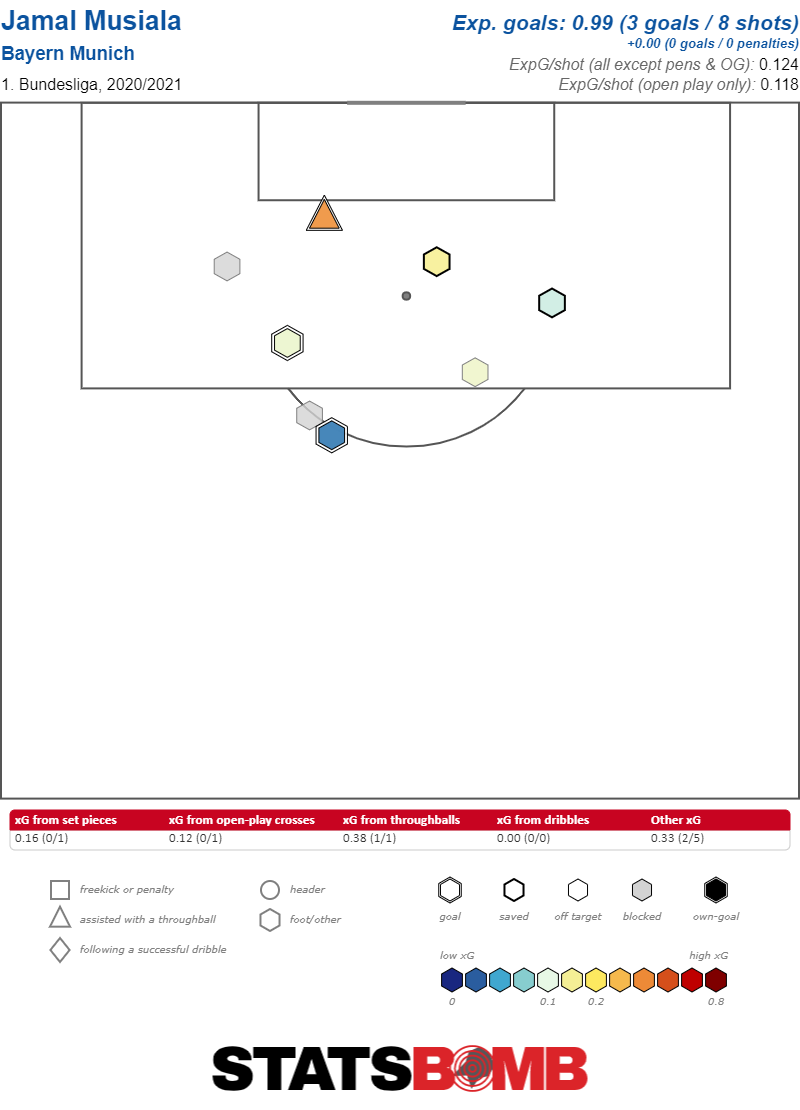
A series of impressive cameos and goal scoring contributions have justified Hansi Flick’s trust in throwing him into the first team so quickly and it leaves him in a good position to continue picking up valuable development time on the pitch and take part in a title race in the second half of the season.
Last but not least: Ryan Sessegnon.
With Spurs seemingly viewing Sessegnon's long-term future at left-back, as opposed to a more advanced role, a move to a club that would a) play him there but b) allow him to harness his innate attacking instincts was key for his development. It looks like he's found that at Hoffenheim.
On the surface, it’s so far, so good. He’s getting the game time he desired when making the move, playing 891 minutes – 54% of the available minutes in the Bundesliga - and his performances have been productive too, netting two goals in trademark style: calm, close-range finishes from the left-hand channel of the box after making a run inside from the wing. Sessegnon's form was so good in November that he won the club's player of the month award.
Means a lot to have been voted by the fans as the @tsghoffenheim Player of the Month and appreciate all the support I've been given since joining. Enjoying being a part of the team and will keep working hard to achieve our goals for this season. Vielen Dank! 🙏🏿 💙 #TSG pic.twitter.com/jpkFvbpaI4
— Ryan Sessegnon (@RyanSessegnon) December 2, 2020
The regular gametime in his long-term position has been crucial to Sessegnon's progression after an injury-hit first season at Spurs. Playing at left back in the Bundesliga will develop his defensive game through being tested by the calibre of wide players found in a top 5 league, but Hoffenheim's style of play also allows him to continue to influence the game in the final third. His touch map shows that he has the license to play his natural game, get up and down the flank and come inside to attack the box when Hoffenheim are in the attacking phase.

Things are looking rosy for the latest set of English imports to the Bundesliga. There's plenty of reason to keep a close eye on their development and progress in the home stretch of the campaign.
Join us at StatsBomb Evolve on March 17th 2021 to discover how we're going to change the football industry, including the launch of our new data product, StatsBomb 360. To find out more, click here.
In Review: The 2020 Swedish Allsvenskan
After the 2019 Allsvenskan season ended in dramatic fashion - Djurgårdens taking the title from Malmö and Hammarby by a single point on the final day, after coming from 2-0 down to draw 2-2 - the 2020 edition had a tough act to follow.
IFK Norrköping were quickest out of the blocks, going 6-2-0 in the opening eight rounds to build a strong lead at the top of the table. Talismanic forward Christoffer Nyman and tricky winger Sead Hakšabanović – eventual top scorer and top assist maker in the league - were dovetailing to great effect at the top of the pitch, with support coming from an unlikely source in centre back Rasmus Lauritsen, responsible for 3 goals and 3 assists in the opening period of the season.
Jens Gustafsson and his team were aiming to go one better than their 2018 title challenge and the early underlying numbers suggested they were on their way to doing so: the Östergötland-based club had the best expected goal difference across the league after eight games. This was largely thanks to an attack that had notched 18 goals (plus 2 penalties) from 13.38 xG, an expected goals figure that was league-best at the time.
However, as we can see from their expected goals trendline, the team were unable to maintain their strong early-season form. As performances dropped off, so did results.
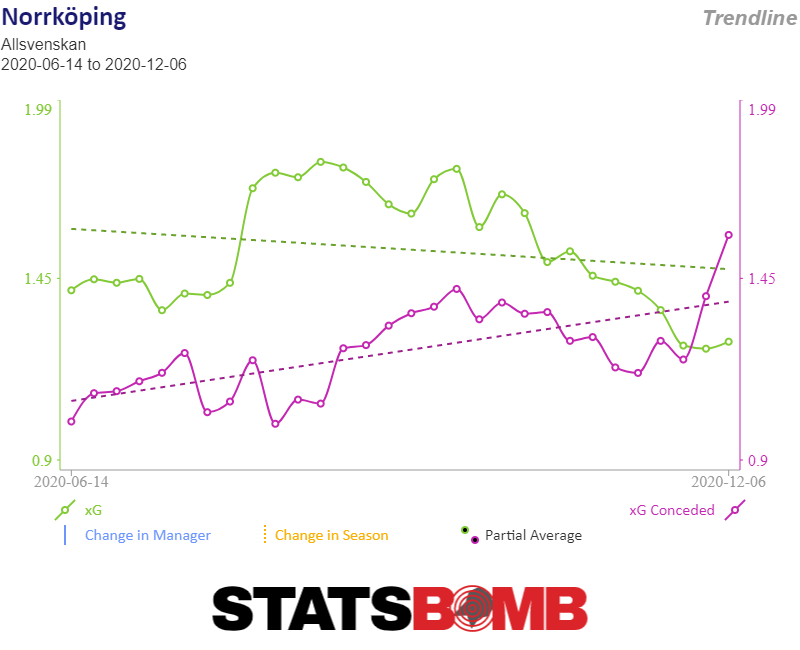
Malmö took full advantage. New manager Jon Dahl Tomasson’s reign had begun steadily and they sat seven points behind Norrköping after that eight game period due to a 3-4-1 start to the season. But, just as Norrköping’s engine faltered, Malmö went pedal-to-the-metal, winning their next eight fixtures in a row to ascend to the top of the table.
The approach in those wins was apparent as Di Blåe imposed their game on the opposition, defending further up the pitch and playing as much of the game in opposition territory as possible. Their Defensive Distance – the average distance from a team’s own goal from which it makes defensive actions – was 53.4 metres through this period, much higher than their average of 49.4 metres across the full season. That was matched by an aggressive press; Malmö recorded 629 pressures in the opposition half through this eight game spell, the highest in the Allsvenskan, and their ratio of pressures in the opposition half versus their total pressures of 59% was also a league-high.
The opening goal of their July fixture away to Östersund set the tone in this regard. As Östersund tried to play out from the back, Malmö formed a very high block and forced the home side to play a rushed clearance to the halfway line. Centre-half Oscar Lewicki made the interception and a string of quick, forward passes saw Ola Toivonen finish a Marcus Antonsson cutback unmarked 12-yards out, just seven seconds after the turnover.
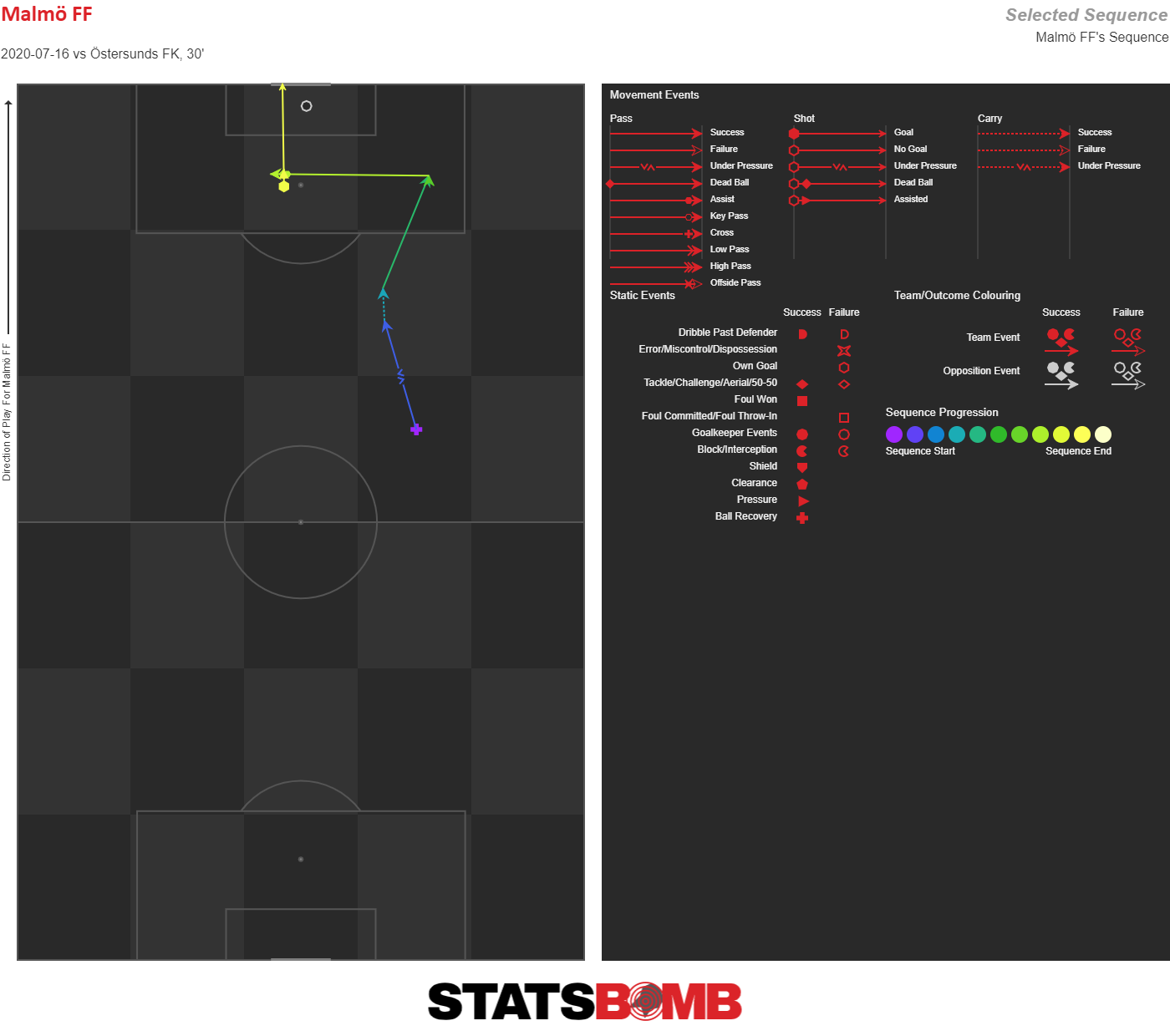
That run of form saw them move into top spot after gameweek 13, a position they would hold onto for the rest of the season in a dominant campaign. They went the entire season unbeaten at the Eleda Stadion, taking 11 wins and 4 draws from their 15 home fixtures, and a goal difference of +34 was more than twice the value of the next best goal difference in the league. Of course, a well-rounded side wouldn't be complete without a solid record from set-plays too; Malmö netted the most set-play goals in the league and also had the joint-best goal difference in this phase of the game.
2019 Allsvenskan 'Midfielder Of The Year' Anders Christiansen retained his title after another season of commanding performances in the middle of the Malmö midfield, and went one better in 2020 to claim the league’s 'Most Valuable Player Of The Year' award for the season too. The Dane was a key contributor on both sides of the ball but his ability to knit defence to attack in particular was crucial in the club’s 21st Allsvenskan title win.
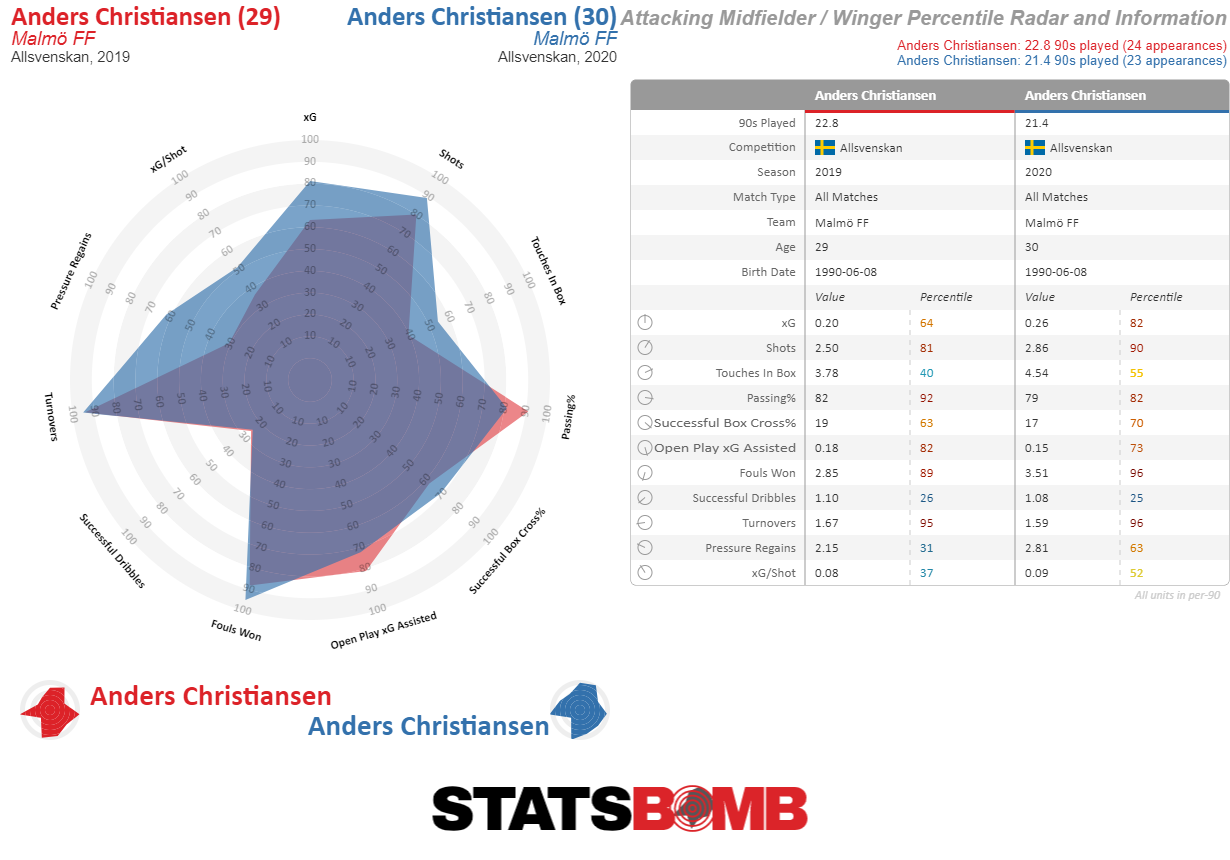
In the battle for European qualification, IF Elfsborg and BK Häcken edged out Djurgården to finish 2nd and 3rd respectively and enter the 2021/22 UEFA Europa League competition.
Djurgården, Allsvenskan Champions in 2019, finished just 1 point behind Häcken and might be frustrated not to have secured a top three finish on the back of some very robust defensive performances. Their 25.8 expected goals conceded, not including penalties, was the best record in the division by this metric, whilst their 0.08 xG per shot conceded ranked 2nd best, reflecting their ability to stifle the opposition from creating quality chances. It was underperformance at this end of the pitch, conceding 31 goals, that ultimately cost them a European qualification spot.
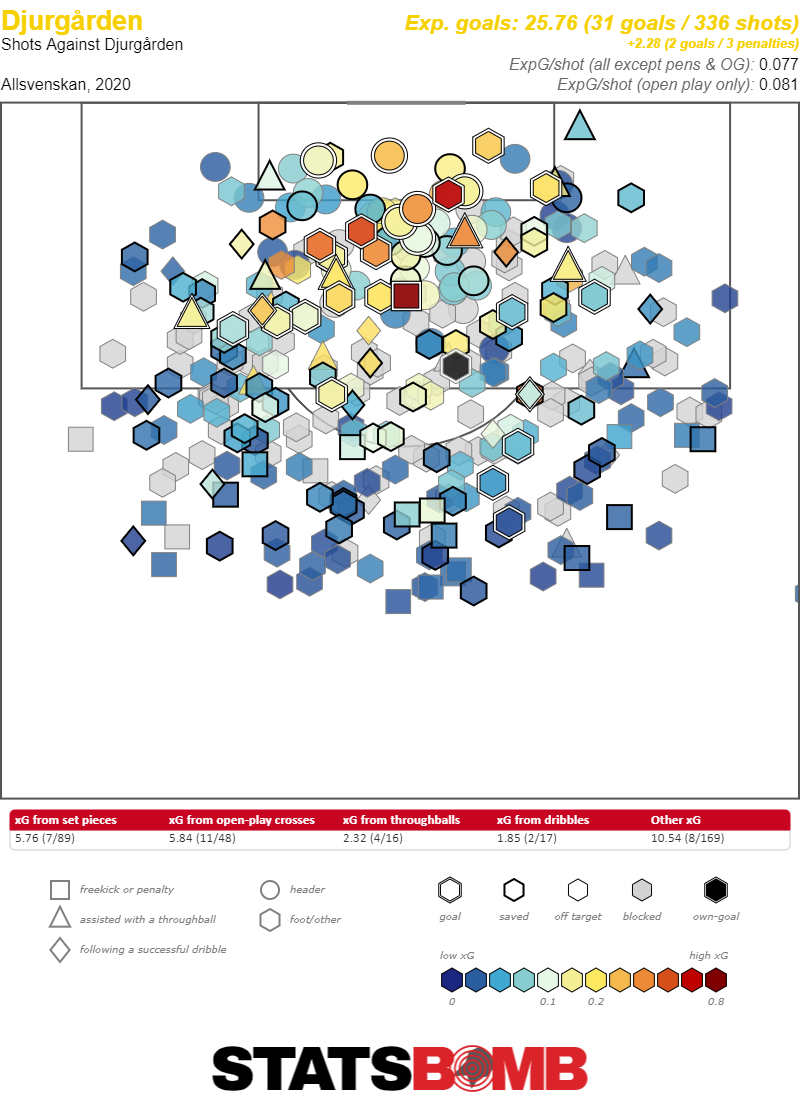
Runners-up Elfsborg had many of the league’s standout performers. Per Frick worked hard up front allowing Rasmus Alm and Simon Olsson to flourish behind him, while Johan Larsson was also a key contributor from right back, finishing as the club’s top assist-maker with 6 having registered both the most Key Passes in the league and the most xG assisted.
It was Allsvenskan 'Forward Of The Year' Jesper Karlsson who stole the show for Di Gule though, his performances on the wing earning him a September transfer to AZ Alkmaar in the Eredivisie.
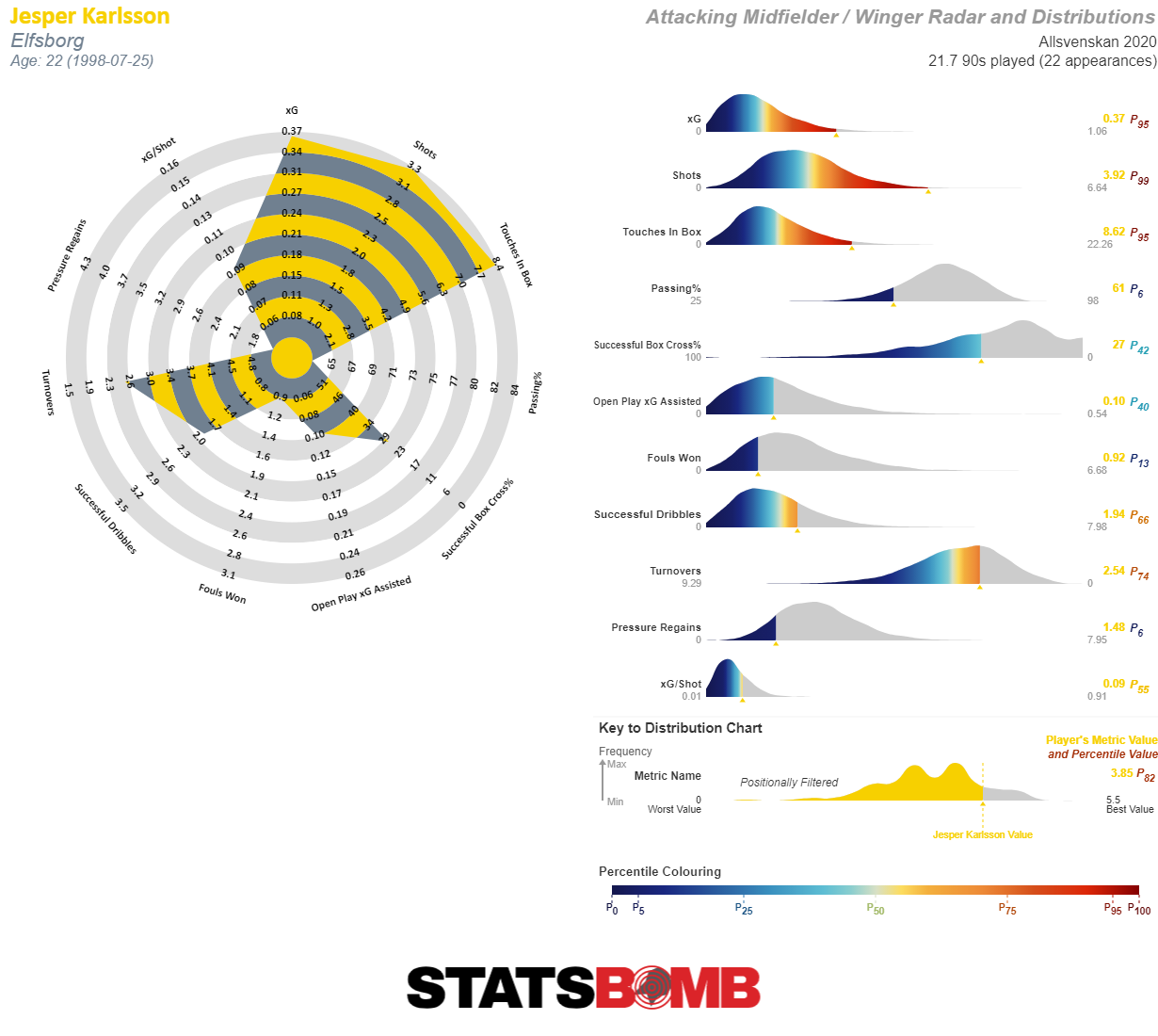
3rd place was BK Häcken’s highest placing since the 2012 season and their front-foot approach was central to their success. The Gothenburg side repeatedly showed their ability to quickly create shots off turnovers as they ranked joint-2nd for High Press shots - shots generated within 5 seconds of a defensive action in the opposition half - and tied it together effectively with their direct approach in transition, creating the most shots from counter attacks in the league.
Star player Daleho Irandust was central to this approach as his driving runs through the centre of the Bravida Arena pitch to carry Häcken into the attacking third were a regular sight, and his creativity in the final third saw him accrue the 2nd-most xG assisted from open play across the entire Allsvenskan. His high output in this area was a sizeable reason why he was recently identified as having a similar style to Atalanta keystone Papu Gómez by the Similar Player Search tool in our IQ platform.
As exciting as it was at the top, some of the brighter storylines were to be found further down the league table. To say that newly-promoted Mjällby adapted to their new surroundings with ease to stay up comfortably would be an understatement. Returning to the top flight after their 2014 relegation, the Hällevik-based club finished 5th, a club record, and their tally of 47 points was only four behind runners-up Elfsborg at the close of play.
It was a combination of deep defending and wise shot selection that powered the surprise package to their lofty position: up front the side paired the 3rd-best xG per shot with the 3rd closest average Shot Distance, taking the fewest shots from outside the box in the process. At the back, the team combined the 2nd highest Passes Per Defensive Action with the lowest percentage on StatsBomb’s Aggression metric at 17% (the proportion of an opponent’s pass receipts that are tackled, fouled or pressured within 2 seconds), prioritising their defensive shape over engaging the opposition.
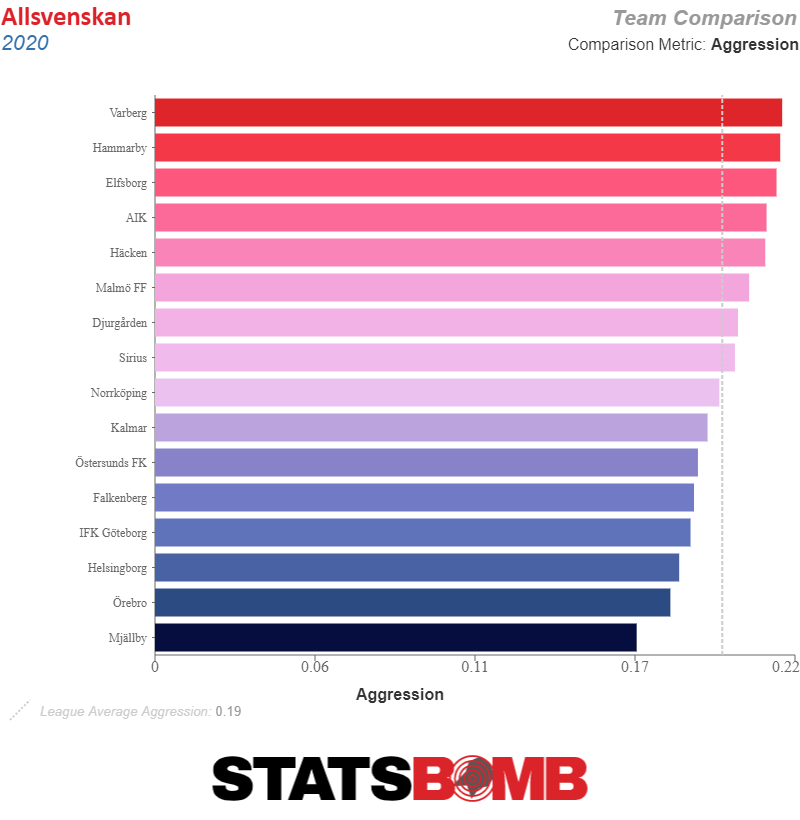
Which brings us to Varbergs BoIS.
Promoted alongside Mjällby and themselves making their debut in the Swedish topflight, the West Coast side led by Joakim Persson took a different approach to that of their fellow Allsvenskan newcomers. While Mjällby were happy to sit in their shape out of possession, Varberg were much more proactive in their defensive approach and recorded the most Pressures as a team in the 2020 Allsvenskan season, actively engaging the opposition across virtually the entire pitch.
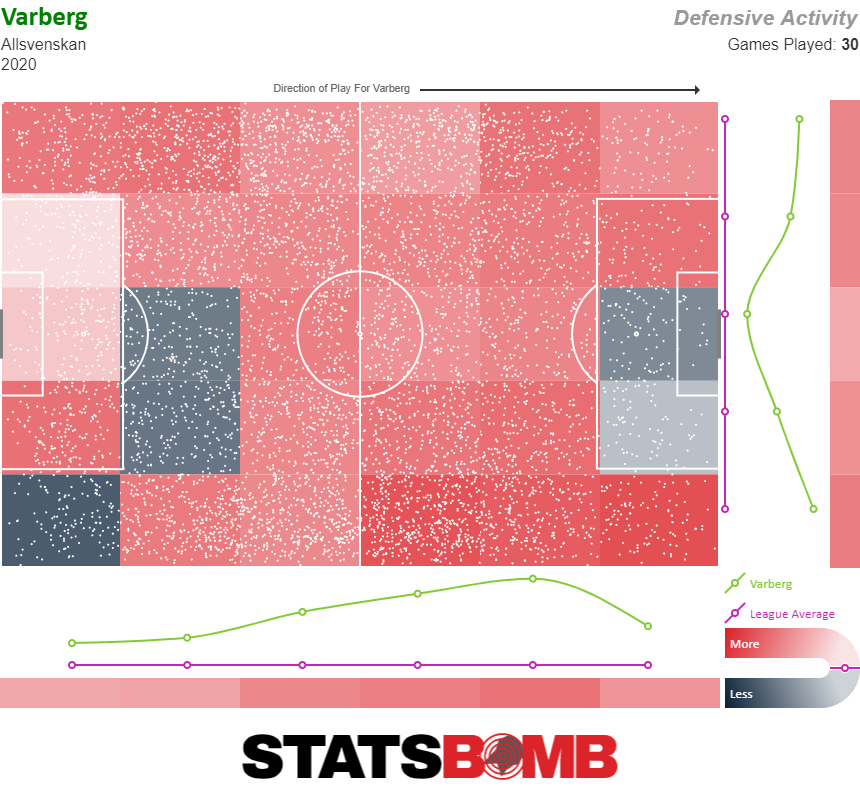
Star of the show for 7th-placed Örebro was undoubtedly goalkeeper Oscar Jansson, whose efforts were recognised with a 'Goalkeeper Of The Year' award. Örebro finished the season with a -4 goal difference, but with a -16.8 expected goal difference (including penalties). Such a large discrepancy wasn't solely down to Jansson's heroics, but the data still shows the former Tottenham Hotspur 'keeper to be a worthy winner of the award: StatsBomb data ranked Jansson as having the 2nd best Shot Stopping %, relative to the quality of the shots he faced, in the league, as well as ranking 2nd in StatsBomb's "Claimable" metric, a measure of how likely a goalkeeper is to claim a "claimable" pass.
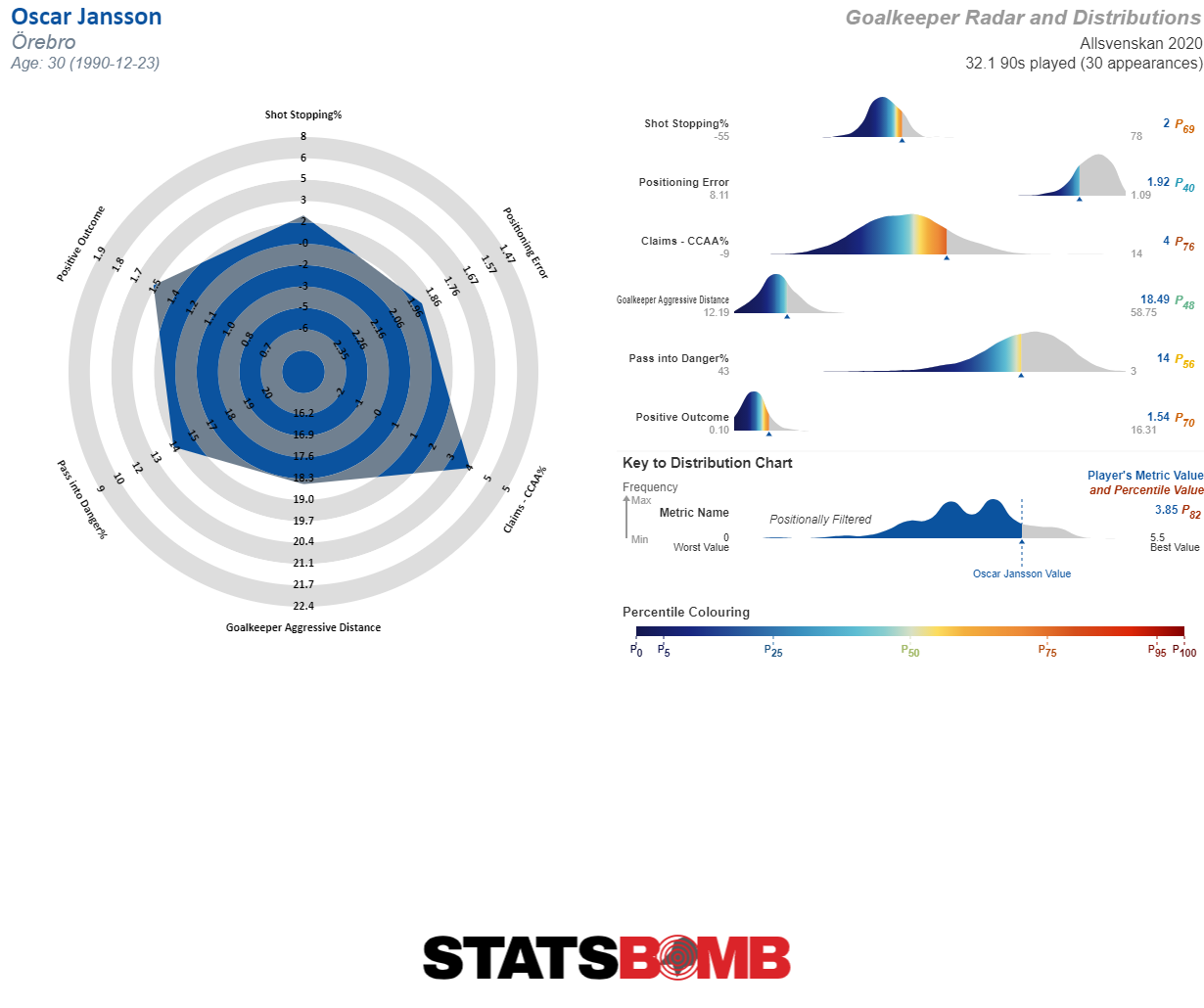
At the bottom of the table, a three-horse relegation battle was eventually won by Kalmar, consigning Helsingborg and Falkenberg to the 2021 Superettan. Kalmar’s defence-first approach in the final few weeks of the season saw them keep four clean sheets and pick up nine points from their final six games to overtake their rivals at the bottom of the table, having sat bottom of the league as late as gameweek 26.
Their penultimate fixture away at AIK was the key result, an 83rd minute Erik Israelsson goal from a corner securing a win that, combined with Helsingborg’s draw with Falkenberg, confirmed that Kalmar would avoid automatic relegation.
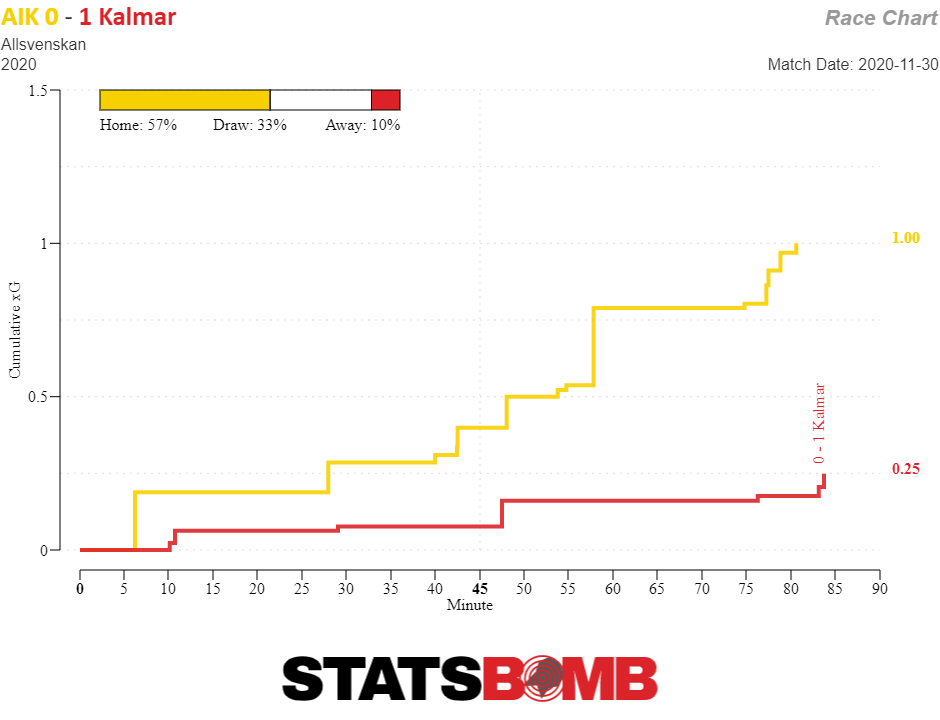
Their 2021 Allsvenskan place was finally confirmed after a 4-1 aggregate victory in the relegation/promotion play-off over Superettan’s 3rd-placed side Jönköpings Södra. With Helsingborg and Falkenberg dropping a division, their places will be taken in the 2021 Allsvenskan by Superettan champions Halmstads BK and runners-up Degerfors in what promises to be another lively campaign.
If you are a club, media or gambling entity and want to know more about what StatsBomb can do for you, please get in touch.
Fulham: Season Preview 2020-21
Let’s start with a question. Did Fulham deserve to go up? A provocative query and, sure, it suggests I’m going to lead the argument down a certain path but, before you blow your thatched rooftops Cottagers fans, the answer is actually both yes and no. Let me explain. Scott Parker was handed the managerial reins on a permanent basis last summer, after his caretaker stint at the end of their Premier League relegation season. An immediate return to the top flight was a realistic expectation as the majority of the side that achieved promotion in style under Slaviša Jokanović in 2017/18 was retained. Parker, himself having played under Jokanović, set about implementing a similar high-possession framework to the side that went up two seasons prior and he succeeded; at 61%, Fulham were second only to Leeds in average ball possession. Something wasn’t quite the same though. Under Slaviša, it was swashbuckling. Under Parker, it was pedestrian. Previously, it was possession as a means to attack, now it seemed to be possession as a means to defend. Relative to their promotion rivals, the Cottagers struggled to turn their ball and territory control into meaningful goalscoring opportunities and it left them always seemingly hanging onto the coattails of the top two rather than leading the charge with them. The big issue was that the side very rarely took advantage of the space available in transition when winning the ball back. Quickly (ironically), the ball would get circulated between midfield and defence until the opposition had managed to reset themselves into their defensive shape, the result being that Fulham had the slowest Pace To Goal – the average speed (in metres per second) of buildup play that results in a shot - in the Championship by some way. 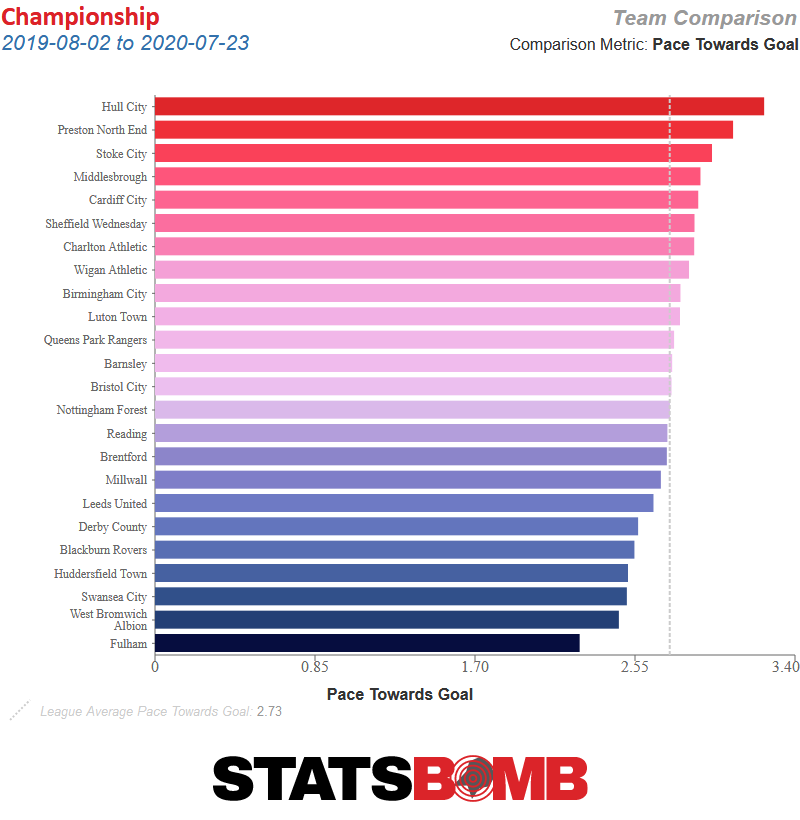 Their aversion to breaking quickly was evident in the lack of counter attacking opportunities generated, something that Jokanović’s side were not afraid to do if the space was available.
Their aversion to breaking quickly was evident in the lack of counter attacking opportunities generated, something that Jokanović’s side were not afraid to do if the space was available. 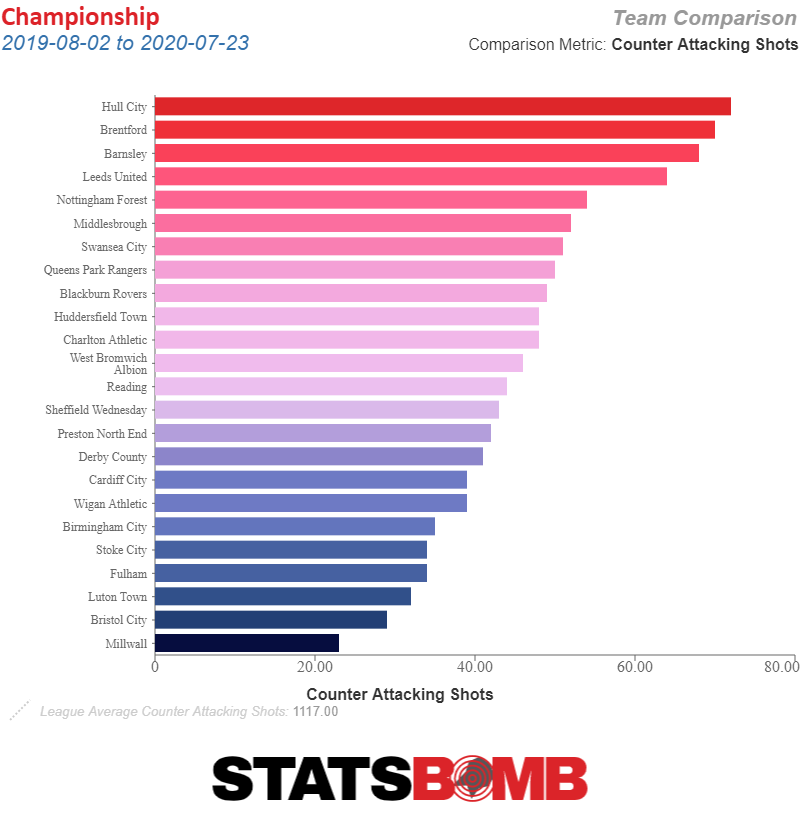 Logic dictates that you’re only going to make things more difficult for yourself if you commit to attacking against a set defence all the time and it was evident in the metrics; Fulham’s 1.18xG created per game was some way behind promotion rivals Brentford (1.33xG), West Brom (1.38xG), and Leeds (1.58xG) and others too, ranking 7th in the Championship across the regular season. Of course, there’s a balance to be struck and Fulham built a reputation for grinding out victories on the foundation of a sturdy defence, Parker’s pragmatism at least paying off at the other end of the pitch. 17 clean sheets was a total beaten only by champions Leeds, and Fulham also had a remarkable record of staying in front once they were ahead, conceding just five equalising goals in the entire season and going W21 D3 L0 in the 24 games they took the lead in. Despite that sterling record, the fans certainly weren’t particularly impressed with the regularity they were seeing their side take a lead and then sit on it rather than pushing on. Of Fulham’s 23 victories, 15 of them were by a single goal. However, there’s a real and unexpected quirk about their game state metrics. When in front, at score lines you’d expect the opposition to be having the better of the game and putting Fulham under pressure in search of an equaliser, Fulham actually created more, notching up 16.91xG to their opponents 14.24xG. They were also creating more than the opposition when scores were level, as you’d expect of a good side. Less relevant but just as weird, Fulham actually seemed to struggle most when they went behind, creating 13.79 xG to the opposition’s 14.78xG - potentially an ominous sign ahead of a season when they’ll expect to be behind more often than ahead. In summary, Fulham finished 4th in the table, had the 4th best goal difference and the 5th best expected goal difference. That’s pretty conclusive evidence to say that Fulham were, at best, the 4th best side in the division, no? Ergo, is it deserved that they were one of the three sides to go up? Well here comes the other side of the argument because of course I’m not going to ignore what happened in the play-offs. Where Parker’s pragmatism had given cause for complaint in the regular season, all of a sudden it was an asset to the task in front of them. Fulham played the first leg of their semi-final against Cardiff perfectly, conceding just six shots, and it’s hard to ask for a better result than to take a 2-0 lead away from home in the first leg. They finished the job at Craven Cottage, successfully defending a one goal aggregate lead for the entirety of the second half.
Logic dictates that you’re only going to make things more difficult for yourself if you commit to attacking against a set defence all the time and it was evident in the metrics; Fulham’s 1.18xG created per game was some way behind promotion rivals Brentford (1.33xG), West Brom (1.38xG), and Leeds (1.58xG) and others too, ranking 7th in the Championship across the regular season. Of course, there’s a balance to be struck and Fulham built a reputation for grinding out victories on the foundation of a sturdy defence, Parker’s pragmatism at least paying off at the other end of the pitch. 17 clean sheets was a total beaten only by champions Leeds, and Fulham also had a remarkable record of staying in front once they were ahead, conceding just five equalising goals in the entire season and going W21 D3 L0 in the 24 games they took the lead in. Despite that sterling record, the fans certainly weren’t particularly impressed with the regularity they were seeing their side take a lead and then sit on it rather than pushing on. Of Fulham’s 23 victories, 15 of them were by a single goal. However, there’s a real and unexpected quirk about their game state metrics. When in front, at score lines you’d expect the opposition to be having the better of the game and putting Fulham under pressure in search of an equaliser, Fulham actually created more, notching up 16.91xG to their opponents 14.24xG. They were also creating more than the opposition when scores were level, as you’d expect of a good side. Less relevant but just as weird, Fulham actually seemed to struggle most when they went behind, creating 13.79 xG to the opposition’s 14.78xG - potentially an ominous sign ahead of a season when they’ll expect to be behind more often than ahead. In summary, Fulham finished 4th in the table, had the 4th best goal difference and the 5th best expected goal difference. That’s pretty conclusive evidence to say that Fulham were, at best, the 4th best side in the division, no? Ergo, is it deserved that they were one of the three sides to go up? Well here comes the other side of the argument because of course I’m not going to ignore what happened in the play-offs. Where Parker’s pragmatism had given cause for complaint in the regular season, all of a sudden it was an asset to the task in front of them. Fulham played the first leg of their semi-final against Cardiff perfectly, conceding just six shots, and it’s hard to ask for a better result than to take a 2-0 lead away from home in the first leg. They finished the job at Craven Cottage, successfully defending a one goal aggregate lead for the entirety of the second half. 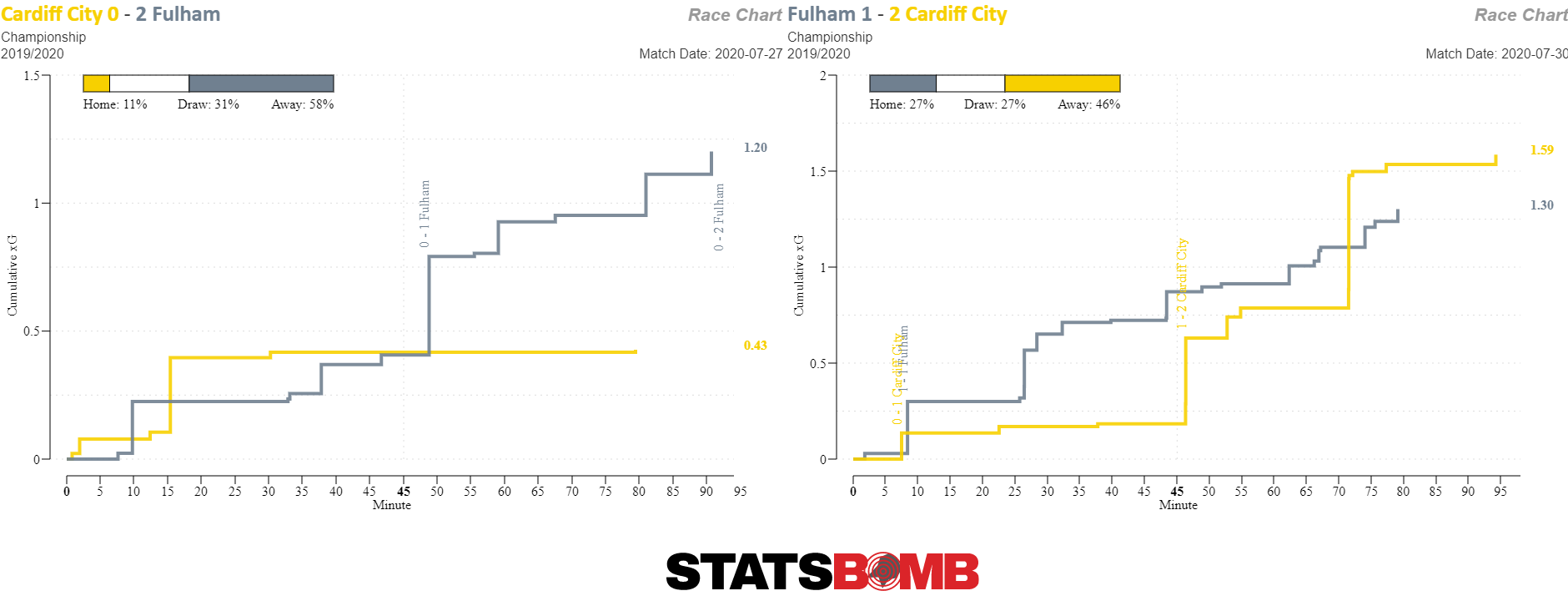 It was a similar story in the final. Fulham focused less on retaining the ball and more on preventing Brentford, and particularly Saïd Benrahma, from playing, staying in a more compact shape than usual but more importantly selecting the more energetic Bobby Reid ahead of Championship top goalscorer Aleksandar Mitrović in order to give them more mobility in leading the press and more pace on the counter. The result was an even game with the deadlock only broken by a moment of individual quality which I’m almost certain you’ll have seen if you’re reading this, but if not:
It was a similar story in the final. Fulham focused less on retaining the ball and more on preventing Brentford, and particularly Saïd Benrahma, from playing, staying in a more compact shape than usual but more importantly selecting the more energetic Bobby Reid ahead of Championship top goalscorer Aleksandar Mitrović in order to give them more mobility in leading the press and more pace on the counter. The result was an even game with the deadlock only broken by a moment of individual quality which I’m almost certain you’ll have seen if you’re reading this, but if not: 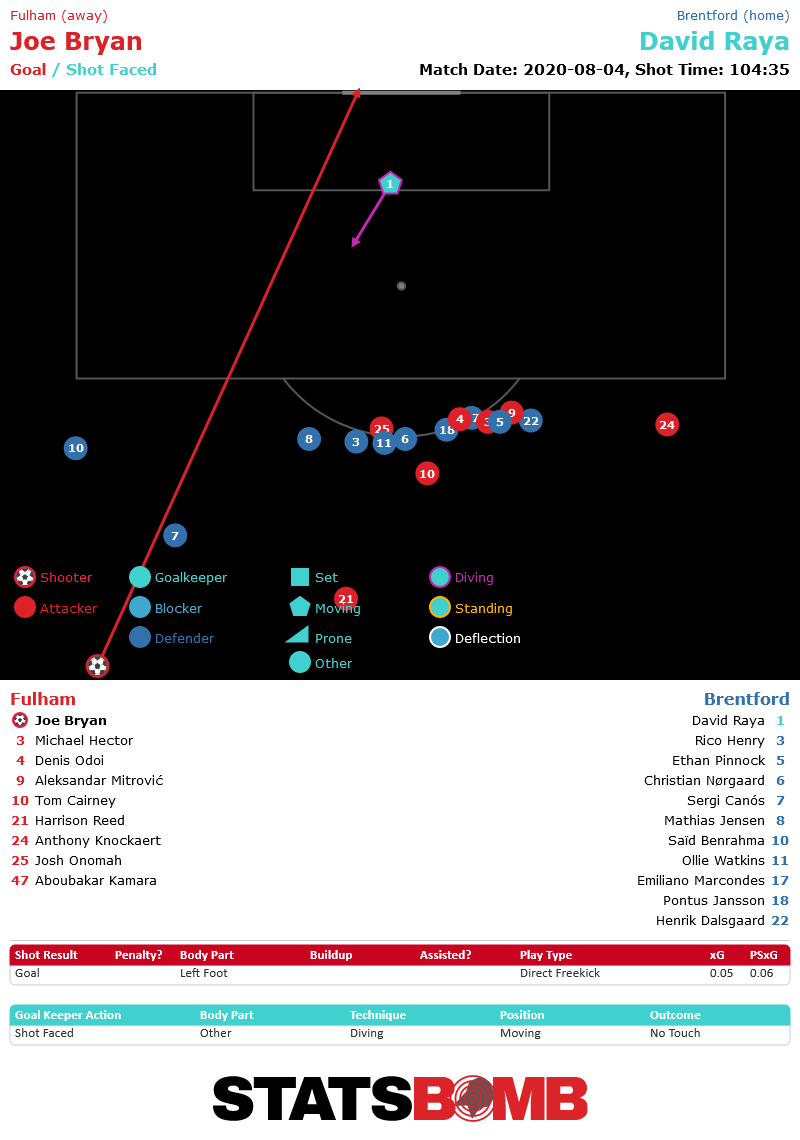 Fulham successfully negotiated the three games that their promotion depended on without riding their luck at any point during. Therefore, it’s undeniable that they did deserve their promotion, right? Let’s start to look forward now. It’s worth considering that Parker’s pragmatism, though not advisable when a big favourite with a talent advantage in a smaller league, does at least leave them better prepared to adjust to the Premier League than they were last time out. Although those attacking transitions will most certainly need to speed up. On that note, the signing of Mario Lemina from Southampton could help if he can replicate the form shown on the south coast that saw him mooted as a potential replacement for Mousa Dembélé at Tottenham. Lemina was flagged by StatsBomb’s own Euan Dewar when he analysed dribblers and their post-dribble actions a couple of seasons back and if he can help Fulham move through the centre of the park and transition from defence to attack more quickly or efficiently, that could be important. Similarly, the return of André Zambo Anguissa to the squad is notable. Anguissa was one of the more heralded signings of the 18/19 summer window and it looks increasingly more likely that he’ll stay a Fulham player in 2020/21, returning after playing a key role in helping Villarreal finish 5th in La Liga. Now two years older than when he first signed and closer to his peak at 24, there’s potential he could step up in the way that was hoped when he first signed.
Fulham successfully negotiated the three games that their promotion depended on without riding their luck at any point during. Therefore, it’s undeniable that they did deserve their promotion, right? Let’s start to look forward now. It’s worth considering that Parker’s pragmatism, though not advisable when a big favourite with a talent advantage in a smaller league, does at least leave them better prepared to adjust to the Premier League than they were last time out. Although those attacking transitions will most certainly need to speed up. On that note, the signing of Mario Lemina from Southampton could help if he can replicate the form shown on the south coast that saw him mooted as a potential replacement for Mousa Dembélé at Tottenham. Lemina was flagged by StatsBomb’s own Euan Dewar when he analysed dribblers and their post-dribble actions a couple of seasons back and if he can help Fulham move through the centre of the park and transition from defence to attack more quickly or efficiently, that could be important. Similarly, the return of André Zambo Anguissa to the squad is notable. Anguissa was one of the more heralded signings of the 18/19 summer window and it looks increasingly more likely that he’ll stay a Fulham player in 2020/21, returning after playing a key role in helping Villarreal finish 5th in La Liga. Now two years older than when he first signed and closer to his peak at 24, there’s potential he could step up in the way that was hoped when he first signed. 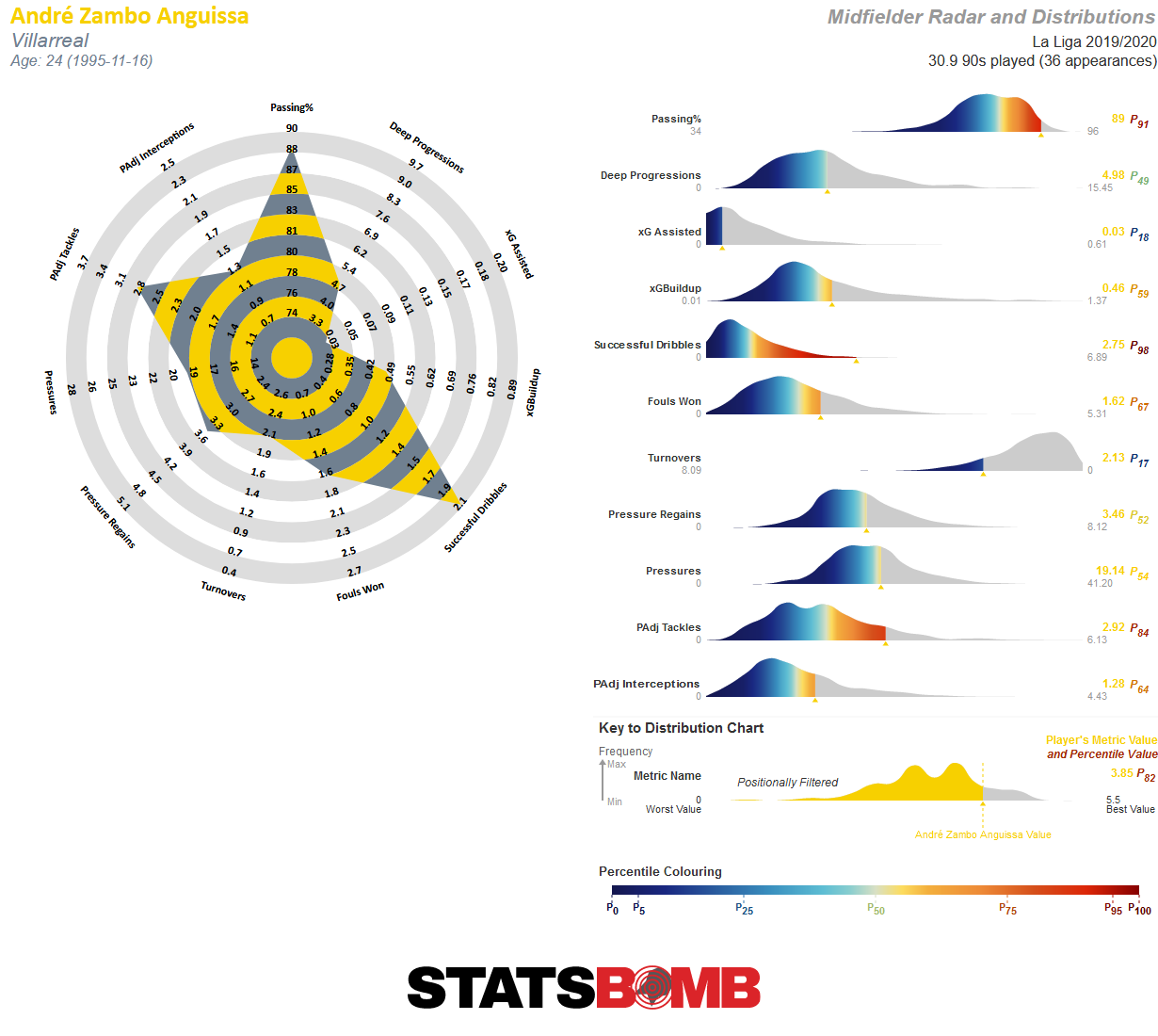 Anguissa was part of the infamous £100million spend that summer, but comparisons between that window and this are scarce. There were some domestic signings back then but the vast majority were brought in from overseas and with no experience of English football. This time, Fulham’s business has so far focused entirely on the domestic market and with smaller sums being exchanged: the only (soon to be confirmed) signing from overseas has been that of wing back Ola Aina who’s spent the last two seasons with Torino in Serie A but moved there from Chelsea. Of the business that remains to be done, there are concerns over Fulham’s reliance on 26-goal Mitrović, who was given very little help in the goalscoring department last season. He’ll be the main man again and has proven he can be counted on for some contribution at Premier League level, but more needs to come from the support acts out wide. Ivan Cavaleiro and Anthony Knockaert notched just nine goals between them last season and given the unlikelihood that Mitrović reaches another double-dozen, they’ll need to step up.
Anguissa was part of the infamous £100million spend that summer, but comparisons between that window and this are scarce. There were some domestic signings back then but the vast majority were brought in from overseas and with no experience of English football. This time, Fulham’s business has so far focused entirely on the domestic market and with smaller sums being exchanged: the only (soon to be confirmed) signing from overseas has been that of wing back Ola Aina who’s spent the last two seasons with Torino in Serie A but moved there from Chelsea. Of the business that remains to be done, there are concerns over Fulham’s reliance on 26-goal Mitrović, who was given very little help in the goalscoring department last season. He’ll be the main man again and has proven he can be counted on for some contribution at Premier League level, but more needs to come from the support acts out wide. Ivan Cavaleiro and Anthony Knockaert notched just nine goals between them last season and given the unlikelihood that Mitrović reaches another double-dozen, they’ll need to step up. 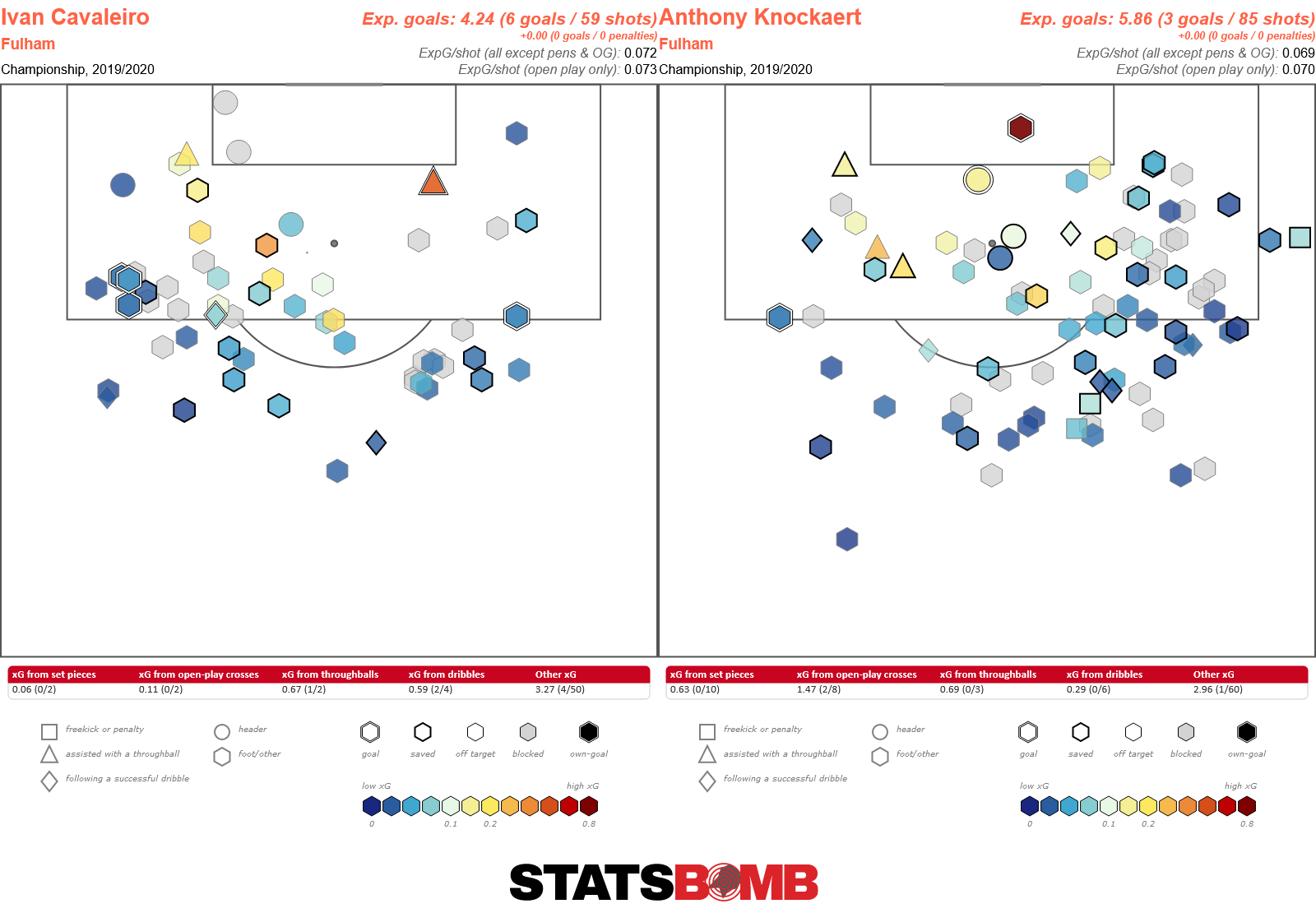 In a weird flip, Fulham could be coming into this season as a perceivably and demonstrably worse side than the one that was promoted last time out but at the same time one that’s better prepared and suited for the challenge that’s ahead of them thanks to a risk-averse manager and more settled squad. Expectations amongst the fanbase are also lower due to the manner of promotion and tighter transfer spending. Critiqued for much of last season but with a bit more credit in the bank after promotion, it’ll be interesting to see how much patience Parker gets should things not go to plan straight away. Joint relegation favourites with West Brom seems a fair assessment.
In a weird flip, Fulham could be coming into this season as a perceivably and demonstrably worse side than the one that was promoted last time out but at the same time one that’s better prepared and suited for the challenge that’s ahead of them thanks to a risk-averse manager and more settled squad. Expectations amongst the fanbase are also lower due to the manner of promotion and tighter transfer spending. Critiqued for much of last season but with a bit more credit in the bank after promotion, it’ll be interesting to see how much patience Parker gets should things not go to plan straight away. Joint relegation favourites with West Brom seems a fair assessment.
If you're a club, media or gambling entity and want to know more about what StatsBomb can do for you, please contact us at Sales@StatsBomb.com We also provide education in this area, so if this taste of football analytics sparked interest, check out our Introduction to Football Analytics course Follow us on twitter in English and Spanish and also on LinkedIn
West Bromwich Albion: Season Preview 2020-21
It took two attempts, but last season there was finally enough ‘boing’ in the Baggies to complete their ascent back up the perpetual yo-yo that seemingly connects them from the Premier League to the Championship. Slaven Bilić will be a familiar face to top-tier dugouts, having accepted the drop in class and the challenge of returning West Brom to the top flight, and he succeeded in making them a far more convincing outfit than they had been the previous campaign. Their promotion was a formality for the most part: from September onwards, West Brom were never outside of the top two. As the post-lockdown mini-season commenced, the Baggies had nine games to hold onto a six-point lead over 3rd-placed Fulham and a ten-point lead over Brentford in 4th in order to seal their Premier League return. That, however, paints the campaign to be far more routine than it actually turned out to be. Who can forget that Friday night when West Brom lost their penultimate fixture of the season to Huddersfield, giving Brentford, having won seven games straight, the opportunity to overtake them if they won the following day? Bilić was even quoted after the game as seeing their promotion bottled: “I don’t expect that (Brentford will drop points). We’ll be ready for the play-offs”. Now looking like the ultimate mind game, Brentford lost and West Brom were able to better the Bees’ result on the final day to seal their Premier League return. They failed to win any of their last four fixtures, but to focus only on their late season stumbles would take away from a solid promotion campaign overall. After all, it was mission accomplished. Having only just entered the building that summer, it’s said that Bilić was expecting a slower transition before the team would start to perform to his standards, but it transpired to take no time at all. At Christmas, West Brom were top of the tree having taken 50 points from 23 games, and were no fewer than 11 points clear of 3rd. There was some slight overperformance on the metrics but nothing to suggest their promotion push would be in danger in the second half of the season. On the attacking end, the Baggies had finished their chances very well, netting 41 goals from 31.75 xG (plus 5/5 penalties) 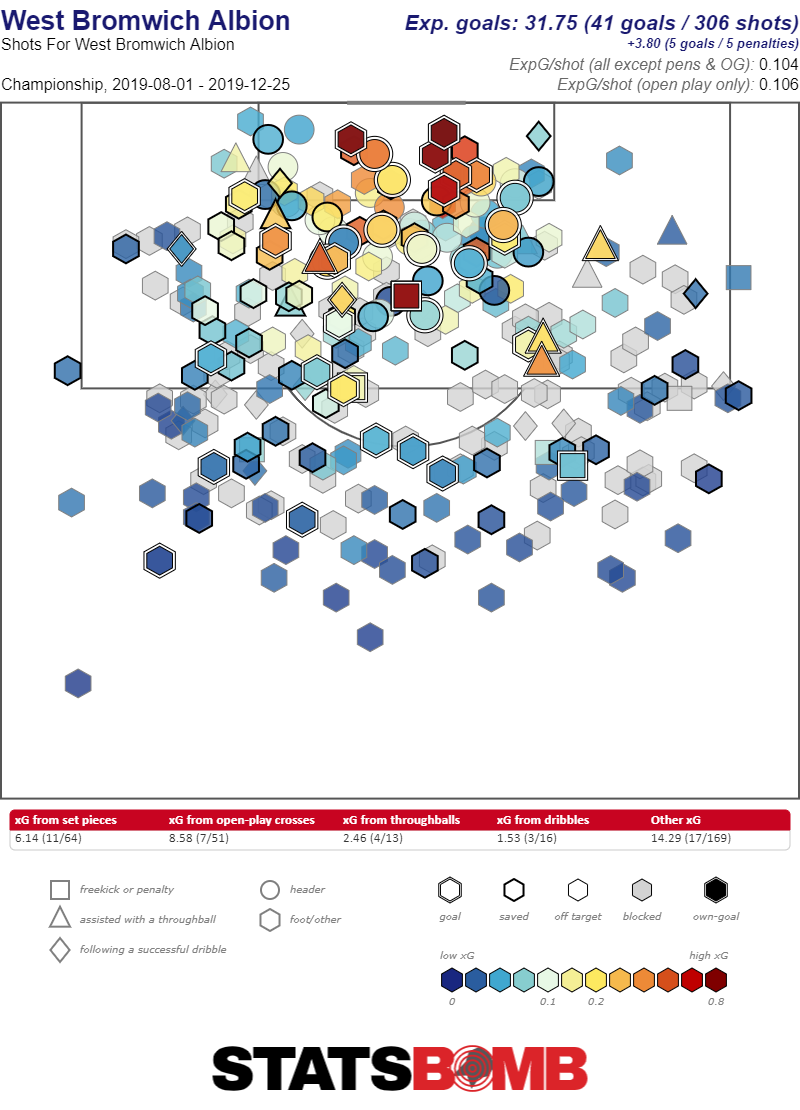 Whilst at the back, there was a little bit of separation on the actual total versus expectation, but nothing as dramatic, conceding 21 times from 25.35xG (plus 3/4 penalties).
Whilst at the back, there was a little bit of separation on the actual total versus expectation, but nothing as dramatic, conceding 21 times from 25.35xG (plus 3/4 penalties). 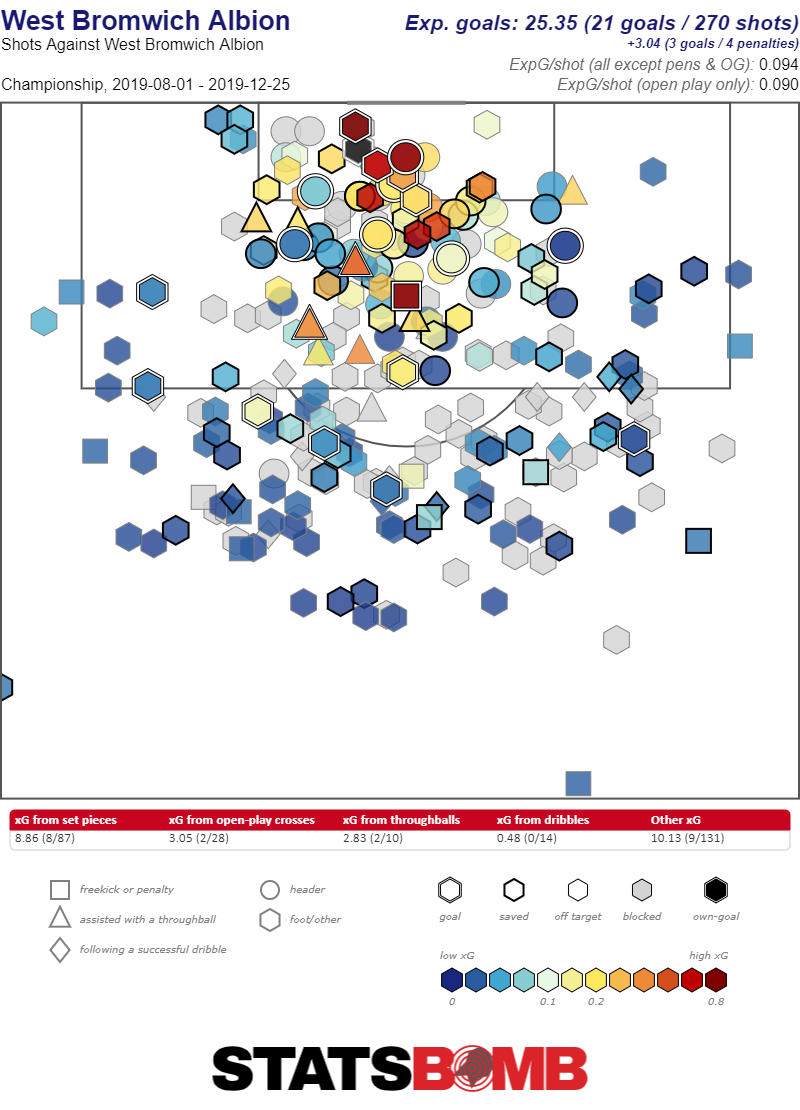 Running at a 100-point pace in the first half of the season meant that West Brom had the breathing space required to afford them a stagger and stumble on the home stretch. Their subsequent haul of 33 points from the second set of 23 games – only the 10th best record in the Championship in that period - should ring alarm bells for a side bracing themselves to face the Premier League juggernauts ahead, but the underlying numbers may counter the narrative that the Baggies are going into it as a worse side than the one that raced into 1st place by Christmas.
Running at a 100-point pace in the first half of the season meant that West Brom had the breathing space required to afford them a stagger and stumble on the home stretch. Their subsequent haul of 33 points from the second set of 23 games – only the 10th best record in the Championship in that period - should ring alarm bells for a side bracing themselves to face the Premier League juggernauts ahead, but the underlying numbers may counter the narrative that the Baggies are going into it as a worse side than the one that raced into 1st place by Christmas. 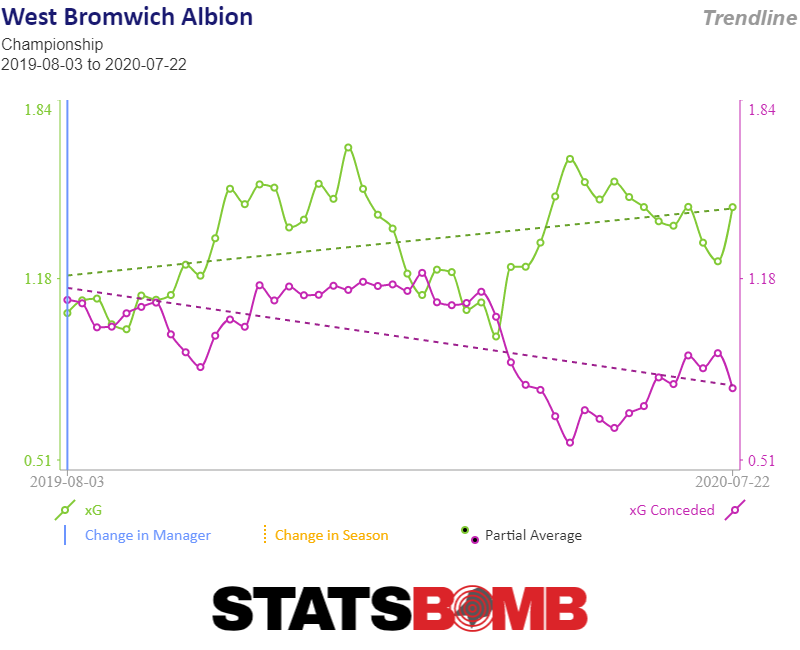 Metrics took a nosedive through the Winter period as they rode out a seven-match winless streak in that time but to a large extent that can be explained by the quashing of two of their best performers at that point in the season. West Ham dynamo Grady Diangana, on loan for the season and with 5 goals + 5 assists at that point, picked up an injury which in itself weakened West Brom’s attacking power, but it also allowed the opposition to put even more focus on outstanding talent Matheus Pereira, on 5 goals + 10 assists by that point, shutting him down and roughing him up to an even greater extent. They recovered sufficiently though and, although results were much less impressive, the metrics were virtually identical in the second half of the season: they scored 29 from 32.76xG (plus 2/2 penalties) and conceded 20 from 18.36xG. So, if anything, the metrics were even better and the surface level drop off in results shouldn’t be too much cause for concern, particularly as the pace set in the first half of the season was never likely to sustain anyway. Had they picked up their 83 points in 42 and 41 splits, as their relatively stable (save for the mid-season blip) metrics suggested they could’ve, then there wouldn’t even be a conversation to be had about it. Coming into the top tier, it’s clear West Brom will need reinforcements and a bit of a rejuvenation to the squad - whether they get it or not is another matter. Bilić has already hinted that it’s likely their transfer business will be more Sheffield United than Aston Villa, when comparing to the activities of the promoted Championship sides in last summer’s window. However, The Baggies have made one of the signings of the summer already in making Pereira’s loan deal permanent. Signed from Sporting Lisbon on deadline day in August 2019 for a £750k loan fee, the agreed £8million price tag at that time has turned out to be an absolute snip as Pereira established himself as one of the best players, let alone attacking midfielders, seen in the Championship last season.
Metrics took a nosedive through the Winter period as they rode out a seven-match winless streak in that time but to a large extent that can be explained by the quashing of two of their best performers at that point in the season. West Ham dynamo Grady Diangana, on loan for the season and with 5 goals + 5 assists at that point, picked up an injury which in itself weakened West Brom’s attacking power, but it also allowed the opposition to put even more focus on outstanding talent Matheus Pereira, on 5 goals + 10 assists by that point, shutting him down and roughing him up to an even greater extent. They recovered sufficiently though and, although results were much less impressive, the metrics were virtually identical in the second half of the season: they scored 29 from 32.76xG (plus 2/2 penalties) and conceded 20 from 18.36xG. So, if anything, the metrics were even better and the surface level drop off in results shouldn’t be too much cause for concern, particularly as the pace set in the first half of the season was never likely to sustain anyway. Had they picked up their 83 points in 42 and 41 splits, as their relatively stable (save for the mid-season blip) metrics suggested they could’ve, then there wouldn’t even be a conversation to be had about it. Coming into the top tier, it’s clear West Brom will need reinforcements and a bit of a rejuvenation to the squad - whether they get it or not is another matter. Bilić has already hinted that it’s likely their transfer business will be more Sheffield United than Aston Villa, when comparing to the activities of the promoted Championship sides in last summer’s window. However, The Baggies have made one of the signings of the summer already in making Pereira’s loan deal permanent. Signed from Sporting Lisbon on deadline day in August 2019 for a £750k loan fee, the agreed £8million price tag at that time has turned out to be an absolute snip as Pereira established himself as one of the best players, let alone attacking midfielders, seen in the Championship last season. 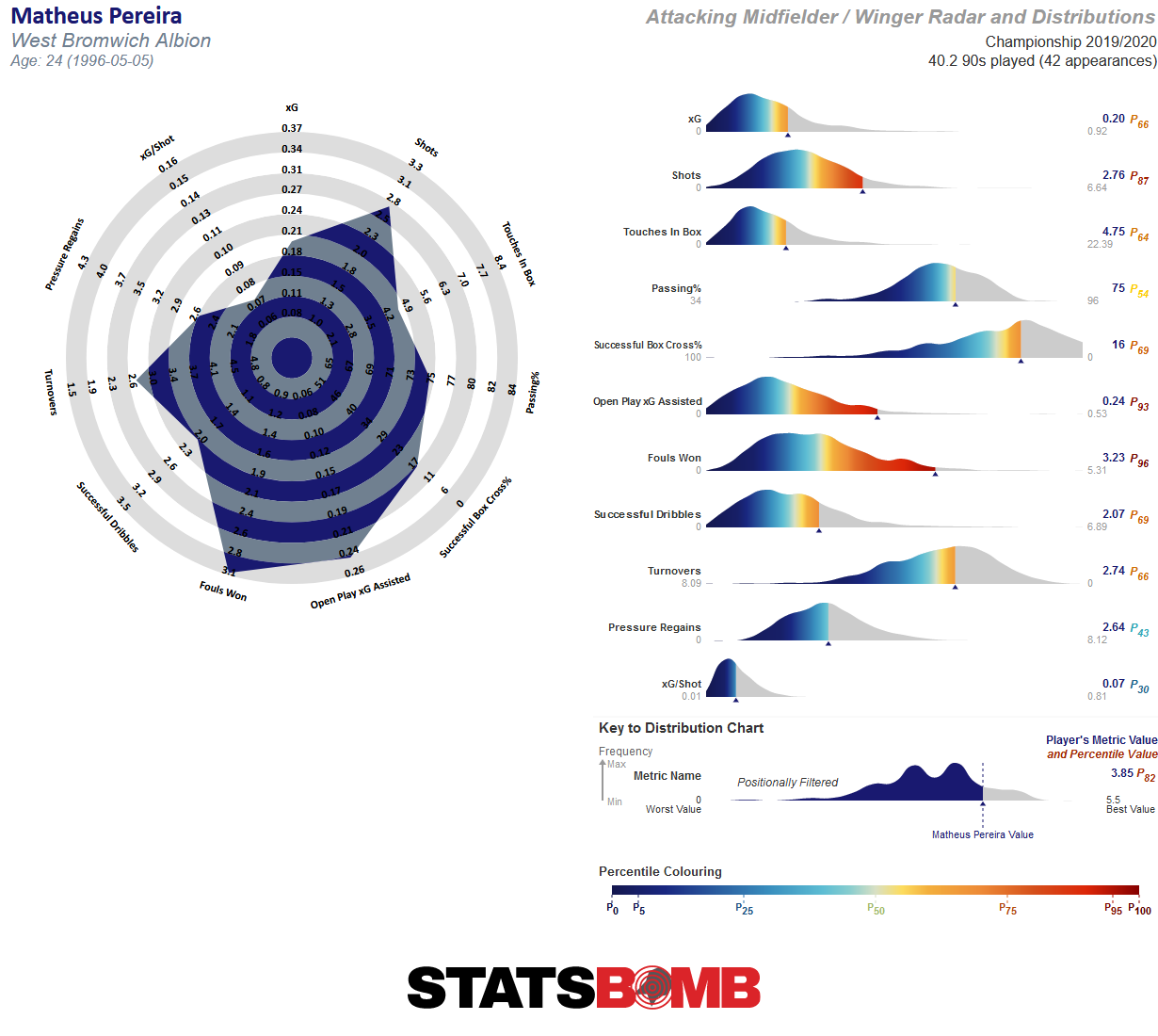 The Brazilian finished the campaign with a total of 8 goals and 16 assists, a contribution eclipsed only by Brentford’s Ollie Watkins, and it’s one piece of the jigsaw Bilić and West Brom fans will be relieved at not having to try and replace, especially at that price point. A reunion with buddy Filip Krovinović remains on the cards, the Croatian came on loan from Sporting’s rivals Benfica but struck up a fruitful relationship on and off the pitch with Pereira. Krovinović’s ball retention turned out to be the perfect counter point to the risk-friendly Pereira and there was often a regular supply line between the two. If reports are to be believed, negotiations are well underway for his return. A deal that could be just as important, and equally shrewd to the Pereira deal if they can successfully negotiate it, is the return of Grady Diangana on a permanent from West Ham, with the Hammers apparently considering accepting an offer for the England U21 winger. Diangana’s season wasn’t held to quite as much fanfare outside of the West Midlands largely due to the medium-term injury he suffered, but Baggies fans know what a talent they had dovetailing with Pereira and probably hadn’t even considered a return for him would be likely on a temporary basis, let alone on a permanent, expecting his good form to take him into the West Ham first team.
The Brazilian finished the campaign with a total of 8 goals and 16 assists, a contribution eclipsed only by Brentford’s Ollie Watkins, and it’s one piece of the jigsaw Bilić and West Brom fans will be relieved at not having to try and replace, especially at that price point. A reunion with buddy Filip Krovinović remains on the cards, the Croatian came on loan from Sporting’s rivals Benfica but struck up a fruitful relationship on and off the pitch with Pereira. Krovinović’s ball retention turned out to be the perfect counter point to the risk-friendly Pereira and there was often a regular supply line between the two. If reports are to be believed, negotiations are well underway for his return. A deal that could be just as important, and equally shrewd to the Pereira deal if they can successfully negotiate it, is the return of Grady Diangana on a permanent from West Ham, with the Hammers apparently considering accepting an offer for the England U21 winger. Diangana’s season wasn’t held to quite as much fanfare outside of the West Midlands largely due to the medium-term injury he suffered, but Baggies fans know what a talent they had dovetailing with Pereira and probably hadn’t even considered a return for him would be likely on a temporary basis, let alone on a permanent, expecting his good form to take him into the West Ham first team. 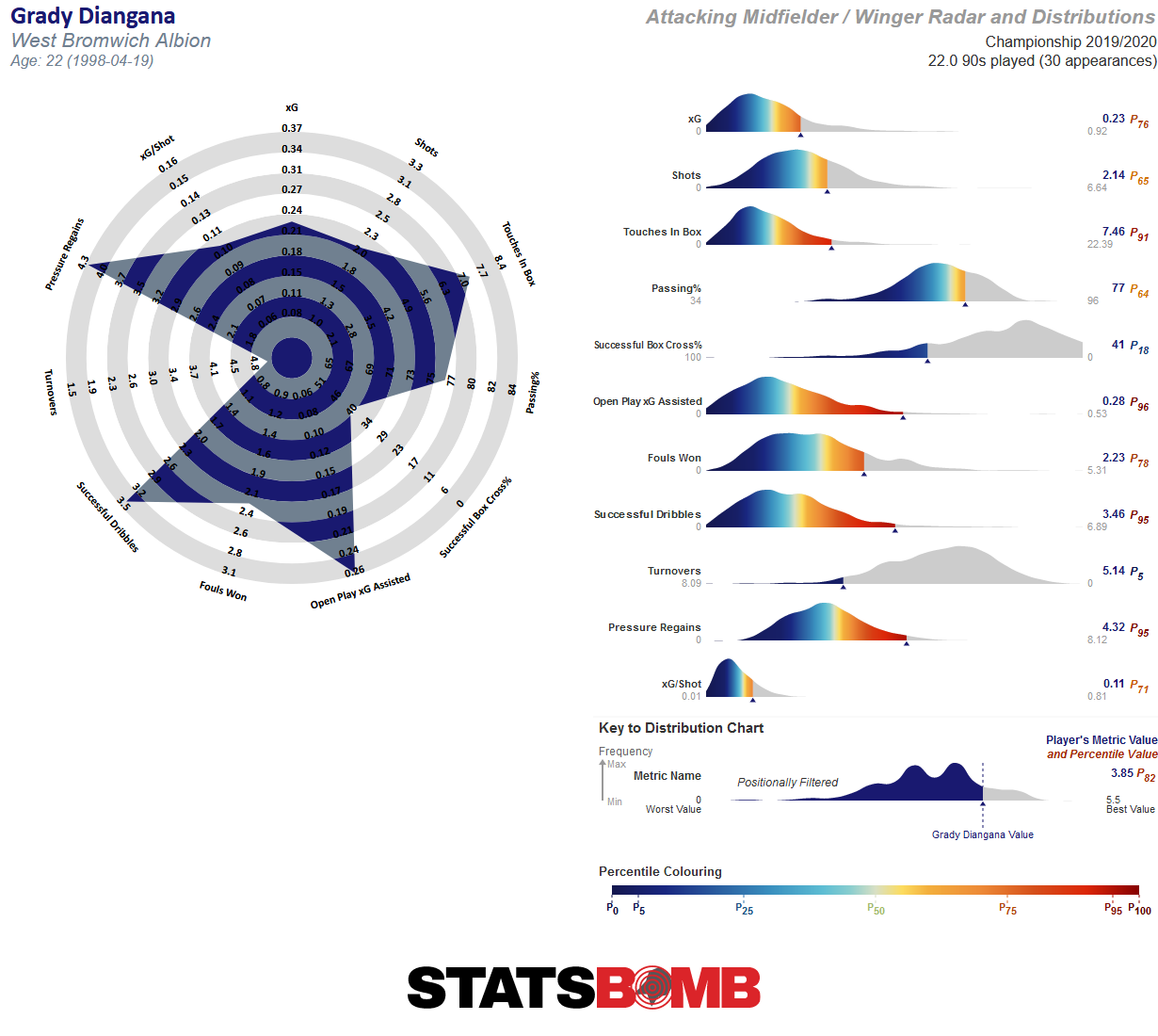 * Despite only managing 1980 minutes, Diangana undoubtedly made West Brom a much better side when he was in it and his 0.64 goals+assists per 90 minutes ranked 6th in the Championship for players with 1500 minutes or more – ahead of the likes of Pereira, Watkins, Mitrovic and Benrahma – and his 3.46 successful dribbles per 90 ranked 2nd in the league, getting the better of whichever fullback he was up against virtually every week. Reuniting Pereira, Diangana and Krovinovic, three key contributors to West Brom’s promotion, would be a huge boost and perhaps one that was unexpected at the close of the season, Pereira’s formality of a transfer aside. Probably the most important business they still have to do will be in recruiting a centre forward. None of Charlie Austin, Hal Robson-Kanu or Kenneth Zohore nailed down the role through last season and an upgrade is a high priority. Romaine Sawyers and Jake Livermore had excellent seasons as the double pivot in midfield but will need more help with little depth behind them, whilst Semi Ajayi needs a partner at centre back as Ahmed Hegazy and Kyle Bartley were rotated and apparently not entirely trusted by Bilić. A move for Brighton’s Shane Duffy failed as he opted to join Celtic, but that in itself could open the door for West Brom to make a move to bring Kristoffer Ajer south of the border who has been linked.
* Despite only managing 1980 minutes, Diangana undoubtedly made West Brom a much better side when he was in it and his 0.64 goals+assists per 90 minutes ranked 6th in the Championship for players with 1500 minutes or more – ahead of the likes of Pereira, Watkins, Mitrovic and Benrahma – and his 3.46 successful dribbles per 90 ranked 2nd in the league, getting the better of whichever fullback he was up against virtually every week. Reuniting Pereira, Diangana and Krovinovic, three key contributors to West Brom’s promotion, would be a huge boost and perhaps one that was unexpected at the close of the season, Pereira’s formality of a transfer aside. Probably the most important business they still have to do will be in recruiting a centre forward. None of Charlie Austin, Hal Robson-Kanu or Kenneth Zohore nailed down the role through last season and an upgrade is a high priority. Romaine Sawyers and Jake Livermore had excellent seasons as the double pivot in midfield but will need more help with little depth behind them, whilst Semi Ajayi needs a partner at centre back as Ahmed Hegazy and Kyle Bartley were rotated and apparently not entirely trusted by Bilić. A move for Brighton’s Shane Duffy failed as he opted to join Celtic, but that in itself could open the door for West Brom to make a move to bring Kristoffer Ajer south of the border who has been linked. 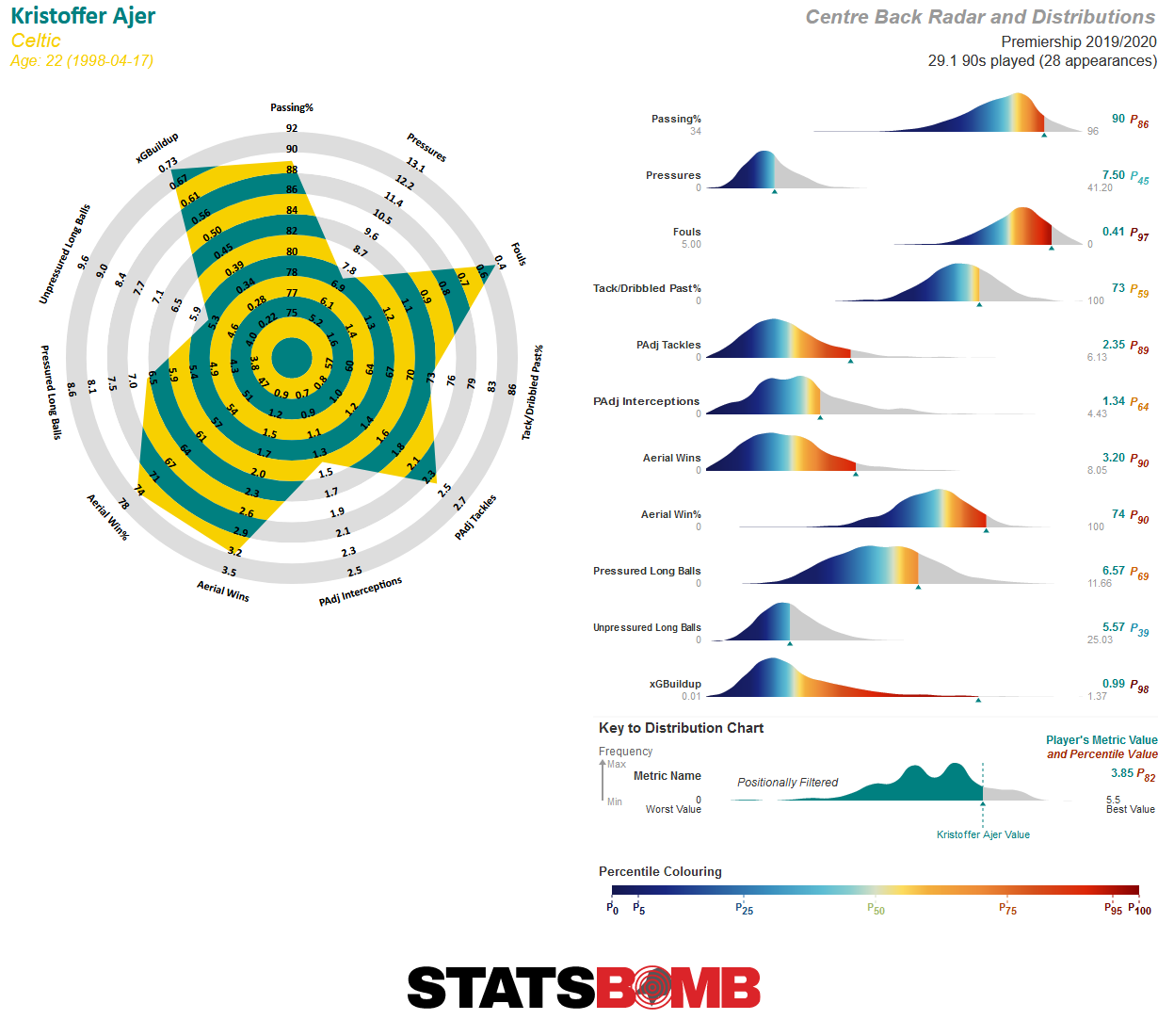 The apparent faltering at the back end of the campaign has probably quelled confidence amongst the fanbase and there’s a sense of realism that they’ll have to overcome the odds to finish above the dotted red line in 2020/21. The squad was already in need of retooling anyway - let alone to be ready to step up to the Premier League - and there seemingly isn’t a huge amount of backing available in order to do that. That said, shrewd additions in problem areas will at least help the Baggies to be competitive and should Bilić adjust the tactical setup sufficiently in order to keep them solid at the back, providing a foundation for the star quality in the side to thrive, then they may just have a chance. Otherwise, a return trip down the yo-yo in May 2021 could beckon.
The apparent faltering at the back end of the campaign has probably quelled confidence amongst the fanbase and there’s a sense of realism that they’ll have to overcome the odds to finish above the dotted red line in 2020/21. The squad was already in need of retooling anyway - let alone to be ready to step up to the Premier League - and there seemingly isn’t a huge amount of backing available in order to do that. That said, shrewd additions in problem areas will at least help the Baggies to be competitive and should Bilić adjust the tactical setup sufficiently in order to keep them solid at the back, providing a foundation for the star quality in the side to thrive, then they may just have a chance. Otherwise, a return trip down the yo-yo in May 2021 could beckon.
If you're a club, media or gambling entity and want to know more about what StatsBomb can do for you, please contact us at Sales@StatsBomb.com We also provide education in this area, so if this taste of football analytics sparked interest, check out our Introduction to Football Analytics course Follow us on twitter in English and Spanish and also on LinkedIn
Sheffield United: Season Preview 2020-21
It was 12 months ago that we at StatsBomb proclaimed, to many a raised eyebrow and sanity check, that this newly-promoted Sheffield United side had every capability of mounting an instant challenge for a European place. Just kidding. Of course we didn’t. Nobody did. Even the most optimistic disciples of Chris Wilder and Alan Knill’s managerial abilities - A.K.A Blades supporters - would’ve scoffed at any suggestion they were about to fall just short of a top-seven finish in their return to the top flight, and yet at the same time maybe they wouldn’t have held much disbelief after all. Another season of overachievement would only be following the trend at this point, such has been the rapid and sustained ascent under their four years of management. Only a post-lockdown dip put paid to their European hopes but a 9th placed finish in your first top flight season since 2007 on comfortably the lowest budget in the division? Fans would bite your hand off and probably take a bit of arm and torso too, though it’s easy to imagine the relentlessly ambitious Wilder curling a lip at the idea of a late season dip in form, despite acknowledging prior to June’s fixture vs Manchester United that this was “A Ford Fiesta against a Ferrari”. Relegation favourites in pre-season, Sheffield United not only survived, they thrived. Of course, Wilder and Knill are responsible for setting the team up in the way that has generated this level of success, but the players take full credit for their execution of the game plan as well. The most commonly used ‘back 9’ in United’s 3-5-2 shape, i.e. all but the two forwards, each played 75% or more of the available minutes in the league. Not only was the team selection incredibly consistent, but every single one of the nine had played for the Blades in the Championship the season before. It shouldn’t go unsaid that the post-lockdown drop off coincided with a couple of injuries to members of the Reliable Nine, which only speaks to the necessity that each player knows and understands not only their role in the team but also those of their teammates in order for the sum to be greater than its parts. As much as was rightly made of the tactical novelty and innovation within the side going into and during the season, in the end it didn’t necessarily make for entertaining viewing for the goal-hungry neutral. The promotion-winning 3-4-1-2 shape was adapted to a more compact 3-5-2; personnel wise it saw the creative-but-slight Mark Duffy replaced by the three-lunged John Lundstram. The product was more suited to coping with the higher quality of opposition but games involving the Blades saw just 78 goals at an average of 2.05 per game – a Premier League low. It was a tweak to the system rather than an overhaul, the same principles of play remained: telepathic rotations and combination play, a focus on wide overloads, and a desire to create quality rather than quantity. Just like their Championship promotion season, Sheffield United again had the closest average Shot Distance in the league in 2019/20, whilst their xG/shot – the average expected conversion rate of their shots – was in esteemed company, bettered only by Man City and Arsenal and even a touch better than Liverpool’s. 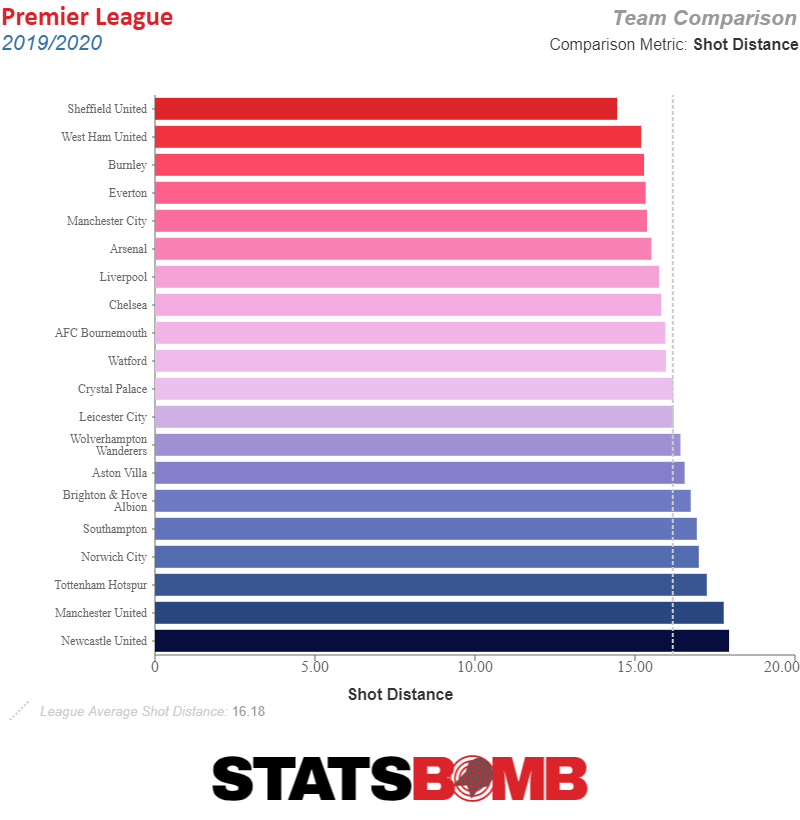 Having a laser-focus on creating quality opportunities negated the fact that they actually took the fewest shots in the league, only adding to the novelty of the Blades’ methods – creating fewer shots than all three relegated sides and the rest is not something you’d associate with a team pushing for European qualification but, unusual though it may be, it did the job. The reason for this ‘low volume / high quality’ aspect of their attacking play is their propensity for crossing both from deep and through combinations to get to the byline. Tough passes to execute but often leading to chances from central areas and close to goal when they did connect. Their wing play and crossing approach was ably supported, of course, by – get your klaxons ready people – the overlapping centre backs. Player of the year Chris Basham’s performances have led to the Bramall Lane stands christening his position the ‘Basham role’, and his pass map from right and central areas in the opposition half highlight how often he got forward to add extra numbers to United’s play in the attacking phase.
Having a laser-focus on creating quality opportunities negated the fact that they actually took the fewest shots in the league, only adding to the novelty of the Blades’ methods – creating fewer shots than all three relegated sides and the rest is not something you’d associate with a team pushing for European qualification but, unusual though it may be, it did the job. The reason for this ‘low volume / high quality’ aspect of their attacking play is their propensity for crossing both from deep and through combinations to get to the byline. Tough passes to execute but often leading to chances from central areas and close to goal when they did connect. Their wing play and crossing approach was ably supported, of course, by – get your klaxons ready people – the overlapping centre backs. Player of the year Chris Basham’s performances have led to the Bramall Lane stands christening his position the ‘Basham role’, and his pass map from right and central areas in the opposition half highlight how often he got forward to add extra numbers to United’s play in the attacking phase. 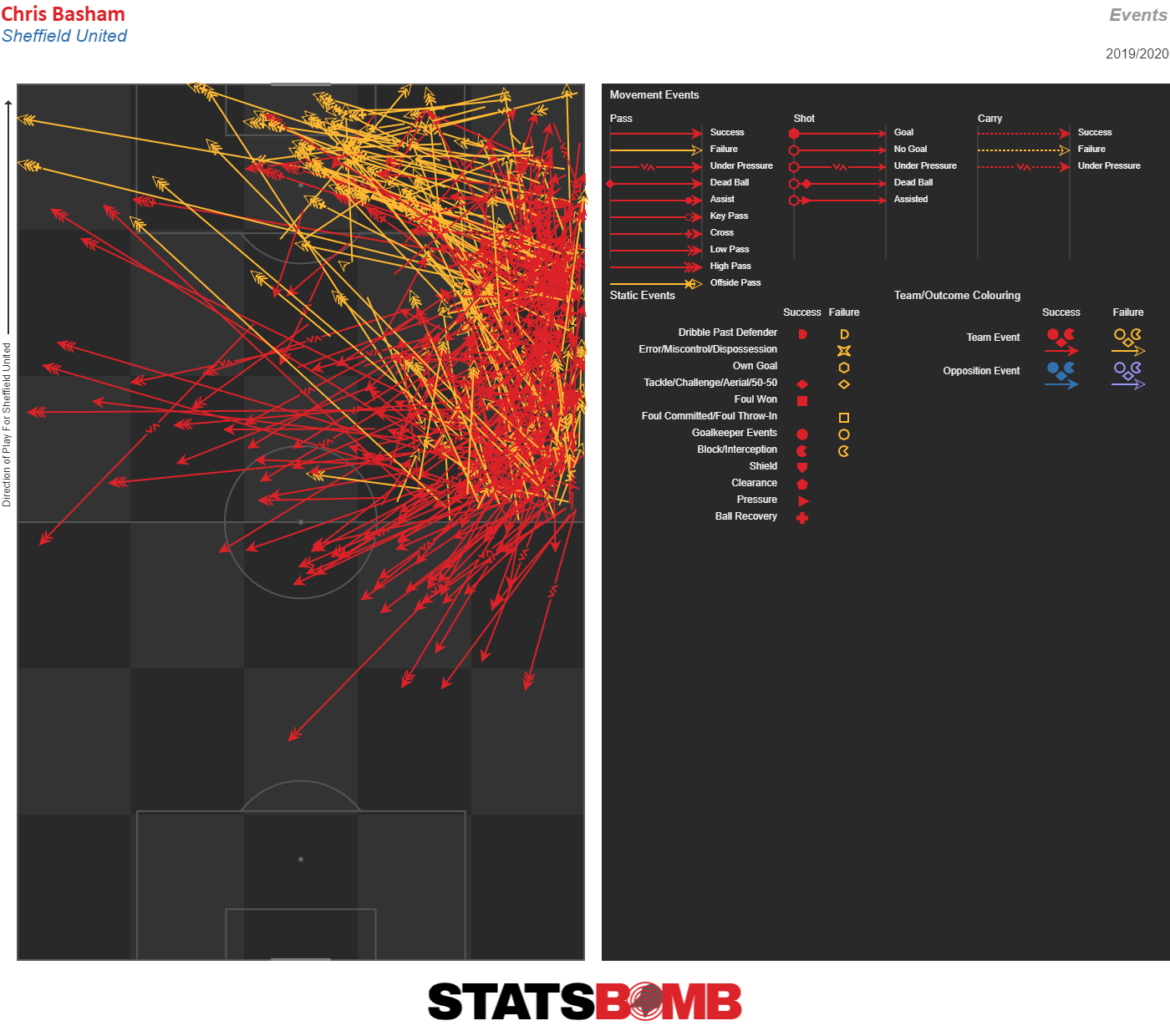 Of course, there’s little reason to focus on their attacking play when it’s the defence that powered the Blades to their lofty finish. Conceding just 39 goals as a newly promoted team, a number bettered only by the eventual top three, takes some doing. Creating openings did not come easy to their opponents, even the “Ferraris”: games against Chelsea, Spurs and Arsenal returned three wins, three draws, no defeats. Three elements forged this Steel City defence. The first was limiting the opportunities their opposition were able to generate, with the sheer number of bodies United would have in the centre of the park both in the defensive and the midfield lines often doing a fine job of congesting that area and forcing the opposition to look for openings elsewhere – the 11.32 shots conceded per game was 8th fewest. Of the sides that had a better record, only Everton finished below them.
Of course, there’s little reason to focus on their attacking play when it’s the defence that powered the Blades to their lofty finish. Conceding just 39 goals as a newly promoted team, a number bettered only by the eventual top three, takes some doing. Creating openings did not come easy to their opponents, even the “Ferraris”: games against Chelsea, Spurs and Arsenal returned three wins, three draws, no defeats. Three elements forged this Steel City defence. The first was limiting the opportunities their opposition were able to generate, with the sheer number of bodies United would have in the centre of the park both in the defensive and the midfield lines often doing a fine job of congesting that area and forcing the opposition to look for openings elsewhere – the 11.32 shots conceded per game was 8th fewest. Of the sides that had a better record, only Everton finished below them. 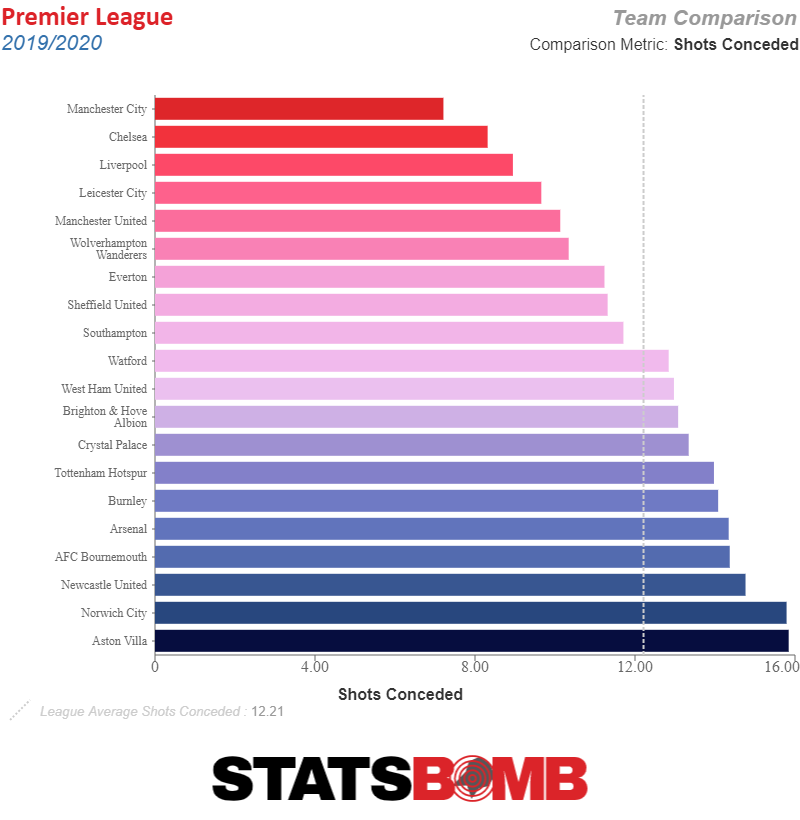 The second element? Dean Henderson. When their opponents did generate a shot, they often found the Manchester United loanee in the sort of form that catapulted him into immediate England contention, earning him a first senior callup in October. Henderson particularly excelled in the old-fashioned arts of goalkeeping: taking pressure off the defence by claiming crosses and making saves that you shouldn’t necessarily expect him to make. Lastly, the Blades performed well on set play’s once again, though this time the acclaim comes on the defensive end, tying with Leicester for the fewest set play goals conceded with 6. When combined, these elements made for a stubborn defence that gave United a reasonable chance of taking a result from virtually every game they played in the 2019/20 season. Unfortunately, Henderson’s form was too good for the decision makers at Old Trafford to ignore and he looks set to compete with David De Gea for the #1 jersey there in 2020/21. Wilder and his recruitment team moved quickly to replace him, spending £18.5 million on bringing Aaron Ramsdale in from relegated Bournemouth. Not far behind Henderson in the England pecking order, Ramsdale will be hoping he can follow in his predecessor’s footsteps and comes with decent pedigree and an upwardly mobile trajectory mirroring that of his new club; capped 26 times in England’s age group squads and also comes in on the back of winning Young Player of the Year at AFC Wimbledon in 2018/19 and Supporters Player of the Year at Bournemouth in 2019/20.
The second element? Dean Henderson. When their opponents did generate a shot, they often found the Manchester United loanee in the sort of form that catapulted him into immediate England contention, earning him a first senior callup in October. Henderson particularly excelled in the old-fashioned arts of goalkeeping: taking pressure off the defence by claiming crosses and making saves that you shouldn’t necessarily expect him to make. Lastly, the Blades performed well on set play’s once again, though this time the acclaim comes on the defensive end, tying with Leicester for the fewest set play goals conceded with 6. When combined, these elements made for a stubborn defence that gave United a reasonable chance of taking a result from virtually every game they played in the 2019/20 season. Unfortunately, Henderson’s form was too good for the decision makers at Old Trafford to ignore and he looks set to compete with David De Gea for the #1 jersey there in 2020/21. Wilder and his recruitment team moved quickly to replace him, spending £18.5 million on bringing Aaron Ramsdale in from relegated Bournemouth. Not far behind Henderson in the England pecking order, Ramsdale will be hoping he can follow in his predecessor’s footsteps and comes with decent pedigree and an upwardly mobile trajectory mirroring that of his new club; capped 26 times in England’s age group squads and also comes in on the back of winning Young Player of the Year at AFC Wimbledon in 2018/19 and Supporters Player of the Year at Bournemouth in 2019/20. 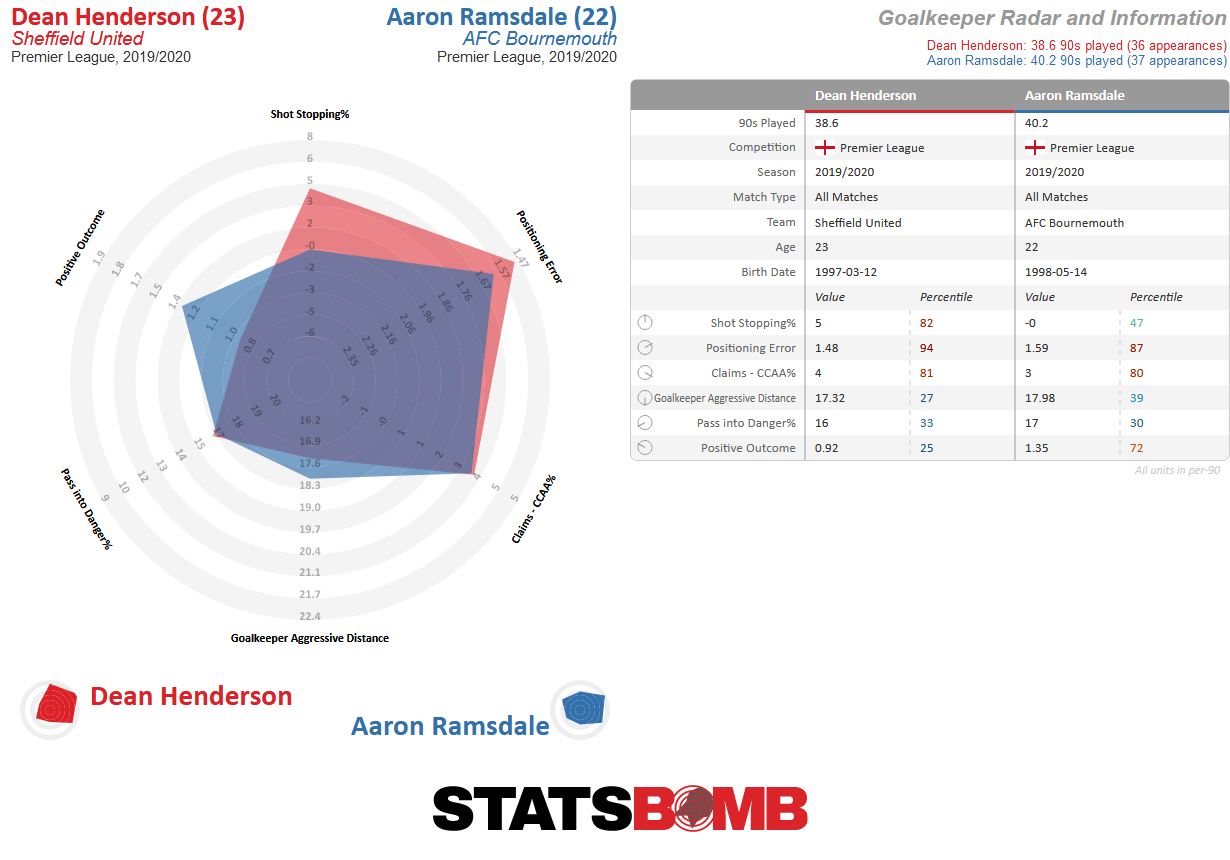 To date, only Wes Foderingham as a backup ‘keeper has followed Ramsdale through the door, but it’s clear that the Blades will be targeting a bit more quality in the middle and top end of the pitch in order to enhance their attacking output. Links with Matty Cash who had an impressive season for Nottingham Forest make sense – the winger-turned-right-back would provide quality in the final third, though the intensity of those links seem to have died down in recent weeks. A deal for Reading’s John Swift would also add some much-needed creativity to the Blades midfield line and could make the difference in games when they’re on top and in search of a breakthrough. Swift’s last two seasons in the Championship have seen him regularly demonstrate his creative capabilities, but he also has a dribbling ability that has been missing from Sheffield United’s arsenal in the last couple of seasons.
To date, only Wes Foderingham as a backup ‘keeper has followed Ramsdale through the door, but it’s clear that the Blades will be targeting a bit more quality in the middle and top end of the pitch in order to enhance their attacking output. Links with Matty Cash who had an impressive season for Nottingham Forest make sense – the winger-turned-right-back would provide quality in the final third, though the intensity of those links seem to have died down in recent weeks. A deal for Reading’s John Swift would also add some much-needed creativity to the Blades midfield line and could make the difference in games when they’re on top and in search of a breakthrough. Swift’s last two seasons in the Championship have seen him regularly demonstrate his creative capabilities, but he also has a dribbling ability that has been missing from Sheffield United’s arsenal in the last couple of seasons. 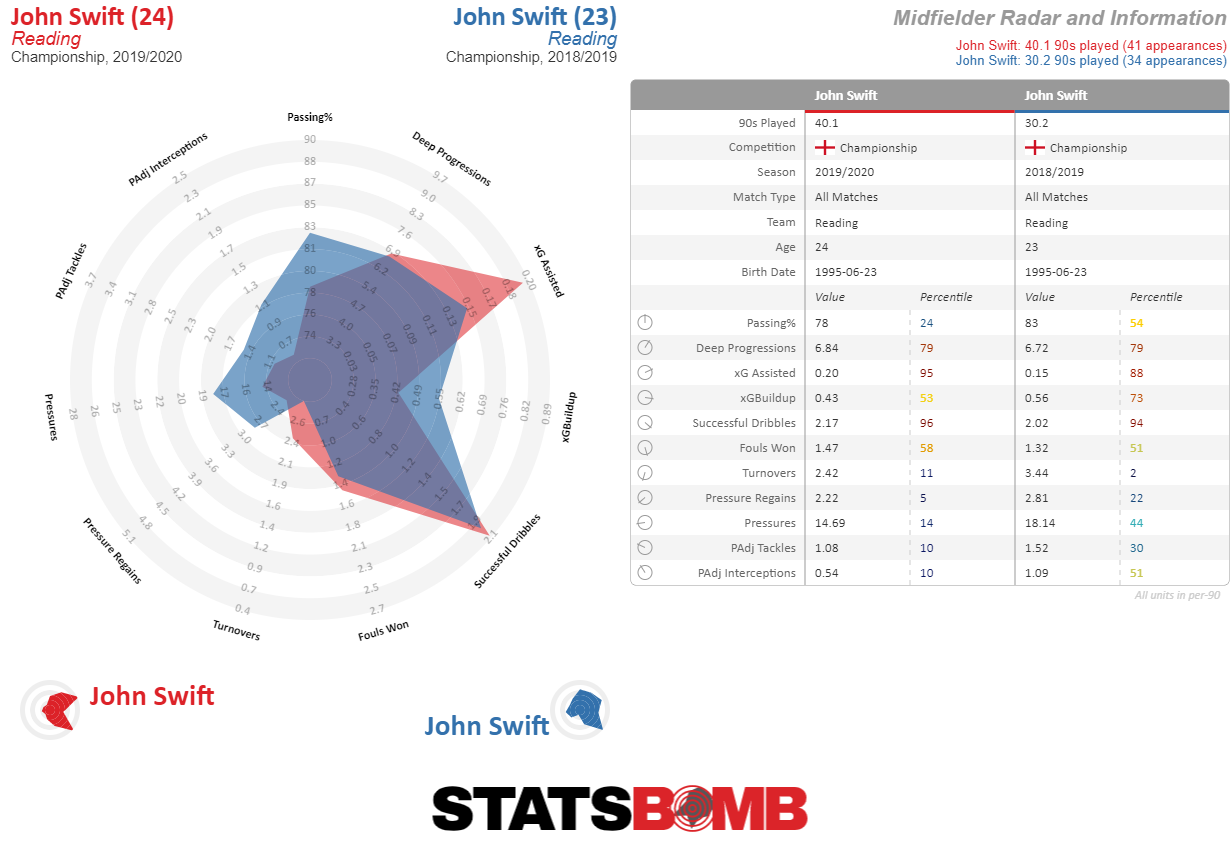 A refresh will also be needed up top soon, if not now. Despite his well-documented finishing issues, David McGoldrick remains a key cog in the Sheffield United frontline for his all-round play but at 32 will need more help and sooner rather than later. Oli McBurnie will be hoping to improve his goal output despite a reasonable first season in red-and-white overall, whilst Lys Mousset sneakily finished the season with 0.67 Goals+Assists per 90 minutes played, but lacked the fanfare due to rarely being able to get on the pitch and lacking the same contribution in other areas of the game that McGoldrick and McBurnie are able to make. Billy Sharp can always be counted on to poach goals but, at 34, isn’t likely to see an increase on the 1134 minutes he played in 2019/20. You can’t help but wonder what would now represent a season of over or underachievement for United given expectation levels are having to realign themselves once again. There’s no two ways about it, the element of surprise has gone and the opposition will know what to expect from them this time around, whilst conceding the 4th-fewest goals in the league will be a tough act to repeat. That said, Wilder will be expecting his attacking players to make a larger contribution to compensate for that and it’s likely that he’ll be challenging his players to go and repeat their achievements now they’ve already proven that it can be done. Repeating or improving on the 9th place finish will undoubtedly be a challenge but you sense that failing to do so may not represent a step backwards for this side anyway. A season of further consolidation may just be the springboard United need in order to hurl themselves through another glass ceiling further down the line.
A refresh will also be needed up top soon, if not now. Despite his well-documented finishing issues, David McGoldrick remains a key cog in the Sheffield United frontline for his all-round play but at 32 will need more help and sooner rather than later. Oli McBurnie will be hoping to improve his goal output despite a reasonable first season in red-and-white overall, whilst Lys Mousset sneakily finished the season with 0.67 Goals+Assists per 90 minutes played, but lacked the fanfare due to rarely being able to get on the pitch and lacking the same contribution in other areas of the game that McGoldrick and McBurnie are able to make. Billy Sharp can always be counted on to poach goals but, at 34, isn’t likely to see an increase on the 1134 minutes he played in 2019/20. You can’t help but wonder what would now represent a season of over or underachievement for United given expectation levels are having to realign themselves once again. There’s no two ways about it, the element of surprise has gone and the opposition will know what to expect from them this time around, whilst conceding the 4th-fewest goals in the league will be a tough act to repeat. That said, Wilder will be expecting his attacking players to make a larger contribution to compensate for that and it’s likely that he’ll be challenging his players to go and repeat their achievements now they’ve already proven that it can be done. Repeating or improving on the 9th place finish will undoubtedly be a challenge but you sense that failing to do so may not represent a step backwards for this side anyway. A season of further consolidation may just be the springboard United need in order to hurl themselves through another glass ceiling further down the line.
If you're a club, media or gambling entity and want to know more about what StatsBomb can do for you, please contact us at Sales@StatsBomb.com We also provide education in this area, so if this taste of football analytics sparked interest, check out our Introduction to Football Analytics course Follow us on twitter in English and Spanish and also on LinkedIn
